SB1
Session assets
Orals: Tue, 20 Sep, 15:30–17:00 | Room Manuel de Falla
Our understanding of Solar System family asteroids has been significantly widened by space surveys primarily targeted to exoplanet detections. In K2 and TESS fields, many asteroids passed through, being a basis of continuous sateroid photometry covering several basis. This enabled the proof
of the high fraction of slow rotators (period>30 hours) in asteroid families (30%), non-family MB asteroids (35%), the Hilda group (39%) and the Trojan swarms (25%). High ratio of extremely slow rotators (P > 100 hr) in the Hilda group is (18%) is unique in the Solar System.
We found a family-specific amplitude and/or period distribution only in some asteroid families (Hungaria, Maria, Juno, Eos, Eucharis, and Alauda). Older families tend to contain a larger fraction of more spheroidal, low-amplitude asteroids. The rotation period distributions are different in the cores and outskirts of the Flora and Maria families, while the Vesta, Eos, and Eunomia families lack this feature. We also confirm that very fast spinning
asteroids are close to spherical (or spinning top shapes), and minor planets rotating slower than ≈11 h are also more spherical than asteroids in the 4-8 h period range and this group is expected to contain the most elongated bodies.
Despite a previously suggested mixed origin of Hildas from the MB and the Trojan swarms, we revealed no differences in the photometric properties between the taxonomically different R and LR Hildas: the entire Hilda group highly resembles the Trojans for rotational properties.
How to cite: Szabó, G.: Rotational properties of MB family asteroids, Hildas, and Trojans, based on K2 and TESS observations, Europlanet Science Congress 2022, Granada, Spain, 18–23 Sep 2022, EPSC2022-293, https://doi.org/10.5194/epsc2022-293, 2022.
Colors have been commonly used by researchers to assign taxonomic class to asteroids. Furthermore, the optical design of future space surveys should account for a large number of incidental asteroid observations that they will likely make. It is thus crucial to consider a use of an optimal filter setup for asteroid taxonomic classification. Following the work from Klimczak et al. 2021 which compared different machine learning algorithms (Naive Bayes, Logistic Regression, Support Vector Machine (SVM), Gradient-boosting, Multilayer Perceptrons) on two different parameter sets: principal component directions (PCA) and reflectance values spaced 0.05μm in the 0.45-2.5μm range and spectral slope, we extend this analysis to reflectance colors. We aim to study the most efficient way to link colors to the Bus-DeMeo taxonomy and obtain a set of narrow band filters that should be used to correctly detect the taxonomic type of an object.
The set of features used in this work consists of 35 reflectance colors that were selected across the wide range of spectroscopic measurements. All aforementioned machine learning methods are trained to predict taxonomic types on this set, and Feature Selection is performed to assess the importance of individual features and decrease the redundancy of the set.
We find that Multilayer Perceptron and Support Vector Machines provide the best results on the whole feature set, with 85% balanced accuracy for taxonomic types and 93% for complexes. These results slightly outperform the results from our previous work. Furthermore, we find that satisfactory results can be obtained by reducing the feature set to top 5 features for taxonomic types (retaining 80% balanced accuracy), and top 3 features for complexes (retaining 89% balanced accuracy).
This work has been supported by grant No. 2017/25/B/ST9/00740 from the National Science Centre, Poland.
How to cite: Klimczak, H., Kotłowski, W., Oszkiewicz, D., DeMeo, F., Kryszczyńska, A., Wilawer, E., and Kwiatkowski, T.: Optimization of future multi-filter surveys towards asteroid characterisation, Europlanet Science Congress 2022, Granada, Spain, 18–23 Sep 2022, EPSC2022-796, https://doi.org/10.5194/epsc2022-796, 2022.
Introduction. The NEO Rapid Observation, Characterization and Key Simulations (NEOROCKS) project is funded (2020-2023) through the H2020 European Commission programme to improve our knowledge on near-Earth objects by connecting expertise in performing small body astronomical observations and the related modelling needed to derive their dynamical and physical properties. The Instituto de Astrofísica de Canarias (IAC), and in particular members of the Solar System Group, participate in the NEOROCKS project and currently are devoted to one specific task: to collect observational data, mainly in the visible and near-infrared wavelength regions, of NEAs that have been observed in the past using the Arecibo Planetary Radar. In this work we present preliminary results, focusing on those targets for which the signal-to-noise ratio is satisfactorily high.
Observations. Our observations include spectroscopy, color photometry and lightcurves. They are performed using the facilities located at the Observatorios de Canarias (OOCC), including the El Teide Observatory in the island of Tenerife and the El Roque de los Muchachos Observatory in the island of La Palma. Visible and near-infrared spectra are mainly obtained using the 10.4-m Gran Telescopio de Canarias (GTC) and its visible (OSIRIS) and near-infrared (EMIR) spectrographs. We also use the ALFOSC spectrograph at the 2.5-m Nordic Optical Telescope (NOT). Visible color photometry is obtained using the MuSCAT2 instrument at the 1.5-m Telescopio Carlos Sánchez (TCS). The setup allows us to obtain simultaneous imaging in the g, r, i, and zs visible bands. Time-series photometry in the visible is obtained using several telescopes, including the 46-cm TAR2, 80-cm IAC-80, and 1-m Jacobus Kapteyn Telescope (JKT).
Results. Spectra in the visible and/or the near-infrared wavelengths, as well as color photometry in the visible, allow us to taxonomically classify the targets and to infer their composition. In the case of having no albedo measurements for any given object, we can also use the taxonomy to have an estimation of the albedo based on the spectral class, and therefore determine the size of the asteroid. Lightcurves allow us to both get the asteroid rotational period and, together with radar data, to obtain the shape and the spin axis orientation of the target. In this way, a full characterization can be obtained for every asteroid observed within this program. So far, we have obtained spectra/colors/lightcurves in the visible for more than 100 NEAs. In this work, we present our most updated results.
Acknowledgements. This project has received funding from the European Union’s Horizon 2020 research and innovation programme under grant agreement No 870403.
How to cite: Medeiros, H., de León, J., Licandro, J., Popescu, M., Morate, D., and Pinilla-Alonso, N. and the Arecibo Planetary Radar Team*, and the NEOROCKS Team**: NEOROCKS characterization programme of near-Earth asteroids previously observed with radar, Europlanet Science Congress 2022, Granada, Spain, 18–23 Sep 2022, EPSC2022-570, https://doi.org/10.5194/epsc2022-570, 2022.
Primitive asteroids (PAs) are characterized by dark surfaces (albedo < 10%) dominated by carbon compounds. Their reflectance spectra are similar to those of carbonaceous chondrites (CCs), the most pristine meteorites in our records, abundant in hydrated minerals and organics. Studying these life-forming materials in PAs and CCs is important to answer how water and life appeared on Earth.
PAs present rather featureless spectra in visible and near-infrared wavelengths (from 0.5 to 2.5 microns). The most diagnostic and reliable region to study hydrated mineralogies and organics is the 3 microns region. However, observing at those wavelengths is extremely complicated using ground-based telescopes due to Earth's atmosphere, and so, the 3-microns feature can only be appropriately studied using space telescopes (e.g. AKARI). Another feature in visible wavelengths around 0.7 µm, thus accessible from the Earth, is related to the Fe2+ Fe3+ iron transition in hydrated mineralogies (Vilas 1994, Fornasier et al. 2014, Morate et al. 2016). However, this band is shallow. Hiroi et al (1998) have proposed a correlation between the 3 microns band and the UV absorption based on the meteorite spectra.
In our work, we aim to explore the near UV (NUV hereafter) behavior of PAs and try to relate it with the main characteristics in the visible (0.7 micron band and slope). To accomplish this objective we have observed and explored spectral data for more than a hundred primitive asteroids with different taxonomies using the 3.58-m Telescopio Nazionale Galileo and the 2.54-m Isaac Newton Telescope located at the Roque de Los Muchachos Observatory. All the spectra go down to ~0.35 microns (near-UV or NUV). The ground-based reflectance spectroscopy in NUV needs special cautions such as airmass, and solar analogs (Tatsumi et al. accepted). In addition, we have explored the Hubble Space Telescope archive thanks to the Archival Research Visitor Program from ESA, finding also some primitive asteroids observed at UV. We also selected ~100 PAs from the MoOJA catalog (Morate et al. 2021), that have 5 filters between 0.35 and 0.55 microns and other 7 from 0.55 to 1 microns. This set of filters allows us to obtain information about how strong is the NUV absorption, to characterize the 0.7-micron band, and to compute several spectral slopes.
Results: we have found a correlation of 77% between the difference of spectral slopes between 0.4 - 0.55 microns and 0.55-0.7 microns (associated with the absorption in the UV) and the difference of spectral slopes between 0.55 - 0.7 microns and 0.7-0.9 microns (associated with iron transition at 0.7 microns), see Figure 1. Therefore, this drop in reflectance in the NUV can be used as a proxy for the phyllosilicates to measure the hydration degree of asteroids. Moreover, there are Fe-rich and Mg-rich phases among phyllosilicates, which reflect the amount of water present during their formation. On other hand, we have found a way to describe the beginning of the NUV drop, and among different taxonomies, there is a difference in the wavelength statistically significant, see Figure 2.
Gaia DR3 will provide thousands of low-resolution slit-less spectra of asteroids in the range of 0.35 - 0.90 microns before the meeting. This will constitute the largest dataset of asteroid spectra down to the NUV and we are going to also present how the thousands of asteroid spectra look like in our spectral slope space.
Figure 1. Slope change at 0.55 microns (computed as slope between 0.39 and 0.55 microns minus slope between 0.55 and 0.7) versus slope change at 0.7 microns (computed as slope between 0.55 and 0.7 minus slope between 0.7 and 0.9). The Pearson correlation coeficient between both variables is 0.77.
Figure 2. Histogram for the wavelength where the drop in reflectance downwards UV wavelengths begins for C, B, G and F taxonomies. We can see 2 main groups: one around 0.4 microns composed by F and B types and the other around 0.55 containing mainly C and G types.
REFERENCES
Fornasier, S., Lantz, C., Barucci, M. A., & Lazzarin, M. 2014, Icarus, 233, 163
Hiroi, T. and Zolensky, E.M.: 1998, Antarctic Meteorites XXIII; 23, 30.
Morate, D., de León, J., De Prá, M., et al. 2016, A&A, 586, A129
Tatsumi, E., Tinaut-Ruano, F., de León, J., et al. 2022, A&A, accepted
Vilas, F. 1994, Icarus, 111, 456
How to cite: Tinaut-Ruano, F., Tatsumi, E., de León, J., and Morate, D.: Exploring the near-UV for primitive asteroids using ground-based observations, space telescopes, a survey-like catalog, and following up with Gaia, Europlanet Science Congress 2022, Granada, Spain, 18–23 Sep 2022, EPSC2022-1049, https://doi.org/10.5194/epsc2022-1049, 2022.
Using multi-directional measurements of the Transiting Exoplanet Survey Satellite we have been able to perform analysis on small bodies in the Solar System. In order to validate a purely TESS-based shape and spin-axis reconstruction modelling we determined the spin axis of about forty objects, selected from our large light curve sample. We chose those targets that had been measured in at least three TESS sectors and showed an amplitude variation large enough to constraint the direction of the spin axis. In our simple model the asteroid's shape is approximated with a triaxial ellipsoid, rotating around its shortest axis, with a fixed spin axis direction. Seen from different directions, the light curves and amplitudes would also be different, and we minimize the difference between the predicted and measured amplitudes to obtain the best fitting spin axis direction (lambda_p, beta_p) and shape parameters. Our spin axis solutions are compared to those in the DAMIT database which are based on multi-epoch, mainly ground-based observations. This benchmark study will indicate the capabilities in obtaining shape and spin axis solutions from large surveys. Extracting this information for several such asteroids we can obtain shape and spin axis direction distributions which will be used to infer the formation and dynamics of the asteroid belt using formation and collisional evolution models, for a significantly larger number of targets then before, and using high quality light curve data.
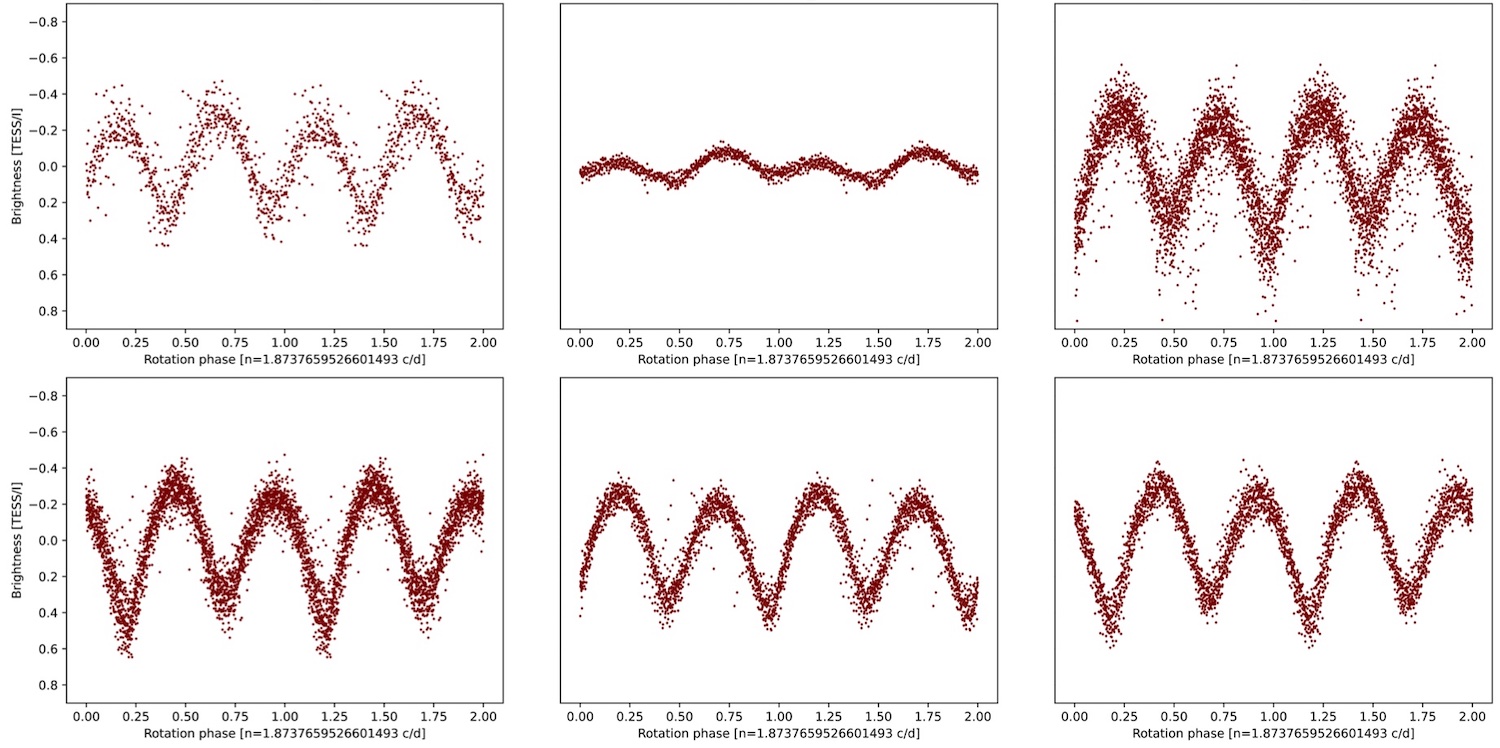
Figure 1: Light curves of the asteroid (4717) Kaneko observed in six different sectors of TESS
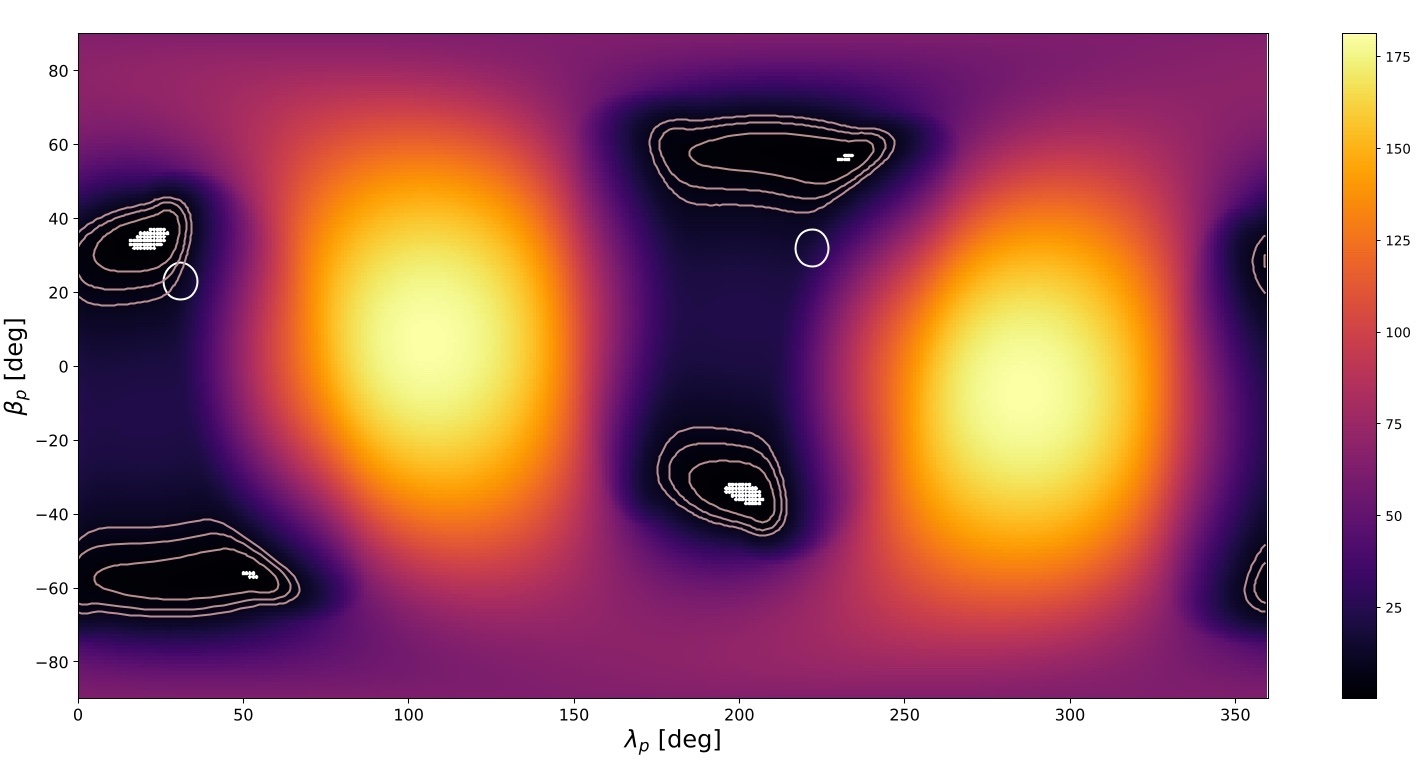
Figure 2: χ2 contours obtained from the comparision of observed and predicted light curve amplitudes for (4717) Kaneko. The lowest contours represent our best fitting spin axis solutions in ecliptic coordinates. Circles mark the spin axis solutions provided by DAMIT.
How to cite: Nóra, T., Pál, A., and Kiss, C.: Spin-axis and rotation of small bodies using multi-directional measurements of the Transiting Exoplanet Survey Satellite, Europlanet Science Congress 2022, Granada, Spain, 18–23 Sep 2022, EPSC2022-1225, https://doi.org/10.5194/epsc2022-1225, 2022.
Abstract
Until recently, only three large main belt asteroids, Ceres, Vesta and Lutetia, had been imaged with a high level of detail, as they were visited by the space missions Dawn and Rosetta of NASA and the European Space Agency, respectively. The previously small number of detailed observations of asteroids meant that, until now, key characteristics such as their 3D shape or density had remained largely unknown. Between 2017 and 2019, we have been filling this gap by conducting a high-angular-resolution imaging survey of 42 large main-belt asteroids with VLT/SPHERE (ESO large programme; PI: P. Vernazza; ID: 199.C-0074), sampling the main compositional classes. These observations have allowed to cast some light on the following fundamental questions:
– What is the diversity in shape among large asteroids and are the shapes close to equilibrium?
– How do large impacts affect asteroid shape?
– What is the bulk density of large asteroids and is there a relationship with their surface composition? Is there any evidence of differentiation among those bodies?
– Is the density of those bodies that are predicted to be implanted bodies from the outer Solar System (P/D-types) compatible with that of small (D ≤ 300 km) trans-Neptunian objects?
– What physical properties drive the formation of companions around large asteroids?
Importantly, our survey along with previous observations provides evidence in support of the possibility that some C-complex bodies could be intrinsically related to IDP-like P- and D-type asteroids, representing different layers of a same body (C: core; P/D: outer shell). We therefore propose that P/ D-types and some C-types may have the same origin in the primordial trans-Neptunian disk. The main belt would thus host a population of former TNOs much more important than the one previously considered, consisting solely of P and D-type bodies.
Here, we will present an overview of the results obtained from this survey ([1]) with a specific focus on the origin of a large fraction of the asteroid belt (typically C, P and D-type bodies).
References
[1] Vernazza, P., Ferrais, M., Jorda, L., et al. VLT/SPHERE imaging survey of the largest main-belt asteroids: Final results and synthesis. A&A 654, 2021.
How to cite: Vernazza, P., Ferrais, M., Jorda, L., Hanus, J., Carry, B., Marsset, M., Brož, M., and Fetick, R. and the HARISSA team: VLT/SPHERE imaging survey of D>100 km asteroids: Final results and synthesis, Europlanet Science Congress 2022, Granada, Spain, 18–23 Sep 2022, EPSC2022-103, https://doi.org/10.5194/epsc2022-103, 2022.
Introduction
Asteroid families generated by the collisional fragmentation of a common parent body have been identified using clustering methods of asteroids in their proper orbital element space (Broz & Morbidelli 2013; Tsirvoulis et al. 2018; Dermott et al. 2021). However, there is growing evidence that some of the real families are larger than the corresponding cluster of objects in orbital elements, as well as there are families that escaped identification from clustering methods (Milani et al. 2014). An alternative method has been developed by Bolin et al. (2017); Delbo et al. (2017), in order to identify collisional families from the correlation between the asteroid fragment sizes and their proper semimajor axis distance from the family center (V-shape). This method has been shown to be effective in the cases of the very diffused families that have formed Gyrs ago. Based on this method, a 4 Gyr-old (so-called primordial) collisional family of the inner main belt has been identified consisting of low-albedo asteroids (Delbo et al. 2017). The theory of asteroid family evolution predicts that there is an excess on retrograde asteroids in the inward side of the family’s V-shape. For this reason, photometric observations were performed in order to construct their rotational light curves and determine their shape and spin state.
Dataset and Observations
We combined data of asteroid lightcurves that we collected from the databases, sparse photometric data obtained from different surveys and existing shape models. Aiming to enlarge our input dataset used for the shape modelling, which would potentially lead to new and improved shape solutions, we performed additional ground-based photometric observations.
An international observing campaign has been initiated in the framework of our international initiative called Ancient Asteroids[1], aiming to collect dense photometric data for asteroids that belong to the oldest asteroid families (Athanasopoulos et al. 2021).
Method
The photometric datasets include both dense photometric data from ground-based facilities, as well as sparse data from several sky surveys and space missions. Appropriate analysis techniques were used for each type of dataset to extract the asteroid’s rotational light curve and use the convex inversion (CI) method developed by Kaasalainen & Torppa (2021); Kaasalainen et al. (2021). So far, the CI has been used to derive asteroid models for more than 3,460 asteroids that are stored in the DAMIT database.
Results
The spin state for 54 family members was determined by additionally using literature and sparse photometric data from ground and space observatories. Moreover, we measured rotation periods for 8 asteroids for the first time.
Combining new and literature data, we determined shapes and spin states for 54 asteroids that belong to the nominal population of the primordial family. This corresponds to 50% of the population in the sliver between the left-wing border of the Polana and the primordial family (see Fig. 1). Specifically, we calculated 23 new complete asteroid models, 16 revised and 8 new partial models, where 32 asteroids have retrograde rotation and 22 prograde.
Based on our analysis, we indicated 9 interlopers in the sample of 54 studied objects. From these 45 confirmed asteroid family members, 29 asteroids (65%) models have retrograde rotation and 16 prograde, including also the partial solutions.
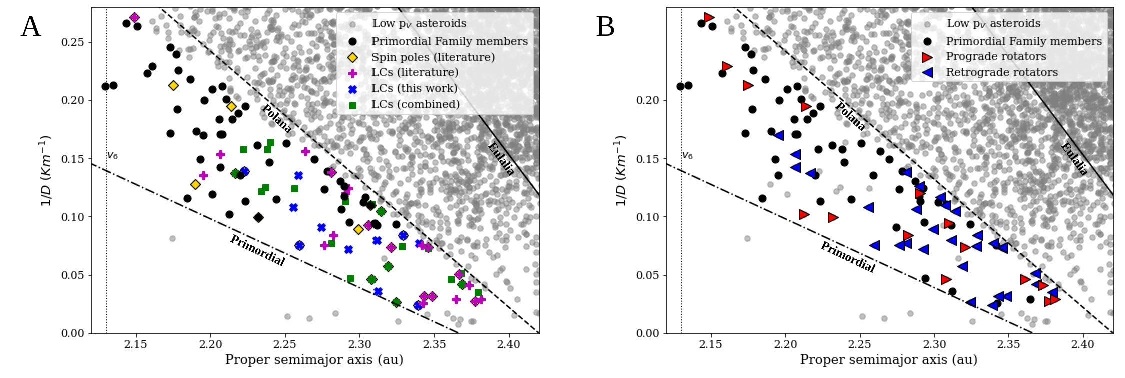
Fig. 1: Panel A: The primordial family members are presented in proper semi-major axis vs. inverse diameter plane, along with the low albedo asteroids. Yellow diamond markers present members with known spin pole from the literature. Moreover, "plus", cross and square markers show the sources of dense lightcurves for these members. Panel B: The left side of the V-shape of the primordial family, where the red markers show the retrograde and blue markers the retrograde asteroids respectively.
Conclusion
We carried out a campaign of photometric observations of those asteroids that have been claimed to be members of one of the oldest collisional (primordial) families in the Solar System and we extract the lightcurves, spin state and shape for 45 members.
The statistical predominance of the retrograde spin poles is due to a physical process, as it was claimed by Delbo et al. 2017, namely formation as collisional fragments of a common parent body, a subsequent dynamical evolution driven by the Yarkovsky effect. The results of this research constitute corroborating evidence that the asteroids as members of a 4 Gry-old collisional family have a common origin, thus strengthening their family membership.
Acknowledgments
MD and CA acknowledge support from ANR “ORIGINS” (ANR-18-CE31-0014). This work is based on data provided by the Minor Planet Physical Properties Catalogue (MP3C) of the Observatoire de la Côte d’Azur. The research of JH has been supported by the Czech Science Foundation through grant 20-08218S. The work of OP has been supported by INTER-EXCELLENCE grant LTAUSA18093 from the Ministry of Education, Youth, and Sports. Support for T.W.-S.H. was provided by NASA through the NASA Hubble Fellowship grant HST-HF2-51458.001-A awarded by the Space Telescope Science Institute (STScI), which is operated by the Association of Universities for Research in Astronomy, Inc., for NASA, under contract NAS5-26555.
We thank the Las Cumbres Observatory and their staff for its continuing support of the ASAS-SN project, supported by the Gordon and Betty Moore Foundation through grant GBMF5490 to the Ohio State University and funded in part by the Alfred P. Sloan Foundation grant G-2021-14192 and NSF grant AST-1908570. Development of ASAS-SN has been supported by NSF grant AST-0908816, the Mt. Cuba Astronomical Foundation, the Center for Cosmology and AstroParticle Physics at the Ohio State University, the Chinese Academy of Sciences South America Center for Astronomy (CAS-SACA), the Villum Foundation, and George Skestos.
References
Athanasopoulos, D. et al. 2021, in European Planetary Science Congress Vol. 15, EPSC2021–335
Bolin, B. T. et al. 2017, Icarus, 282, 290
Brož, M. & Morbidelli, A. 2013, Icarus, 223, 844
Delbo’, M. et al. 2017, Science, 357, 1026
Dermott, S. F. et al. 2021, MNRAS, 505, 1917
Kaasalainen, M. & Torppa, J. 2001, Icarus, 153, 24
Kaasalainen, M. et al. 2001, Icarus, 153, 37
Milani, A. et al. 2014, Icarus, 239, 46
Tsirvoulis, G. et al. 2018, Icarus, 304, 14
[1] http://users.uoa.gr/~kgaze/ancient_asteroids.html
Acknowledgment: DA wishes to thank the Hellenic Astronomical Society (Hel.A.S.) for a travel grant.
How to cite: Athanasopoulos, D., Hanuš, J., Avdellidou, C., Bonamico, R., Delbo, M., Conjat, M., Ferrero, A., Gazeas, K., Rivet, J.-P., Sioulas, N., and Van Belle, G. and the Ancient Asteroids team: Asteroid spin-states of a 4 Gyr-old collisional family., Europlanet Science Congress 2022, Granada, Spain, 18–23 Sep 2022, EPSC2022-949, https://doi.org/10.5194/epsc2022-949, 2022.
The Hubble Space Telescope (HST) archives hide many unexpected treasures, such as trails of asteroids, showing a characteristic curvature due to the parallax induced by the orbital motion of the spacecraft. We have explored two decades of HST data for serendipitously observed asteroid trails with a deep learning algorithm on Google Cloud, called AutoML, trained on classifications from the Hubble Asteroid Hunter (www.asteroidhunter.org) citizen science project.
The project was set up as a collaboration between the ESAC Science Data Centre, Zooniverse, and engineers at Google as a proof of concept to valorize the rich data in the ESA archives. I will present the first results from the project, finding 1,700 asteroid trails in the HST archives (Kruk et al., 2022). Their distribution on the sky is shown in Figure 1.
The majority of the asteroid trails (1,031) we found are faint (typically > 21 mag, see Figure 2) and do not match any entries in the Minor Planet Center database, thus likely correspond to previously unidentified asteroids (see a few examples in Figure 3). We will argue that a combination of AI and crowdsourcing is an efficient way of exploring increasingly large datasets by taking full advantage of the intuition of the human brain and the processing power of machines.
The second part of this project aims to analyze in detail these potentially new asteroids and use them to improve our current understanding of the size distribution of small-sized asteroids, and thus help constrain models of the evolution of our Solar System.
Taking into account Hubble’s motion around the Earth, the parallax effect can be computed to obtain the distance to the asteroids by fitting simulated trajectories to the observed trails and obtaining the best fit (Evans et al. 1998). We show one example of a curve fit to the observed trail in Figure 4. Once we know the distance to the asteroids, we are able to obtain their absolute magnitudes and, combined with an assumed albedo, we can obtain their sizes. This method is also able to estimate an envelope for the asteroid's main orbital parameters.
Given Hubble’s resolution and capability of reaching faint magnitudes, we expect that many of the new asteroids to be small-sized Main Belt asteroids (diameter <1 km), a population that is too faint and thus difficult to image from ground-based observatories. In addition, with the typical 30 min exposures of Hubble, some of these unknown objects show lightcurves that could be used to infer the rotation and shape of these asteroids, which is helpful for better assessing their type and origin.
This project may serve in the future as a “proof of concept” for an automated detection and analysis pipeline in large astronomical archives or surveys.
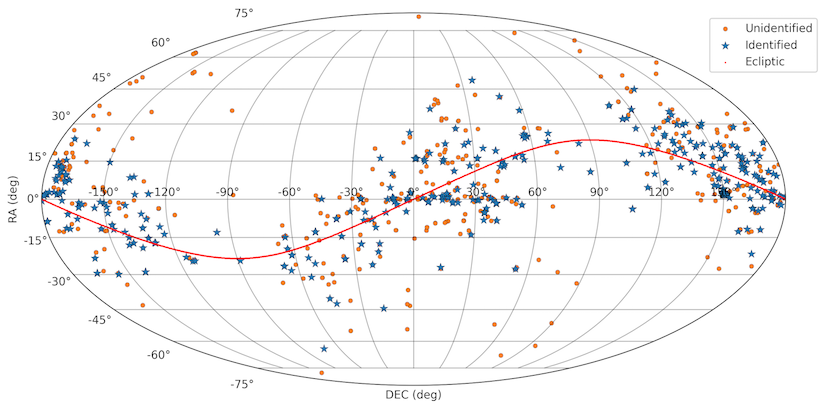
Figure 1: Distribution on the sky of the Solar System Objects (SSOs) identified in the HST images in Mollweide projection. The blue stars show the identified, known asteroids. The orange circles show the location of objects for which we did not find any associations with SSOs. The ecliptic is shown with red. The two gaps in this plot correspond to the Galactic plane, which was not observed by HST.
Figure 2: Distribution of apparent magnitudes for the SSOs identified in the HST images. The measured magnitudes for the identified objects (blue bars) and for the objects for which we did not find any associations with known SSOs (orange bars).
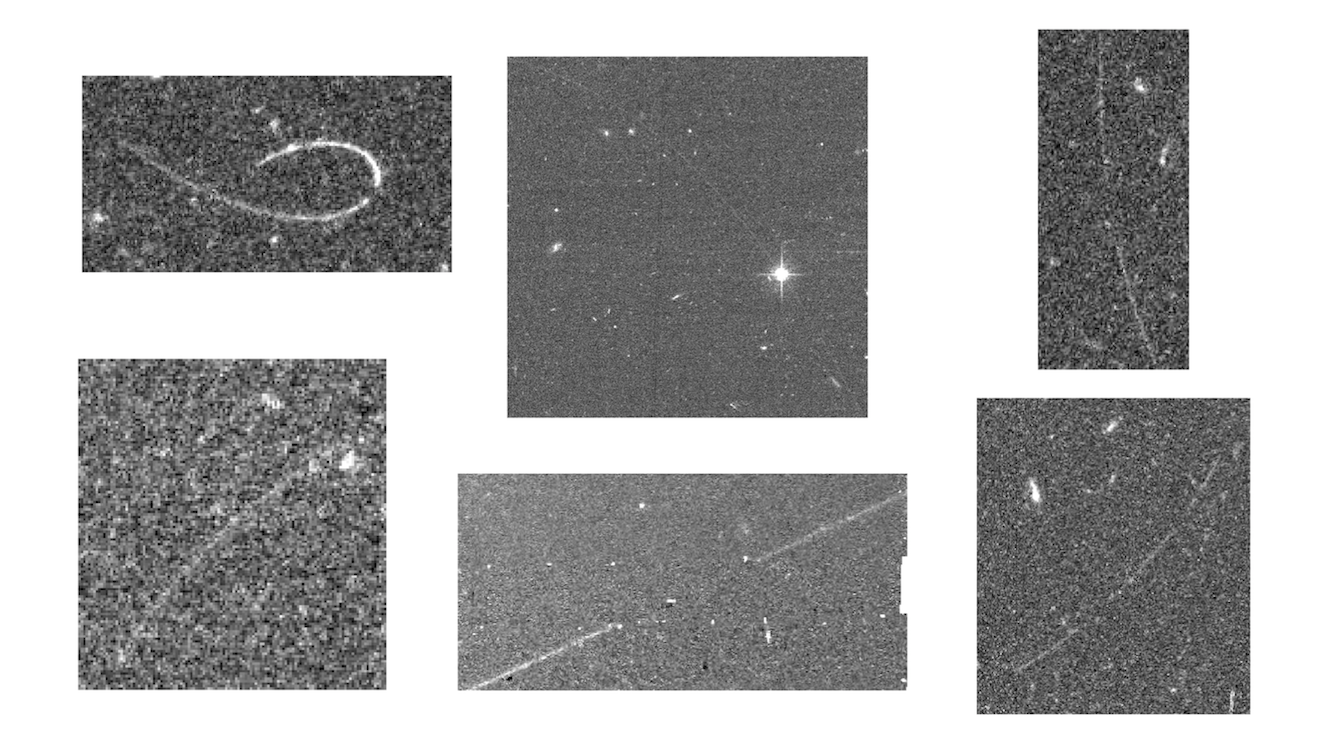
Figure 3: Examples of unidentified trails in HST observations. The HST observation IDs, clockwise, from the top left, are: j8pv03020, jds47w010, j9bk75010, icphg2010, jdrz23010, and jcng06010.
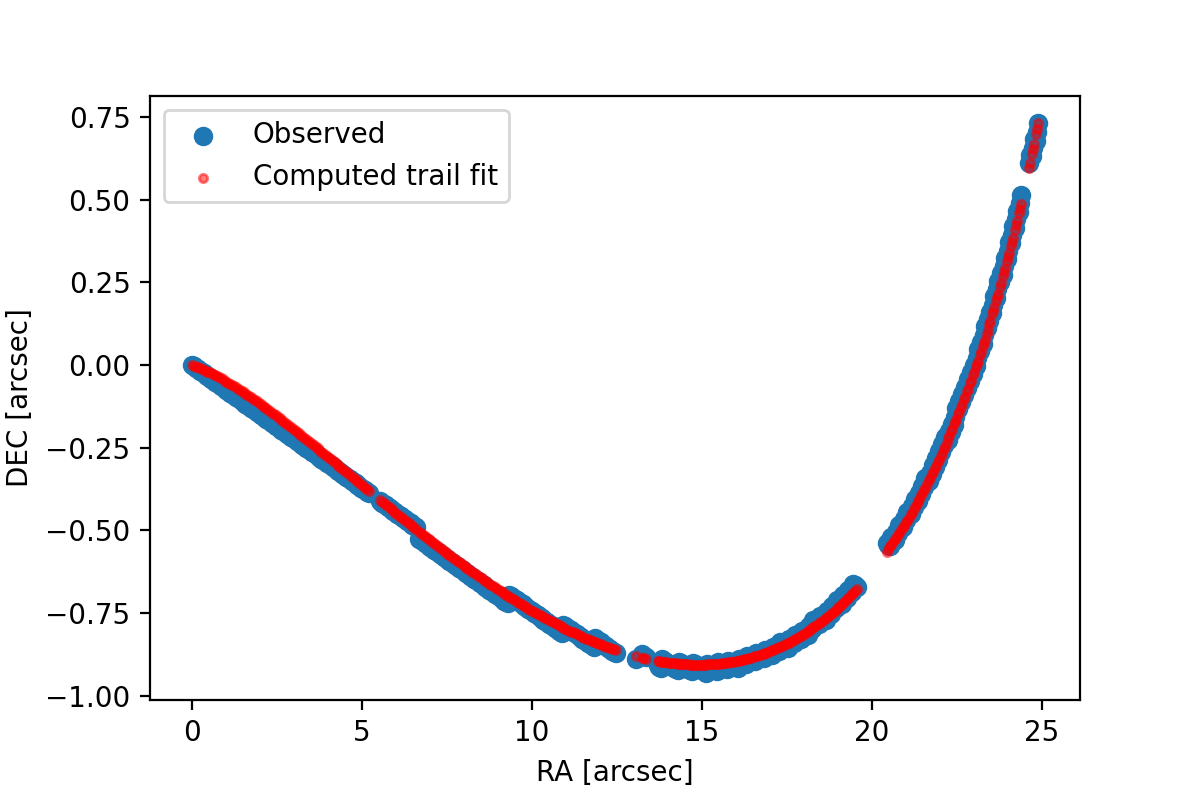
Figure 4: A trail fitting example using the parallax method. The distance solution yielding the best fit for a simulated parallax using HST trajectory is shown in red, in blue the observed trail.
How to cite: García Martín, P., Kruk, S., Popescu, M., Merín, B., Mahlke, M., Carry, B., Thomson, R., Karadag, S., Racero, E., Giordano, F., Baines, D., Durán, J., de Marchi, G., Laureijs, R., Stapelfeldt, K. R., and Evans, R. W.: Hubble Asteroid Hunter: Identifying asteroid trails in Hubble Space Telescope images, Europlanet Science Congress 2022, Granada, Spain, 18–23 Sep 2022, EPSC2022-1030, https://doi.org/10.5194/epsc2022-1030, 2022.
Orals: Wed, 21 Sep, 10:00–17:00 | Room Albéniz+Machuca
Introduction
The near-Earth asteroid (NEA) 2021 PH27 was discovered in August 2021. It belongs to the very rare group of Atira objects which stay always within the Earth’s perihelion [1]. Its orbit has a semi-major axis of 0.46 au, an eccentricity of 0.71, and an inclination of 31.9◦ , with an orbital period of less than 115 days. At perihelion (at 0.13 au) it reaches temperatures above 1000 K and it moves with about 106 km/s with a relativistic perihelion shift of 42.9"/century, 1.6 times that of Mercury. It is therefore an important reference object to understand the interplay between non-gravitational forces, general relativity effects, orbital changes due to the von Zeipel-Lidov-Kozai mechanism [2]. A recent study [3] claims that 2021 PH27 might be an active asteroid which could then produce observable meteor showers on Venus.
The object has an estimated absolute magnitude of 17.8 mag, corresponding to a size range between 0.7 km (high albedo of 0.25) and 2.6 km (radar-based albedo of 0.02 for Atira). Currently, there are 28 Atira (or Apohele) objects known (https://en.wikipedia.org/wiki/Atira_asteroid). Atira objects never cross the Earth’s orbit and there is no impact risk right now. However, they have frequent close encounters with Mercury and Venus which could eventually push an Atira-orbit into an Earth-crossing orbit [2].
The Atira objects represent a part of our Solar System which is poorly known. The few known ones are considered as the ”tip of the iceberg” of a likely numerous population of similar objects which are still undiscovered due to the difficulty to observe so close to the Sun [4]. There are indications that their orbits are the result of gravitational interactions with the Earth-Moon system, Jupiter and Venus [4], but their origin remains an open question [5]. Also, non-gravitational forces, like Yarkovsky and YORP, are expected to play a strong role for long-term orbital evolution [6], for the spin behaviour [7], and possibly also for the shape of these bodies [8].
Observations
In preparation for the challenging VLT-VISIR observations (fast-moving NEA, at high airmass, in twilight), we made astrometric measurements to improve the orbit solution. At the beginning of April 2022, the positional uncertainty reached values below one arcsecond (plane-of-sky 3-σ error).
We observed the thermal emission of 2021 PH27 with VISIR before opposition in April 2022 (leading the Sun), after-opposition measurements (trailing the Sun) are planned for July 2022. In both cases, the object is in a ”half-Moon” configuration (about -90◦ and +70◦ phase angle, respectively). Such measurements guarantee that we see once a warm terminator, and once a cold terminator (see Fig. 1). This allows us to determine the asteroid’s sense of rotation, its size and albedo, and to constrain the thermal properties of its surface. This is especially interesting for an asteroid which is frequently heated up to more than 1000 K (e.g. during perihelion in late May 2022 inbetween our VISIR observations). It is expected that the high temperatures have an influence on the surface properties (hence, the thermal inertia) by thermally breaking the solid rock due to very steep temperature gradients between illuminated and shadowed parts of the surface [9].This could also lead to sporadic activity [3].
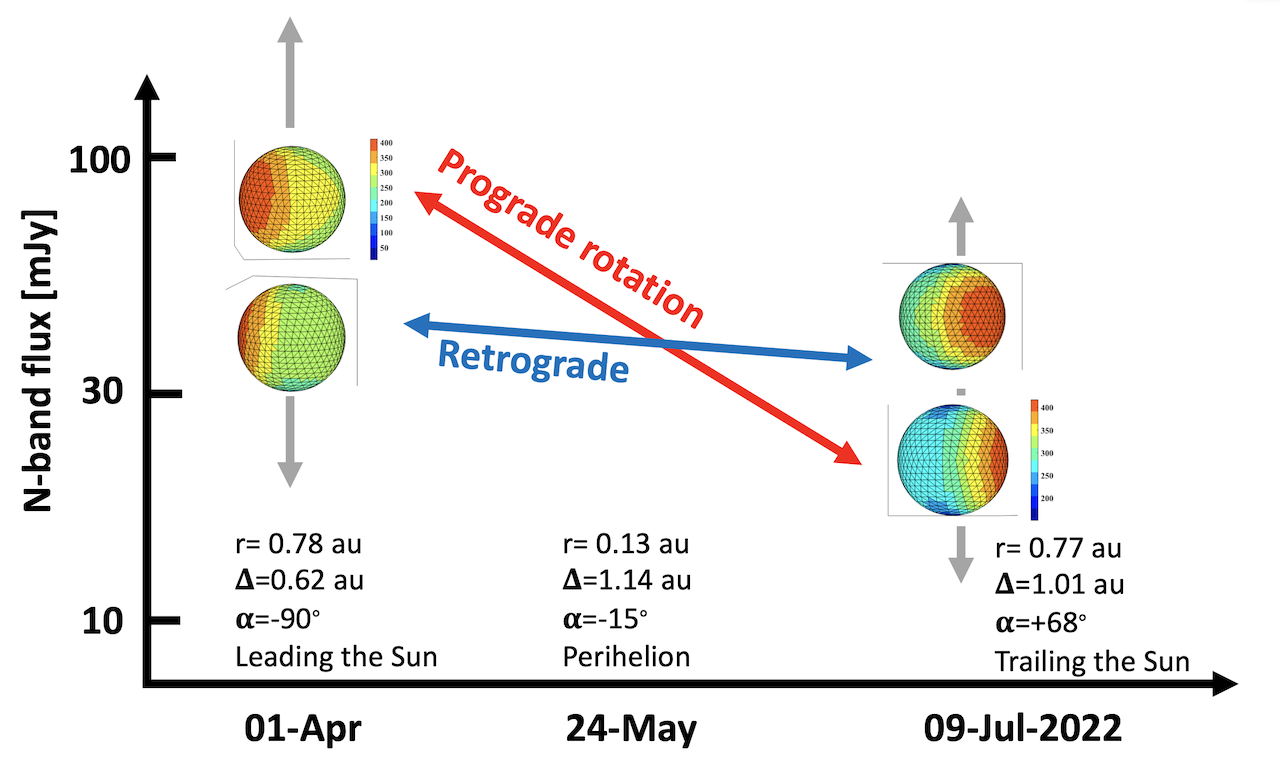
Fig. 1: Temperature and flux prediction for 2021 PH27 for our thermal observations in early April and mid July 2022. The calculations assume an object albedo of 0.1 (corresponding to a size of about 1.1 km) and a thermal inertia of 500 Jm−2 K−1s−0.5.
Our measurements are the first thermal detections of an Atira family member. We also conducted visible lightcurve measurements in Feb, Mar, and Apr 2022, to establish the object’s rotation period and shape properties, and to determine the H-magnitude. The VISIR measurements can be rotationally phased to derive a good-quality size and albedo solution (see e.g., [10,11], and references therein), and to put constraints on its physical shape via well-established thermophysical model techniques [12].
Results
The pair of before/after opposition measurements allows us to determine the objects sense of rotation (prograde or retrograde) [13] which is important to calculate the non-gravitational Yarkovsky force [6], and to look into possible orbital evolution processes which might slowly push this object into the category of potentially hazardous objects [14]. Finding a good model solution for the measurements taken in both VISIR runs also means to constrain the thermal properties of the surface. A high thermal inertia (connected to a rocky or bare-rock surface) will carry substantial heat from the illuminated into the non-illuminated part of the surface (large before/after opposition asymmetry, see Fig. 1). A low thermal inertia (like for our Moon) leads to almost instantaneous thermal equilibrium and would point to a fine-grain regolith with very low conductivity.
The VISIR measurements of 2021 PH27 are the foundation for the characterization of the entire Atira family, for the study of repeated extremely high surface temperatures, and for exploring the largely unknown terrains of poorly detectable NEAs inside the Earth’s orbit. The physical properties of 2021 PH27 are also relevant in the context of disentangling non-gravitational from relativistic orbit effects.
References
1. Ribeiro, A. O., et al. (2016), MNRAS, 458, 4471 – 2. de la Fuente Marcos, C. & R. de la Fuente Marcos (2021), Res. Notes AAS 5, 205 – 3. Carbognani, A, Tanga, P., Bernardi, F. (2022), MNRAS 511, L40-L44 – 4. de la Fuente Marcos, C. & R. de la Fuente Marcos (2019),MNRAS, 487, 2742 – 5. Greenstreet, S., H. Ngo, & B. Gladman (2010), DPS, 42, 13.09 – 6. Bottke, W. F., et al. (2006), AREPS, 34, 157 – 7. Rubincam, D. P. (2000), Icar, 148, 2 – 8. Hirabayashi, M., et al. (2020), Icar, 352, 113946 – 9. Delbo, M., et al. (2014), Natur, 508, 233 – 10. Müller, T., et al. (2017), A&A, 598, A63 – 11. Delbo, M., et al. (2015), aste.book, 107 – 12. Müller, T., et al. (2017),, A&A, 599, A103 – 13. Müller, T. (2002), M&PS, 37, 1919 – 14. La Spina, A., et al. (2004), Natur, 428, 400.
How to cite: Müller, T., Santana-Ros, T., Micheli, M., and Pantin, E.: No one gets closer to the Sun: Thermophysical properties of Atira object 2021 PH27, Europlanet Science Congress 2022, Granada, Spain, 18–23 Sep 2022, EPSC2022-524, https://doi.org/10.5194/epsc2022-524, 2022.
Introduction
The near-Earth asteroid (153201) 2000 WO107 was selected as an M-asteroid candidate based on its known albedo value pv = 0.129 ± 0.058 [1] and the taxonomic X-type determined from spectral observations [2]. The ambiguous spectral X-type suggests one of the three E-, P-, or M-types, but in this case, given the known albedo, the asteroid is most consistent with an M-type. It has a significantly elongated orbit with e = 0.781, which crosses the orbits of all major inner planets, enters the orbit of Mercury, and approaches the Sun at a distance of q = 0.20 AU. The asteroid has a small size of about 0.5 km and is available for observation only during close approaches to the Earth.
We initiated photometric observations of 2000 WO107 in the 2020 opposition aimed to obtain rotation parameters and estimate its shape and bulk density.
Observations
We carried out photometric observations of (153201) 2000 WO107 in November-December 2020, when the asteroid passed at a minimum distance of 0.029 AU from the Earth. Our observations were made in a coordinated manner at five observatories: the 1-m telescope of the Crimean Astrophysical Observatory, the 70-cm telescope of Abastumani Observatory, the 61-cm telescope of Skalnaté Pleso Observatory, the 36-cm telescope of Kitab Observatory, and the 0.25-m BART telescope of the Roque de los Muchachos Observatory. The observations covered the time interval from Nov. 28 to Dec. 9, 2020, and were done using CCD cameras in R-filter and, moreover, in Kitab without a filter. In addition, the asteroid was also observed in BVI filters on some nights. The measured lightcurves showed a very high amplitude (up to 1.24 mag at the phase angles of 65-70 deg) and made it possible to determine the rotation period of 5.03 hrs (Fig.1). Such a high amplitude characterizes the body of the asteroid as very elongated and possibly binary. Note the unusual flat minima are seen in the light curve. They are a characteristic manifestation of incomplete illumination of an asteroid at large phase angles for synchronous, as well as very elongated bodies of a nonconvex shape. It means that the asteroid is either a binary or a contact binary.
Our assumptions are confirmed by radar observations carried out using the 70-m antenna at the Goldstone Observatory in the same opposition with our observations, which showed that the asteroid is a contact binary with a larger elongated primary component and a smaller secondary close to the sphere [3]. Moreover, the smaller body is attached to the end of the longest axis of the larger body.
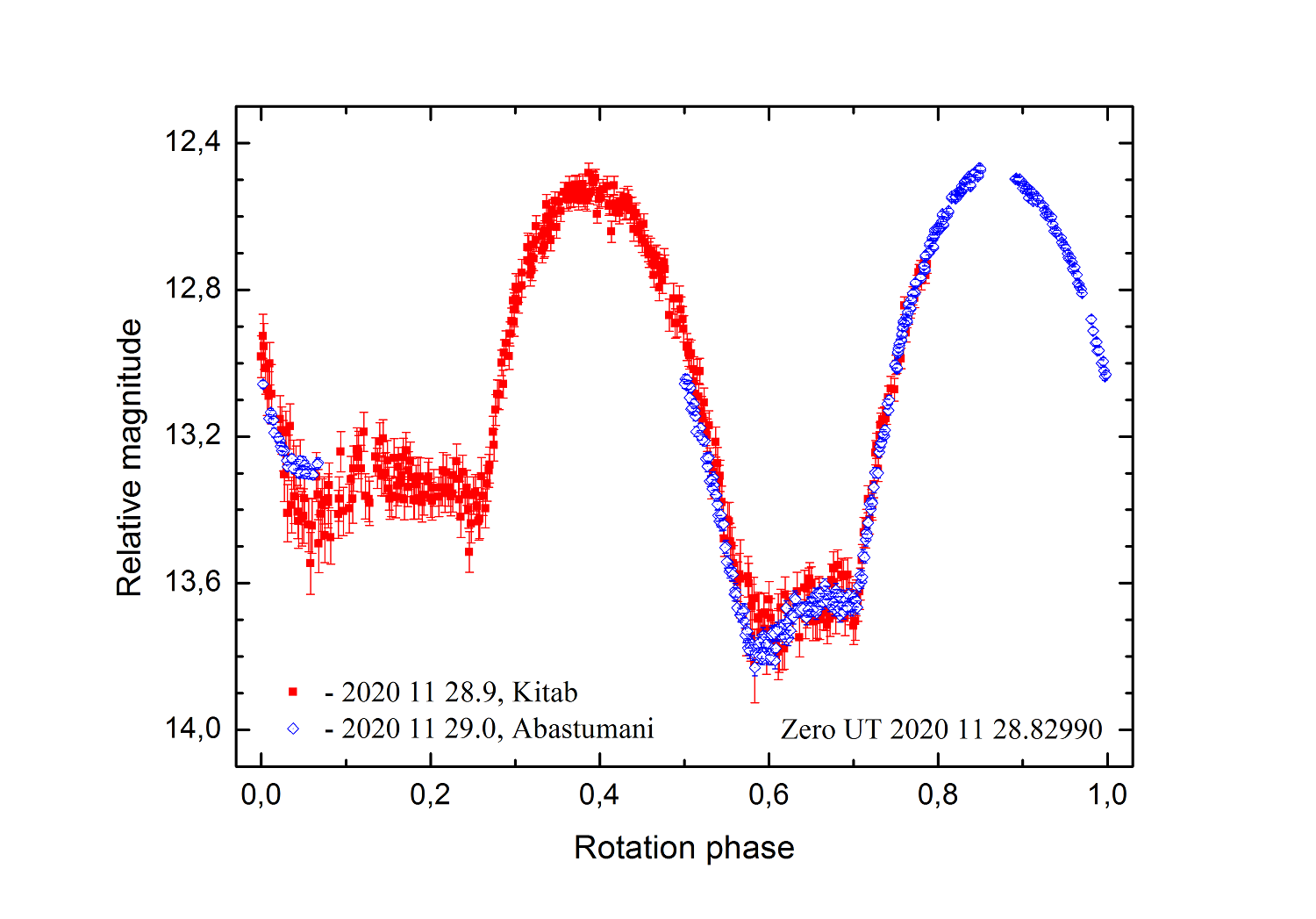
Figure 1. The composite light curve obtained from observational data on the night of November 28–29 during the passage of an asteroid at a minimum distance from the Earth.
Modelling
We simulated the scattering of light and radio waves from a bi-lobal asteroid in the assumption of two contacting ellipsoids. The axes of the two ellipsoids, the distance between their centers, the orientation of the rotation axis, the initial rotation phase and the period were used as fitting parameters in a Markov chain Monte Carlo (MCMC) algorithm. The resulted shape model fits well both the optical lightcurves and delay–Doppler images of 2000 WO107 obtained by Goldstone on Nov. 28, 29 and 30, 2020. We estimate the density of 1.5 g/cm3 from the requirement that the resulting shape of the asteroid is mechanically stable.
An independent estimate of the asteroid density can be obtained from its Yarkovsky effect. Greenberg et al. (2020) analyzed measured positions for 2000 WO107 and found the Yarkovsky drift rate to be −24.37 ± 12.7 AU/My [4]. We simulated the Yarkovsky effect of a bi-lobal asteroid using the shape and size of the asteroid obtained from our modelling. Thus, we calculated the theoretical value of the Yarkovsky force acting on this asteroid. By comparing the theoretical Yarkovsky force with the observed Yarkovsky drift rate, we estimated the density of 2000 WO107. Within the error margin, the obtained value agrees with the density determined from the shape modeling.
Conclusions
Combination of photometric and radar data allows us to determine the rotation period and the position of the asteroid's pole, to predict its shape and size, and to measure the asteroid's density.
The resulted density of the near-Earth asteroid (153201) 2000 WO107 is rather low, which implies the asteroid has a predominantly non-metallic composition and most probably belongs to primitive asteroids.
Acknowledgment
Ukrainian team was supported by the National Research Foundation of Ukraine (grant No. 2020.02/0371 “Metallic asteroids: search for parent bodies of iron meteorites, sources of extraterrestrial resources”). The authors are thankful to A. Novichonok and A. Zhornichenko for their help with observations.
References
[1] Mainzer, A., Grav, T., Bauer, J. et al. 2011. Astron. J. 743, Art. 156
[2] Binzel, R. P., Rivkin, A. S., Stuart, J. S., et al. 2004. Icarus 170, 259–294
[3] Benner, L. A. M. Goldstone Radar Observations Planning: (7753) 1988 XB, 2017 WJ16, and 2000 WO107. NASA JPL database “Asteroid Radar Research”. https://echo.jpl.nasa.gov/asteroids/1988XB/1988xb.2020.goldstone.planning.html
[4] Greenberg, A.H., Margot, J.-L., Verma, A.K., Taylor, P.A., Hodge, S.E. 2020. Astron. J. 159, 92
How to cite: Krugly, Y., Mykhailova, S., Golubov, O., Lipatova, V., Inasaridze, R., Ayvazian, V., Kapanadze, G., Datashvili, D., Ehgamberdiev, S., Ivanova, O., Husárik, M., Karpov, S., Slyusarev, I., and Belskaya, I.: Physical characterization of the potentially hazardous contact-binary asteroid (153201) 2000 WO107, Europlanet Science Congress 2022, Granada, Spain, 18–23 Sep 2022, EPSC2022-1150, https://doi.org/10.5194/epsc2022-1150, 2022.
Abstract
The tangential YORP effect (or TYORP) is a radiation pressure torque, which acts on small irregularities of the asteroid surface due to their non-uniform heating. This effect causes asteroids to change their rotation rates, and in many cases, it can be larger than other non-gravitational torques. Other works have already considered TYORP produced by smooth boulders of different shapes on an asteroid's surface. Here, we present the new results on the contribution to TYORP due to the small-scale roughness on the surface of boulders or regolith. We carry out numeric simulations of the 2D heat conduction problem on a sinusoidal surface, average the radiation pressure force in time and space, and thus numerically find the TYORP experienced by the asteroid surface. We also create an approximate analytic theory of heat conduction on a slightly non-flat sinusoidal surface and use it to compute TYORP. We study the small-scale roughness of asteroid Ryugu published in other works and use it to evaluate its TYORP. As a result, we find that the numeric and analytic estimates of the tangential YORP produced by a rough surface are in good qualitative agreement with each other. The contribution of different sinusoidal harmonics to the tangential YORP is additive to good accuracy. It allows us to derive an approximate analytic formula, which expresses TYORP in terms of the Fourier spectrum of the shape of the asteroid surface. The TYORP contribution of the small-scale roughness can be comparable to or even greater than TYORP produced by boulders.
Introduction
The tangential Yarkovsky–O'Keefe–Radzievskii–Paddack effect (also tangential YORP, or TYORP) is caused by the recoil light pressure and drags the asteroid’s surface in the tangential direction [1]. It has previously been simulated for different geometries of smooth boulders [2, 3, 4]. Here, we study the contribution to TYORP arising from the roughness of the asteroid surface on a centimeter-scale, including both non-smoothness of the rocks and the non-flatness of the regolith. We present the recent analytic results from [5] and as yet unpublished results of the numeric simulation of the effect.
Analytic model
We use the perturbation theory to solve the heat conduction equation for a surface whose shape is described by a sinusoidal wave of small amplitude. The resulting temperature is used to compute the light pressure recoil force acting on the surface and thus to evaluate TYORP.
The expression for TYORP is second-order in terms of the surface slopes, thus it gets vanishingly small if the surface is nearly flat. TYORP of surface roughness has other features previously observed for TYORP of boulders: it vanishes at very small and very big thermal parameters, it vanishes for very short and very long wavelengths of the sinusoidal perturbation of the surface, it is maximal if the thermal parameter is of the order of unity and the wavelength of the sinusoidal perturbation is of the order of the thermal wavelength.
As a qualitative result of this approximate analytic theory, we also obtain that sinusoidal waves with non-commensurable wavelengths do not interfere with each other, and their TYORP is additive.
Numeric model
We create a computer program that numerically solves the 2D heat conduction equation under the curved surface, and uses the resulting temperature field to compute TYORP. The results of the program qualitatively agree with the analytic model, but differ in exact numeric values due to simplifying assumptions incorporated into the analytic model. We fit the numeric results with an analytic expression and thus get an equation for TYORP as simple as our analytic theory, but more precise than it.
Numeric simulations of TYORP for a surface composed of two sinusoidal harmonics show that different harmonics are almost independent, with the TYORP of a surface being almost equal to the TYORP of individual harmonics.
Results
To apply the theory, we take the high-resolution shape model of asteroid (162173) Ryugu from [6] and decompose its shape into the Fourier harmonics. The additivity of TYORP for different Fourier harmonics tested both analytically and numerically allows us to derive a simple mathematical expression for TYORP as an integral over the Fourier power spectrum of the asteroid surface roughness. Application of this expression to Ryugu results in a TYORP value that is greater than the YORP effect due to the large-scale asymmetry of Ryugu computed from its global shape model [7].
Overall, TYORP produced by the asteroid surface roughness has the same order of magnitude as TYORP produced by boulders. This new component of the YORP effect needs to be computed to correctly predict the dynamics of asteroids, and here we show how this computation can be done.
Acknowledgments
This work was supported by the National Research Foundation of Ukraine, project N2020.02/0371 “Metallic asteroids: search for parent bodies of iron meteorites, sources of extraterrestrial resources”.
References
[1] Golubov O., Krugly Y. N., 2012, ApJL 752, L11
[2] Golubov O., Scheeres D. J., Krugly Y. N., 2014, AJ 794, 22
[3] Sevecek P., Broz M., Capek D., Durech J., 2015, MNRAS 450, 2104
[4] Sevecek P., Golubov O., Scheeres D. J., Krugly Y. N., 2016, A&A 592, A115
[5] Golubov O., Lipatova V., A&A, accepted
[6] Otto K. A., Matz K. D., Schröder S. E., et al., 2021, MNRAS 500, 3178
[7] Kanamaru M., Sasaki S., Morota T., et al., 2021, Journal of Geophysical Research: Planets 126, e2021JE006863.
How to cite: Golubov, O. and Lipatova, V.: A new component of the tangential YORP caused by the roughness of the asteroid surface, Europlanet Science Congress 2022, Granada, Spain, 18–23 Sep 2022, EPSC2022-734, https://doi.org/10.5194/epsc2022-734, 2022.
Introduction
2022 AB is a very small near-Earth asteroid that passed Earth at a distance of 9.6 lunar distances on 20 January.
Our campaign started on 4 January and until 26 January, we observed 2022 AB using telescopes located in many places around the world. More about the campaign, including the determination of the phase curve, will be presented during this conference in a separate presentation [2]. Here we only present results regarding the colour indices, taxonomic class, and diameter. We organised a similar observation campaign for 2021 DW1 in 2021 [3][4][5].
Rotation period
In determining the colours indices, it is very important to know the rotation period of the asteroid. We discussed the issues, especially in the field of NEAs, at the conference last year [5].
We briefly discuss the determination of the rotation period using an example of observations from the first night of the campaign of 2022 AB. More will be discussed in [2].
We used a 0.7-m RBT/PST2 telescope(Arizona), 5-s exposures, and the clear filter. We observed object for 1.5 hours and we create composite lightcurve with Fourier series fit (see Figure 1). In this way, we determined the rotation period P=182 s.
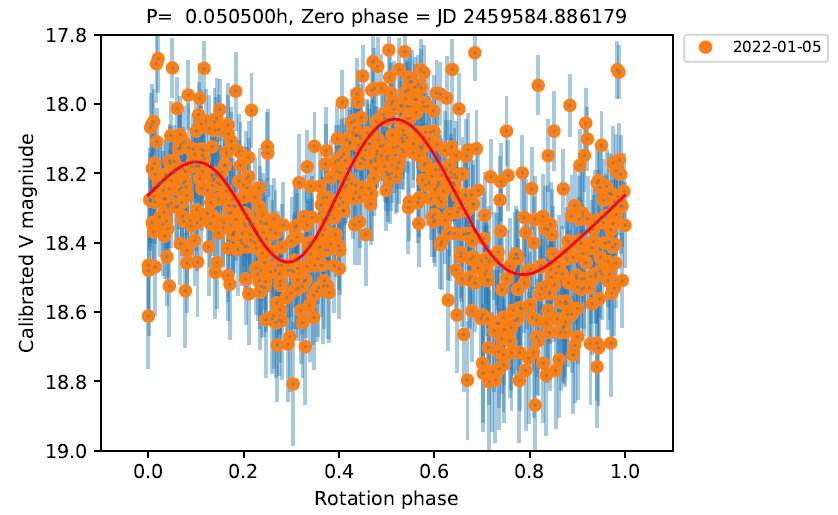
Figure 1: Example of composite lightcurve of 2022 AB.
Colour indices
The preliminary results presented here are based on most of the data obtained. The full results will be presented during the conference.
To determine the colour indices, we used observations from three telescopes: 0.7-m RBT, 1-m telescope of DOAO (South Korea), and 1-m telescope of Pic du Midi Observatory (France). Telescopes from DOAO and Pic du Midi observed the asteroid with an exposure time of several seconds in the B,V,R,I (DOAO) or g’,r’,i’,z’ (Pic du Midi) filters. Due to changes in the geometry of the observations, we divided the observations into several sets. Using solar analogues, we transformed the brightness in B,V,R,I into g’,r’,i’,z’ bands, respectively. Then, knowing the rotation period, we composited the lightcurves to determine the shifts between the lightcurves in the given bands. We have prepared the composited lightcurves separately for each set. An example is shown in Figure 2. RBT observations were made in B,V,R filters and, as we mentioned, transformed them into g’,r’,i’. In this case, we used knowledge of the rotation period to average the brightness measurements over the period, exposure time Texp=P=182s. Adjacent measurements in different bands allowed us to determine a series of colour indices that we averaged as one set. The results for each set are shown in Table 1.
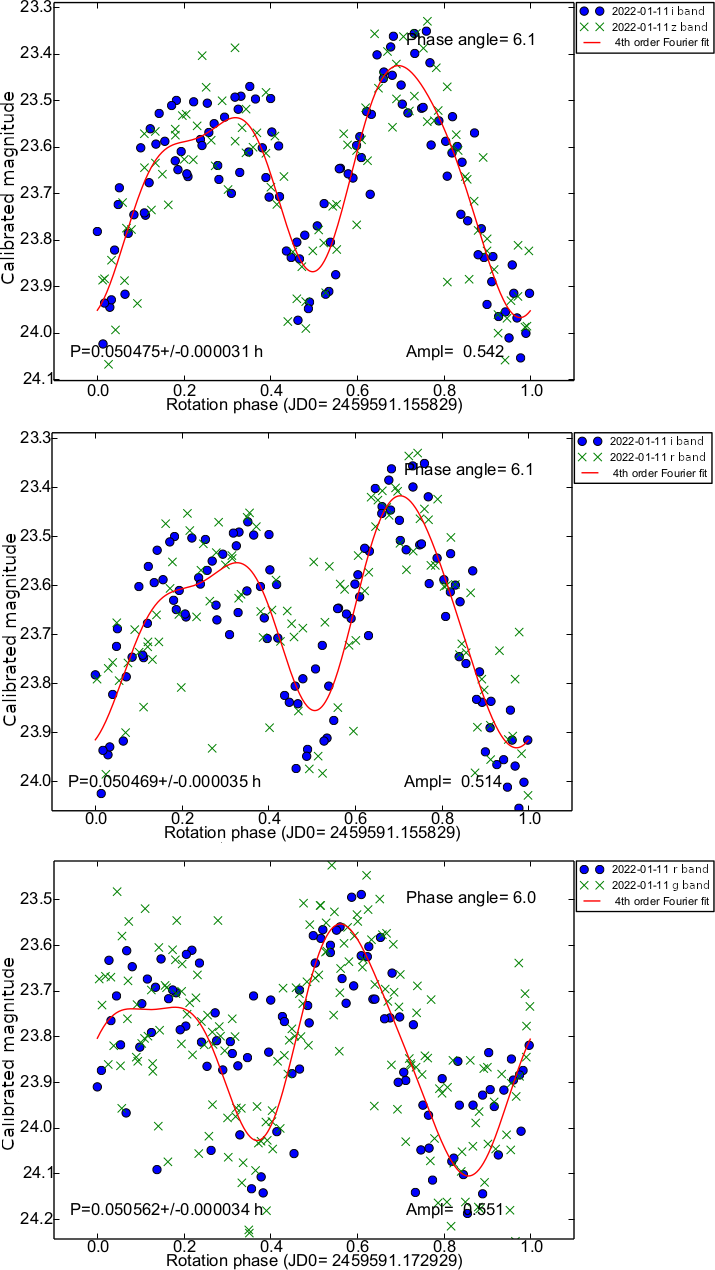
Figure 2: Composite lightcurves for DOAO set 1. Top: lightcurves in i’ (dots) and z’ band (crosses), middle: i’ and (dots) and r’ (crosses) bands, bottom: r’ (dots) and g’ (cross) bands.
Table 1: Preliminary results of colour indices for each set.
Taxonomy
To determine the taxonomic class of 2022 AB, we converted the average value of colour indices to the reflection coefficients Rr,Ri and Rz, normalised to the reflection values in the g band, using the formula [6]:
Rf=10−0.4[(f−g)−(f☉−g☉)]
Next, we compared them with spectra of different taxonomic classes, as given by [6]. In Figure 3 we present the reflective value of the asteroid compared to similar taxonomic classes. B class asteroids are rare and they are mainly associated with the outer main belt. 2022 AB as an NEA is an unlikely class B asteroid. The Cb class fits well with the data of 2022 AB and is the only one to show the common with 2022 AB characteristic of visible absorption around 0.6 micrometre. We suggest that 2022 AB is most likely a type Cb asteroid.
Figure 3: Plot of reflectivities values of B,Cb,Ch asteroid classes (black dots) and 2022 AB (red dots). Data for the B,Cb, and Ch classes were taken from [6].
Diameter
We can determine the diameter knowing the absolute magnitude H and the albedo pV according to equation [7]:
Deff=1329×10−H/5×pV−0.5
At the conference, we will present the results based on the determined H from the phase curve, but for now we used the approximate H=23.6±0.36 given by JPL[1]. Albedo for Cb class asteroids: pV=0.059±0.027 [8], hence Deff=0.104±0.029 km.
Figure 4: Rotation period-diameter plot. The red dotted line is the spin barrier (2.2 h). Other asteroid data come from LCDB [8].
Acknowledgements
This research was funded in whole or in part by the National Science Centre, Poland, grant No. 2021/41/N/ST9/04259.
References
[1] https://ssd.jpl.nasa.gov
[2] Kwiatkowski et al. (2022) Photometry and model of near-Earth asteroid 2022 AB from one apparition,EPSC 2022, held 18–23 September 2022 in Granada, Spain
[3] Kwiatkowski et al. (2021) A&A 656, A126
[4] Kwiatkowski et al. (2021) Photometry and model of near-Earth asteroid 2021 DW1 from one apparition, EPSC 2021, held virtually, 13-24 September 2021
[5] Koleńczuk et al. (2021) Determination of colour indices of super-fast rotator near-Earth asteroids, EPSC 2021, held virtually, 13-24 September 2021
[6] DeMeo & Carry (2013), Icarus 226, 723
[7] Fowler and Chillemi (1992) Phillips Laboratory, Hanscom AF Base, MA, 17–43
[8] Warner et al. (2009) Icarus 202, 134
How to cite: Koleńczuk, P., Kwiatkowski, T., Kamińska, M., Kamiński, K., Colas, F., Klotz, A., Kim, T., and Birlan, M.: Colours and taxonomy of 2022 AB: a super fast rotating near-Earth asteroid, Europlanet Science Congress 2022, Granada, Spain, 18–23 Sep 2022, EPSC2022-1161, https://doi.org/10.5194/epsc2022-1161, 2022.
Context
(121) Hermione is a large binary asteroid [1] located at the outer edge of the asteroid belt in the Cybele region, where asteroids are thought to be linked to the outer Solar System. Hermione has a Ch/Cgh-type that has been linked to CM chondrites. Adaptive optics observations between 2003 and 2008 suggest a rare bilobate shape for the primary [2,3]. However, Hermione’s shape and bulk density (ranging between 1.4 and 2 g.cm-3) remain poorly constrained to this day.
Aim
We acquired spatially resolved images and optical lightcurves of Hermione during its close apparition of September 2021. It was the best chance in 13 years to acquire such high angular resolution images (angular diameter = 0.14”). We aimed to constrain Hermione’s 3D shape, hence its volume, and the orbit of its satellite, hence the mass of the system. Combining the volume and the mass allows to constrain the bulk density with high accuracy.
Methods
We obtained 8 series of 5 images with the SPHERE/ZIMPOL instrument on the Very Large Telescope (ESO Program ID 107.22UT.001; PI: P. Vernazza). These images were combined with optical lightcurves and stellar occultations by the ADAM and MPCD methods [4,5] to reconstruct the asteroid’s 3D shape. For the determination of the satellite’s orbit, we complemented the SPHERE images with a compilation of archival data from other large ground-based AO instruments (KeckII/NIRC2, ESO/VLT/NACO and Gemini-North/NIRI). Then, we used the meta-heuristic algorithm Genoid [6] to accurately determine the orbital elements.
Results
The determined volume and mass of Hermione yield a new higher bulk density of ~1.7 g.cm-3, more compatible with its Ch/Cgh classification. We will also present our analyse of the shape and compare it with other elongated Ch/Cgh asteroids.
Bibliography
[1] Merline et al. (2002), IAU Circ. 7980
[2] Marchis et al. (2005), Icarus, 178, 2, p. 450-464
[3] Descamps et al. (2009), Icarus, 203, 1, p. 88-101
[4] Viikinkoski, M., Kaasalainen, M., & Durech, J. (2015), A&A, 576, A8
[5] Capanna, C., Gesquière, G., Jorda, L., Lamy, P., & Vibert, D. (2013), The Visual Computer, 29, 825
[6] Vachier, F., Berthier, J. and Marchis, F. (2012), A&1, 543, A68
How to cite: Ferrais, M., Vernazza, P., Marsset, M., Jorda, L., Carry, B., Hanus, J., Brož, M., Yang, B., Fétick, R., Marchis, F., Vachier, F., Birlan, M., Jehin, E., Podlewska-Gaca, E., Bartczak, P., Fusco, T., and Dudziński, G.: Constraining the shape and density of binary asteroid (121) Hermione, Europlanet Science Congress 2022, Granada, Spain, 18–23 Sep 2022, EPSC2022-395, https://doi.org/10.5194/epsc2022-395, 2022.
The work of JH and JD has been supported by the Czech Science Foundation through grant 20-08218S. The work of DV has been supported by the Czech Science Foundation through grant 21-11058S. The work of OP has been supported by INTER-EXCELLENCE grant LTAUSA18093 from the Ministry of Education, Youth, and Sports.
[2] Marzari, F., Scholl, H., Murray, C., & Lagerkvist, C. 2002, in Asteroids III, ed. W. F. Bottke, A. Cellino, P. Paolicchi, & R. P. Binzel, 725–738
[3] Morbidelli, A., Levison, H. F., Tsiganis, K., & Gomes, R. 2005, Nature, 435, 462
[4] Nesvorný, D., Vokrouhlický, D., & Morbidelli, A. 2013, Astrophysical Journal, 768, 45
[5] Nesvorný, D. 2018, Annual Review of Astronomy and Astrophysics, 56, 137
[6] Pirani, S., Johansen, A., & Mustill, A. J. 2019, Astronomy and Astrophysics, 631, A89
[7] Morbidelli, A., Levison, H. F., Tsiganis, K., & Gomes, R. 2005, Nature, 435, 462
How to cite: Hanus, J., Vokrouhlicky, D., Nesvorny, D., Durech, J., Stephens, R., Pejcha, O., Benishek, V., and Oey, J.: Shape models and spin states of Jupiter Trojans: Testing the streaming instability formation, Europlanet Science Congress 2022, Granada, Spain, 18–23 Sep 2022, EPSC2022-396, https://doi.org/10.5194/epsc2022-396, 2022.
Phase curves of small bodies are useful tools to estimate sizes and, together with complementary theoretical and laboratory results, to understand their surfaces' micro and macroscopic properties. Although we can observe asteroids up to phase angles of about 30 degrees, the range of phase angles covered by outer solar system objects usually does not go further than 7 to 10 degrees. In this work, we aim to directly compare the phase curves of asteroids observed with low-phase angles with these of outer solar system objects, namely, trans-Neptunian objects and Centaurs.
We used data from the SLOAN Moving objects catalog assuming a simple linear model to compute absolute magnitudes and phase coefficients in the ugriz system, plus V and R filters.
We obtained absolute magnitudes in all filters for more than 4000 objects. Our comparison with outer solar system objects points to the common property of the surfaces: intrinsically redder objects become blue with increasing phase angle, while the opposite happens for intrinsically bluer objects.
How to cite: Alvarez-Candal, A., Jiménez Corral, S., and Colazo, M.: Phase curves at small phase angles of bodies from the SLOAN Moving Objects Catalog, Europlanet Science Congress 2022, Granada, Spain, 18–23 Sep 2022, EPSC2022-128, https://doi.org/10.5194/epsc2022-128, 2022.
We are in an era of large catalogs and, thus, statistical analysis tools for large data sets, such as machine learning, play a fundamental role. One example of such a survey is the Sloan Moving Object Catalog (MOC), which lists the astrometric and photometric information of all moving objects captured by the Sloan field of view. One great advantage of this telescope is represented by its set of five filters, allowing for taxonomic analysis of asteroids by studying their colors. However, until now, the color variation produced by the change of phase angle of the object has not been taken into account. In several works it has been shown that, for observations at different alpha phase angles, different values for the colors are also obtained. To date, the discussion about the reason for this phenomenon is still open. Some hypotheses put forward are related to the variation of magnitude by rotation, albedo differences on the surface, change of aspect angle during observations, among others. In this paper, we address this issue by using absolute magnitudes for classification. We aim to produce a new taxonomic classification of asteroids based on their magnitudes that is unaffected by variations caused by the change in phase angle.
We selected 9481 asteroids with absolute magnitudes of Hg, Hi and Hz, computed from the Sloan Moving Objects Catalog using the HG∗12 system and including the effect of rotational variations. We calculated the absolute colors Hg − Hi and Hi − Hz with them. We chose these colors because during parameter space exploration, we noticed that they best separated the sample into groups.
Then, to perform the taxonomic classification, we applied a unsupervised machine learning algorithm known as fuzzy C-means. This is a useful soft clustering tool for working with data sets where the different groups are not completely separated and there are regions of overlap between them. Soft clustering algorithms assign each point the probability of belonging to one of the clusters. We have chosen to work with the four main taxonomic complexes, C, S, X,
and V, as they comprise most of the known spectral characteristics. We classified a total of 6329 asteroids with more than 60% probability of belonging to the assigned taxonomic class, with 162 of these objects having been characterized by an ambiguous classification in the past. Applying the same clustering model to asteroids with ambiguous classification, we obtained a disambiguation with more than 60% probability for 148 of these objects.
By analyzing the sample obtained in the plane Semimajor axis versus inclination, we identified 15 new V-type asteroid candidates outside the Vesta family region. We calculated the reflectances in each filter to obtain the “absolute” photospectra to confirm the V-complex spectrum of each candidate. They all have the characteristic peak at 0.75 μm and an absorption band near 0.95 μm.
Finally, we were able to identify 1253 asteroids belonging to dynamical families, and analyzed the taxonomic homogeneity of each of them.
How to cite: Colazo, M., Alvarez-Candal, A., and Duffard, R.: Zero-phase angle asteroid taxonomy classification using unsupervised machine learning algorithms, Europlanet Science Congress 2022, Granada, Spain, 18–23 Sep 2022, EPSC2022-660, https://doi.org/10.5194/epsc2022-660, 2022.
Introduction
The Asteroid Terrestrial Last-impact Alert System (ATLAS; Tonry et al., 2018) is a network of robotic telescopes which scan the sky searching for transient phenomena from potentially hazardous Near Earth Objects to distant supernovae. The units at Haleakala and Mauna Loa have been operating since 2015 and 2017 respectively and together they can scan the visible night sky every two nights down to a limiting magnitude of ~19.5 mag in wideband orange and cyan filters. We have matched the ephemerides of ~445,000 asteroids to ATLAS pointings from these two units up to January 2022, providing us with a photometric database of 9.6×107 detections.
We can investigate the surface scattering properties of asteroids by observing the change in brightness as a function of the observer-asteroid-Sun phase angle. A well determined phase curve is required to obtain an accurate absolute magnitude for an asteroid, and hence its size if albedo is known. The form of the phase curve depends on the scattering properties of the surface, primarily its composition and roughness, and is described by one or more slope parameters. These slope parameters can be used as a proxy for taxonomic information when more detailed measurements such as spectra are unavailable (e.g. Mahlke et al., 2021).
Methods
We have analysed the phase curves of all asteroids in our dataset of selected ATLAS photometry, considering o and c filter data separately. We fit a variety of phase curve models to the data using Levenberg-Marquadt least squares fitting but we focused on the results for the HG (Bowell et al., 1989) and HG12* (Penttilä et al., 2016) phase curve models specifically. We found that outlying photometric detections were present in the dataset due to brightness contamination from nearby stars/galaxies or incorrect matching of ephemerides. Such data points were dealt with by initial cuts and an iterative sigma clip during fitting.
For simplicity we did not account for rotational brightness variation in the phase curve model as for most asteroids this is not accurately constrained. Rotation effects manifest as an additional variation in brightness which leads to greater uncertainty in determining phase curve parameters. However, we show in our results that the fitted phase curve parameters of an ensemble of objects with sufficient phase angle coverage are still useful for science on a population statistics level. Furthermore, we automatically identify asteroids in the dataset that show a significant apparition effect. The phase curves of these objects display shifts in absolute brightness between different apparitions, caused by changes in the asteroid aspect angle as viewed from Earth.
The resulting phase curve parameters were then filtered down to a subset of nearly 100,000 objects with high quality phase curves suitable for comparing the surface properties of different asteroid populations. Objects were selected that have sufficient phase angle coverage, high number of observations, low formal uncertainties from the fitting process, and no strong apparition effects.
Results
We have derived phase curve parameters for a large number of asteroids obtained in a consistent manner from a single survey over a long baseline and we find this dataset to be useful for a range of science cases. We shall present results comparing the distribution of phase parameters and surface colours measured in the ATLAS c - o filters of different asteroid populations. Considering the Jupiter Trojans, we can compare the properties of the leading and trailing dynamical groups and also assess trends in the “Red” and “Less-Red” compositional classes (Wong & Brown, 2016).
Alongside this phase curve database we have generated a list of ~5000 Main Belt and Jupiter Trojan asteroids that exhibit strong apparition effects. Such objects must have high spin axis obliquity and would make interesting targets for studies of asteroid spin axis evolution and shape modelling via lightcurve inversion. Only 25% of the objects in our list are currently present in the Asteroid Lightcurve Database (LCDB; Warner et al., 2021).
In general our work highlights the possibilities and potential limitations of sparsely sampled photometric surveys for investigating the properties of large numbers of asteroids. The upcoming Legacy Survey of Space and Time (LSST) will discover a huge number of new asteroids, however, characterisation of these objects will depend on survey design choices such as cadence and filter selection as well as follow up campaigns from other surveys/observers.
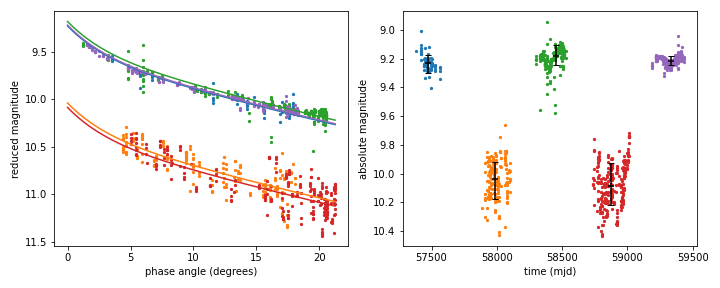
Figure 1: ATLAS photometry for 766 Moguntia, an asteroid that shows clear apparition effects. Left: Phase curves for each apparition, fixing G = 0.15 and fitting only for H. Observations are colour-coded by apparition. Right: Absolute magnitude of Moguntia over time, where each observation has been corrected for distance and phase effects. Error bars indicate the fitted H and standard deviation of the residuals for each apparition, highlighting the shifts in brightness between apparitions and rotational brightness variations.
Acknowledgements
This work has made use of data from the Asteroid Terrestrial-impact Last Alert System (ATLAS) project. ATLAS is primarily funded to search for near earth asteroids through NASA grants NN12AR55G, 80NSSC18K0284, and 80NSSC18K1575; byproducts of the NEO search include images and catalogs from the survey area. The ATLAS science products have been made possible through the contributions of the University of Hawaii Institute for Astronomy, the Queen’s University Belfast, the Space Telescope Science Institute, the South African Astronomical Observatory (SAAO), and the Millennium Institute of Astrophysics (MAS), Chile.
References
Bowell, E., Hapke, B., Domingue, D., et al. 1989, Application of Photometric Models to Asteroids., 524–556
Mahlke, M., Carry, B., & Denneau, L. 2021, Icarus, 354, 114094
Penttilä, A., Shevchenko, V., Wilkman, O., & Muinonen, K. 2016, Planetary and Space Science, 123, 117
Tonry, J. L., Denneau, L., Heinze, A. N., et al. 2018, Publications of the Astronomical Society of the Pacific, 130, 064505
Warner, B. D., Harris, A. W., & Pravec, P. 2021, Asteroid Lightcurve Database (LCDB) Bundle V4.0 Wong, I. & Brown, M. E. 2016, The Astronomical Journal, 152, 90
How to cite: Robinson, J., Fitzsimmons, A., Young, D., Denneau, L., Smith, K., Bannister, M., Heinze, A., and Tonry, J.: Investigation of Asteroid Phase Curves Extracted from the ATLAS Survey, Europlanet Science Congress 2022, Granada, Spain, 18–23 Sep 2022, EPSC2022-1144, https://doi.org/10.5194/epsc2022-1144, 2022.
Introduction
When talking about Trojan asteroids -- bodies orbiting around the L4 or L5 Lagrangian points of a Sun-planet system -- it is inevitable to refer to Jupiter. This giant planet has, by far, the largest reservoir of Trojan asteroids with thousands of objects discovered since 1906. We currently know, however, that other planets are also able to host asteroids in such a peculiar orbital configuration, although in much smaller number. Trojan asteroids can be important to study the formation and evolution of our Solar System since, some of them – called primordials -- might be remnants of the formation processes of the hosting planet. The first Earth Trojan asteroid (ETA) was discovered in 2010 librating around L4. Thenceforth, several dedicated observational campaigns have been scrutinizing L4 and L5 areas, trying to find a second ETA. In this work we describe how we confirmed (614689) 2020 XL5 as the second ETA and we discuss why it is so arduous to detect these objects with groundbased observations.
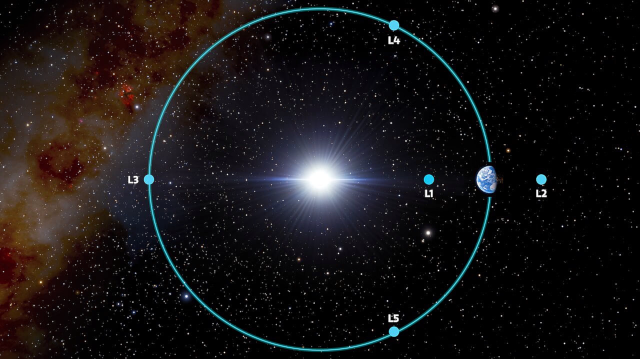
Fig.1: The Sun-Earth Lagrangian points. 2020 XL5 is librating around L4. (NOIRLab/NSF/AURA/J. da Silva)
Observations
Asteroid 2020 XL5 was discovered by the Pan-STARRS1 survey on 2020 December 12. An initial orbit determination was obtained from follow-up observations gathered during the next few weeks. Some solutions suggested that 2020 XL5’s orbit could be librating around L4, but the short arc covered with observations was still to short for a long term analysis [8]. However, observations were challenging due to the object’s faintness (V~22 mag) and its proximity with the Sun (ε<40°).
Our team started a follow-up campaign and was able to obtain a few new measurements (Fig.2) of the object during February and March 2021 using ESA’s Optical Ground Station (OGS) 1.0 m telescope, the 4.1 m Southern Astrophysical Research (SOAR) telescope and the 4.3 m Lowell Discovery Telescope (LDT). Despite the successful results of the observation campaign and the consequent improvement of the orbit of 2020 XL5, the arc was still too short for a conclusive result. However, the orbit now allowed us for a detective work among the tons of data from the surveys. Precoveries were found in the files of the Catalina Sky Survey (1.5 m Mt. Lemmon telescope), DECam instrument (4.1 m Victor M. Blanco telescope) and the archive of the 1.8 m Pan-STARRS survey (Fig. 3).
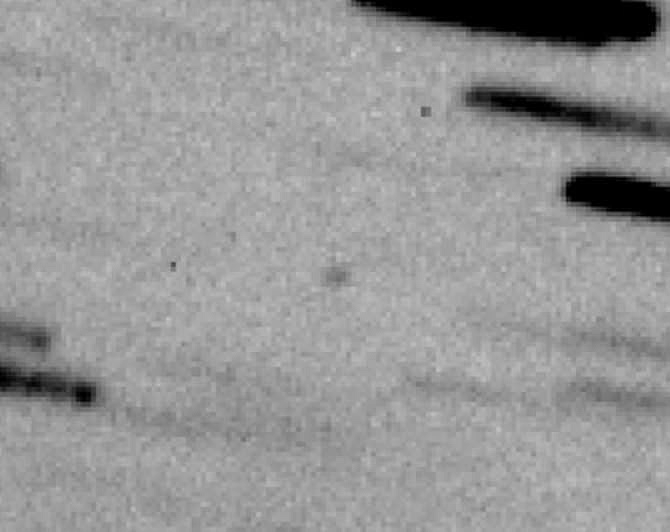
Fig.2: LDT detection of 2020 XL5.
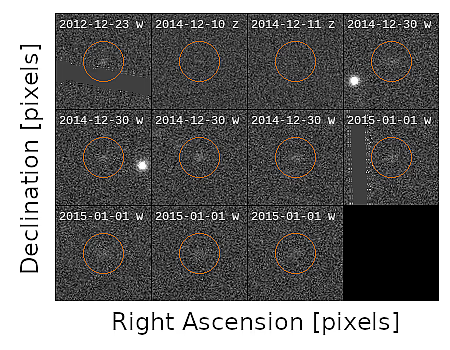
Fig.3: Pan-STARRS ancillary data of 2020 XL5.
Results
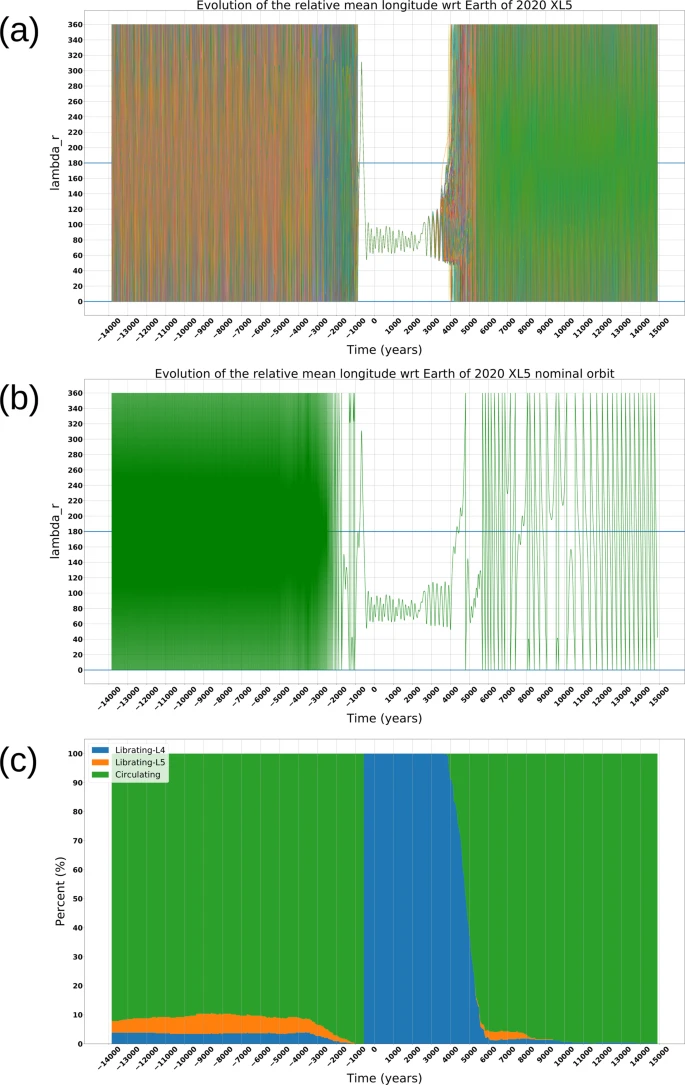
Fig.4: a The relative mean longitude (λr) evolution of the 2020 XL5 nominal orbit and clones orbit over 29 000 years, where each clone orbit is represented by a different color, while the green line represents the nominal orbit. b Evolution of λr for the nominal orbit of 2020 XL5. c Stack plot representing the behavior of the nominal orbit and the 800 clone orbits. In the plot the time t0 = 0 is the mean epoch of the orbits.
With all the data in hand, we generated hundreds of clone orbits along a time span of 29 000 years, applying the Cholesky method for multivariate normal distributions [9]. The study of the relative mean longitude of 2020 XL5 (Fig.4) revealed that the object is indeed a transient ETA, which was captured some 500 years ago and will keep librating around L4 for at least 4000 more years. In addition, we performed a preliminar physical characterization of the asteroid by means of photometry. We estimated its absolute magnitude to be Hr =18.58 (+0.16−0.15), and color indices suggestive of a C-complex taxonomy. Assuming an albedo of 0.06 ± 0.03 we obtained a bulk diameter of 1.18 ± 0.08 km.
References
[1] Dvorak, R. & Schwarz, R. On the stability regions of the Trojan asteroids. Celest. Mech. Dyn. Astron. 92, 19–28 (2005).
[2] Connors, M., Wiegert, P. & Veillet, C. Earth’s Trojan asteroid. Nature 475, 481–483 (2011).
[3] Wiegert, P. A., Innanen, K. A. & Mikkola, S. An asteroidal companion to the Earth. Nature 387, 685–686 (1997).
[4] Whiteley, R. J. & Tholen, D. J. A CCD search for Lagrangian asteroids of the Earth-Sun system. Icarus 136, 154–167 (1998).
[5] Markwardt, L. et al. Search for L5 Earth Trojans with DECam. Mon. Not. R. Astron. Soc. 492, 6105–6119 (2020).
[6] Lifset, N., Golovich, N., Green, E., Armstrong, R. & Yeager, T. A search for L4 Earth Trojan asteroids using a novel track-before-detect multiepoch pipeline. Astron. J. 161, 282 (2021).
[7] Santana-Ros et al. Orbital stability analysis and photometric characterization of the second Earth Trojan asteroid 2020 XL5. Nature Communications 13, 447 (2022)
[8] de la Fuente Marcos, C. & de la Fuente Marcos, R. Transient terrestrial Trojans: comparative short-term dynamical evolution of 2010 TK7 and 2020 XL5. Res. Notes Am. Astronomical Soc. 5, 29 (2021).
[9] T., T. N. Essentials of Monte Carlo Simulation (Springer-Verlag, New York, 2013).
Acknowledgements
TSR acknowledges funding from the NEO-MAPP project (H2020-EU-2-1-6/870377). This work was (partially) funded by the Spanish MICIN/AEI/10.13039/ the Institute of Cosmos Sciences University of Barcelona (ICCUB, Unidad de Excelencia ‘María de Maeztu’) through grant CEX2019-000918-M.
How to cite: Santana-Ros, T., Micheli, M., Faggioli, L., Cennamo, R., Devogèle, M., Alvarez-Candal, A., Liu, P.-Y., Benavidez, P. G., and Campo Bagatin, A.: Operating manual on how to find an Earth Trojan asteroid, Europlanet Science Congress 2022, Granada, Spain, 18–23 Sep 2022, EPSC2022-986, https://doi.org/10.5194/epsc2022-986, 2022.
1. Introduction
Linear secular resonances occur when there is a commensurability between the frequency of precession of an asteroid perihelion, g, or node, s, and that of a planet. The ν6 involves a relationship between the frequency g of an asteroid and the g6 frequency of Saturn. Since it is a pericenter resonance, it can increase most asteroids’ eccentricities to planet-crossing levels. It can, therefore, destabilize most of the bodies that interact with it, and it is a major source of NEAs through Yarkovsky effect [2]. Despite this fact, stable orbital configurations exist inside the ν6 resonance. In such configurations, the resonant angle σ = ϖ −ϖ6, with ϖ the longitude of pericenter of the asteroid and ϖ6 that of Saturn, can oscillate around either 0◦ or 180◦. In the first case, we have an “aligned libration”, since the pericenters of both Saturn and the asteroid are pointing in the same direction. For the second case, we have an “anti-aligned libration”.
[4] identified the first case of an asteroid family completely made of asteroids in anti-aligned libration states, that of 1222 Tina. [6] extended this analysis to the whole main-belt, and found the first seven asteroids in aligned states of the same resonance. Here, we extended the previous analysis using the largest database of asteroid proper yet obtained.
2. Identification of the resonant population using large databases
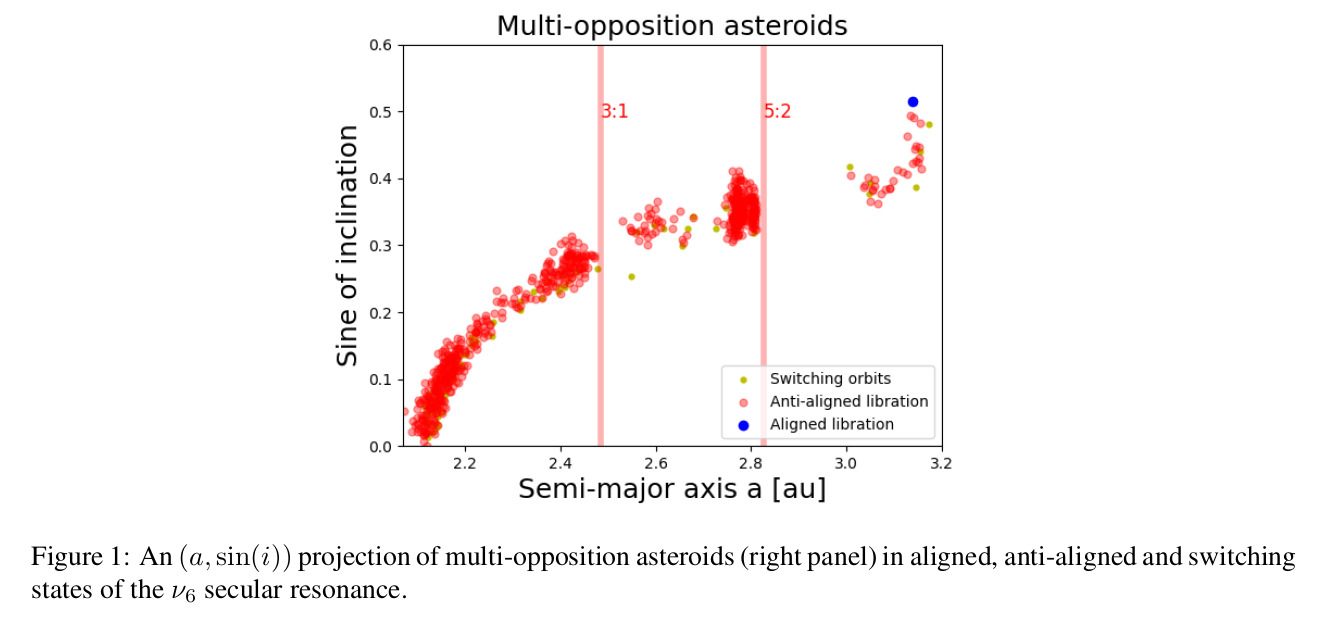
To identify the population of ν6 resonators, first, we need to select the asteroids most likely to be affected by this resonance. For this purpose, we use the criterion described in [6] and the approach outlined in [3]. We identified 15 asteroids on aligned orbital configurations, and 1713 on anti-aligned ones (see figure (1)). We then proceeded searching for asteroid groups among the newly identified anti-aligned population using the Hierarchical Clustering Method (HCM) [1]. Our results are shown in figures (2). We identify a new group around the asteroid 12988 Tiffanykapler.
3. 12988 Tiffanykapler: the first young family in the ν6 secular resonance
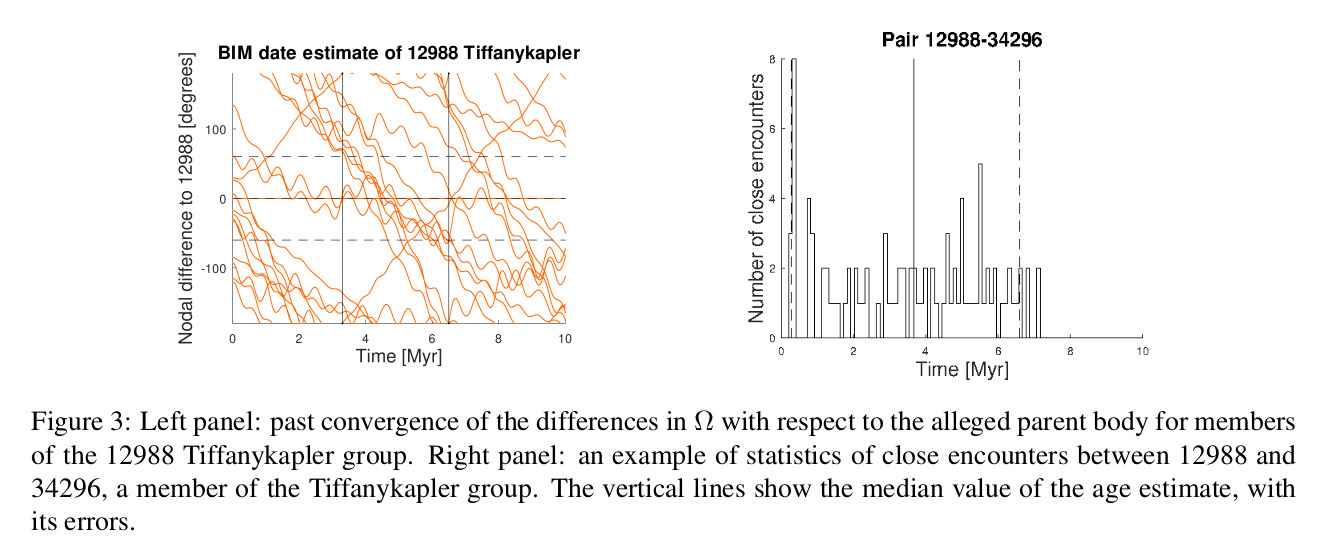
Young asteroid families can be dated using methods based on numerical integrations of family members in the past, like the Backward Integration Method (BIM, [7]) and the Close Encounters Method (CEM, [5]). In the BIM method, from time-reversal numerical simulations, past discrepancies in the longitudes of node Ω of family members with regard to those of the claimed parent body are obtained. These differences should converge to values approaching zero at the time of family formation. The CEM approach works by integrating into the past multiple clones of the parent body and of the other family members. Close encounters that occur at low relative distances and speeds between two clones are recorded, and the median value of these times is used to estimate the asteroid pair’s age. The results of both methods are shown in figure (3). The BIM method suggests a possible solution for the 12988 group in the time range from 3.3 to 6.5 Myr. The weighted average of the age determination of all asteroid pairs in the family, one example of which is shown in the right panel of figure (3), provides an age estimate for the family of 3.05 ± 1.15 Myr.
As discussed in [4], at the simplest level of perturbation theory the quantity:
is preserved for asteroids in the ν6 resonance in the conservative case. The preservation of the original values of K2' permits to estimate the initial ejection velocity field with a method not generally available for non-resonant families. Our analysis yields a value of the ejection velocity parameter VEJ = 15+6-3 m/s.
4. Summary and Conclusions
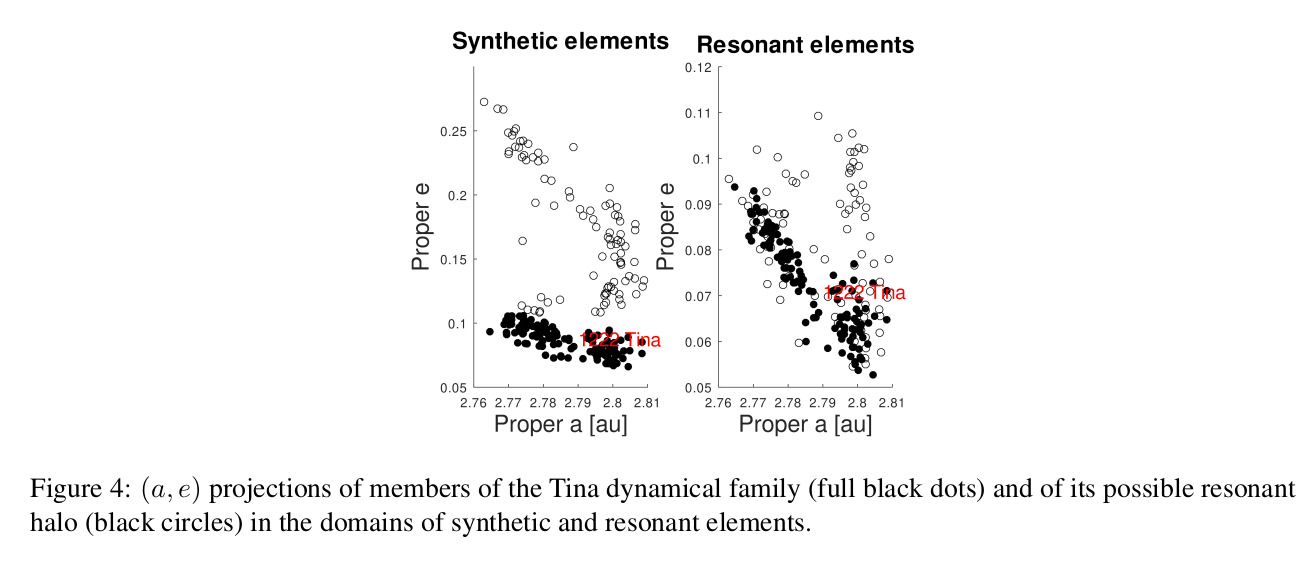
In this work, we were able to obtain a sample of 15 asteroids on aligned orbits and 1669 asteroids on anti-aligned orbits, the largest database so far for this asteroidal population. Two new asteroid groups were identified for the first time in this work: those of Tiffanykapler in the inner main-belt and 138605 QW177 in the outer belt. Tiffanykapler is the first young asteroid family in a linear resonant configuration ever to be found. Combining methods based on backward numerical simulations and constraints from resonant dynamics, we found that the family has an age of 3.05 ± 1.15 Myr and an ejection velocity field parameter of VEJ = 15+6-3 m/s. Finally, using resonant proper elements ([4]), we also identified a highly eccentric population of asteroids near the Tina family, that are likely to be part of its halo. It is the first example of a “resonant halo”.
Acknowledgements
We thank the Brazilian National Research Council (CNPq, grant 301577/2017-0), and the Foundation for Research Support of São Paulo state
(FAPESP, grant 2016/024561-0). More information on this work is available on Carruba et al. 2022, MNRAS, under review, available on ArXiv: 2203.15763.
References
[1] BENDJOYA, P., AND ZAPPALÀ, V. Asteroid Family Identification. In Asteroids III. Arizona Univ. Press, 2002, pp. 613–618.
[2] BOTTKE, W. F., JEDICKE, R., MORBIDELLI, A., PETIT, J.-M., AND GLADMAN, B. Understanding the Distribution of Near-Earth Asteroids. Science 288, 5474 (June 2000), 2190–2194.
[3] CARRUBA, V., A LJBAAE, S., DOMINGOS, R. C., AND BARLETTA, W. Artificial neural network classification of asteroids in the M1:2 mean-motion resonance with Mars. MNRAS 504, 1 (June 2021), 692–700.
[4] CARRUBA, V., AND MORBIDELLI, A. On the first ν6 anti-aligned librating asteroid family of Tina. MNRAS 412, 3 (Apr. 2011), 2040–2051.
[5] CARRUBA, V., S POTO, F., BARLETTA, W., ALJBAAE, S., FAZENDA, Á. L., AND MARTINS, B. The population of rotational fission clusters inside asteroid collisional families. Nature Astronomy 4 (Jan. 2020), 83–88.
[6] HUAMAN, M., ROIG, F., CARRUBA, V., DOMINGOS, R. C., AND ALJBAAE, S. The resonant population of asteroids in librating states of the ν6 linear secular resonance. MNRAS 481, 2 (Dec. 2018), 1707–1717.
[7] NESVORNÝ, D., BOTTKE, WILLIAM F., J., DONES, L., AND L EVISON, H. F. The recent breakup of an asteroid in the main-belt region. Nature 417, 6890 (June 2002), 720–771.
How to cite: Carruba, V., Aljbaae, S., Domingos, R. C., Huaman, M., and Martins, B.: Identifying the population of stable ν6 resonant asteroids using large databases, Europlanet Science Congress 2022, Granada, Spain, 18–23 Sep 2022, EPSC2022-238, https://doi.org/10.5194/epsc2022-238, 2022.
Abstract
The aim of this work is to investigate the dynamics of small bodies that are in co-orbital motion with a given planet in the solar system. The study is based on the data corresponding to the ephemerides computed by the JPL Horizons system for asteroids with a low inclination with respect to the Sun-planet orbital plane. These objects are cataloged according to their dynamics as seen in the averaged formulation of the Restricted Three-Body Problem in the circular-planar case. The tool developed can show where asteroids in horseshoe motion, quasi-satellite motion and tadpole motion are located, together with the dynamical transitions that occur in the given timeframe. The results will provide the first catalog of asteroids in co-orbital motion in the solar system at the moment and an efficient mean to study dynamical transitions. Moreover, for the Earth case, possible targets for future retrieval and exploration mission can be pinpointed.
Introduction
Co-orbital motion is a particular type of dynamics that occurs in the Three-Body Problem, according to which two bodies gravitate towards a more massive body with the same period.
Many objects susceptible to be at least temporary co-orbitals have been observed in the solar system, in particular for Venus, Earth, Mars and Jupiter.
A major example is given by the Trojans of Jupiter, that move on tadpole (TP) trajectories in the neighborhood of the two Lagrange's equilateral configurations L4 and L5 in the synodic reference system. In the prograde case, the other two fundamental configurations are horseshoe (HS) trajectories and quasi-satellite (QS) orbits.
Co-orbital trajectories, their possible mutual transitions together with escaping/trapping mechanisms are not only evident in the natural dynamics observed in the solar system, but very recently they have also assumed an important role for space exploration missions. For instance, ESA is planning to exploit L5 of the Sun-Earth system to monitor the solar activity and the related space weather issues. The Chinese space agency aims at visiting the near-Earth asteroid Kamo'oalewa, due to its interesting QS state.
The idea of this work comes from the development of Pousse and coauthors [1,2], regarding the averaged Hamiltonian of the Restricted Three-Body Problem (RTBP) in the circular-planar case. From the theoretical point of view the domain of validity of the analytical model has been proved, here we are interested in testing its validity against real bodies dynamics and to propose some applications. The main tool we will consider is a simple map, that is function of the orbital eccentricity of the heliocentric motion of the asteroid and the relative phase between the planet and the asteroid, and that can comprise all the important information about the motion of the asteroid.
Methods
Taking as example a system composed by the Sun, a planet and an asteroid, we assume the RTBP approximation in the circular-planar case. Following the co-orbital assumption, the asteroid orbits the Sun with the same orbital period as the planet orbits the Sun. The resonant condition on the orbital periods allows for very stable solutions, that are indeed observed in the solar system, as mentioned above.
We are interested in depicting the dynamics of the asteroid with regard to the orbital elements associated with its heliocentric motion. In particular, since the motion is assumed to be planar, we will focus on its semi-major axis a and eccentricity e and an angle θ, related to the relative phase with respect to the motion of the planet.
Since we focus on the co-orbital dynamics, that can be seen as the continuation of Keplerian orbits in 1:1 mean motion resonance with the planet, the most natural choice appears to tackle the problem by means of a perturbative treatment, considering the mass parameter of the system as the perturbative parameter. By adopting a suitable set of resonant variables and the possibility to separate different timescales, the dynamics can be described by a 1 degree-of-freedom integrable model, that allows to depict simple phase space portraits that catch the main secular features.
The instruments corresponding to the averaged perturbation theory are applied to the ephemerides computed by the JPL Horizons system over about 900 years for asteroids that can be in co-orbital motion with Venus, Earth, Jupiter or Saturn, with an inclination low enough to be considered almost coplanar with the given planet. The analysis aims at identifying the asteroids in 1:1 mean motion resonance at the current time, not only in TP motion, and to reveal the possible mechanisms of transitions (see an example in Fig. 1) between co-orbital configurations and not. In particular, we analyse the transitions with respect to the limits of our model (e.g., non-negligible inclination, or external effect).
Figure 1: Example of transition between horseshoe motion and quasi-satellite motion.
A simple map, function of (θ,e), is used to characterize the given Sun-planet system. The asteroids that are in co-orbital motion with Jupiter at an epoch corresponding to the actual one within a certain threshold are shown in Fig. 2.
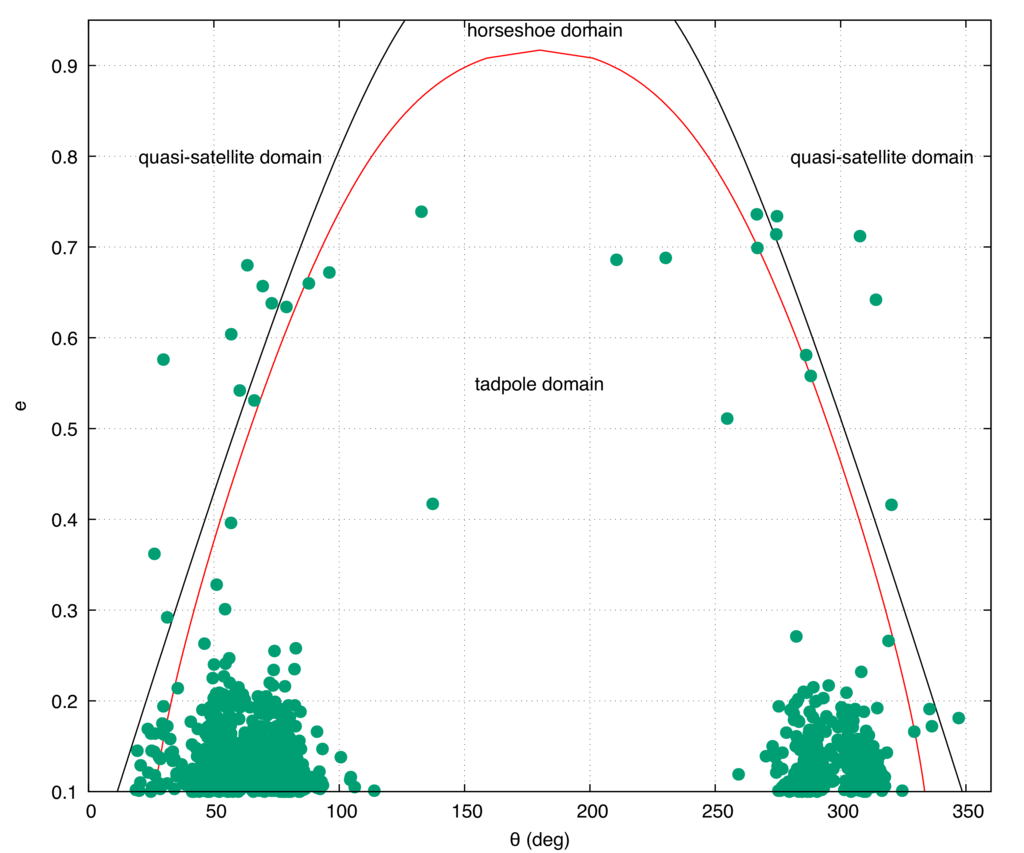
Figure 2: General map to represent the co-orbital asteroids for a given Sun-planet system. Here we show the results obtained for Jupiter in the almost co-planar case.
Acknowledgments
The authors are indebted with Federica Spoto from CFA Harvard and with Tommaso Del Viscio from IMATI-CNR. A.P and E.M.A. acknowledge the support received by the project entitled "co-orbital motion and three-body regimes in the solar system", funded by Fondazione Cariplo through the program "Promozione dell'attrattività e competitività dei ricercatori su strumenti dell'European Research Council - Sottomisura rafforzamento".
References
[1] Pousse A., Robutel P., Vienne A., On the co-orbital motion in the planar restricted three-body problem: the quasi-satellite motion revisited. Celest. Mech. Dyn. Astron. 128(4), 383-407 (2017)
[2] Pousse A., Alessi E.M., Revisiting the averaged problem in the case of mean-motion resonances in the restricted three-body problem. Nonlinear Dynamics 108, pages 959-985 (2022)
How to cite: Alessi, E. M., Pousse, A., and Di Ruzza, S.: Averaged theory applied to the co-orbital motion of real asteroids in the solar system in the medium-term timescale, Europlanet Science Congress 2022, Granada, Spain, 18–23 Sep 2022, EPSC2022-119, https://doi.org/10.5194/epsc2022-119, 2022.
The NEO population model derived by Granvik et al. (2016,2017,2018) suggested that there is an overestimate of objects in low perihelion distance (q) orbits when compared to the observed population. The remedy to this discrepancy was to include a super-catastrophic disruption of objects when they crossed an average disruption distance, defined as q*=0.076 au. The mechanism responsible for destroying such objects is not determined yet, but it is believed to be thermal in nature.
How to cite: Toliou, A. and Granvik, M.: The recent dynamical past of the low perihelion NEO population, Europlanet Science Congress 2022, Granada, Spain, 18–23 Sep 2022, EPSC2022-1014, https://doi.org/10.5194/epsc2022-1014, 2022.
There are a large number of small bodies (known as trans-Neptunian objects or TNOs) in the outer solar system that show different types of dynamical behavior. These objects can be considered as "probes" of the dynamical and chemical history of the Solar System. These asteroids or planetezimals are relics of dynamical events among and beyond the giant planets, and the current observed orbital distribution of the TNOs is a sign of large-scale changes in the position of the giant planets. The dynamical classification of the bodies of this outer region of the Solar System helps to understand the structure and formation of the Solar System. In this work, we performed a comprehensive survey on the TNOs. By using the FAIR method considering all known small bodies in outer Solar System (more than 4,000 asteroids classified as TNO in the JPL database), we identified several MMRs between these bodies and the planet Neptune. According to our dynamical investigations, there are two types of resonant behaviour of asteroids; namely, when the critical argument (resonance variable) shows short-term or long-term libration.
How to cite: Forgács-Dajka, E., Kővári, E., Kovács, T., Kiss, C., and Sándor, Z.: Dynamical Investigation of Trans-Neptunian Objects in particular the Mean-Motion Resonances with Neptune, Europlanet Science Congress 2022, Granada, Spain, 18–23 Sep 2022, EPSC2022-1213, https://doi.org/10.5194/epsc2022-1213, 2022.
In a recent research, we carried out a large-scale survey of the trans-Neptunian objects (TNOs) by means of dynamical maps. We identified the most important MMRs and explored their dynamical role through the quantification of the chaotic diffusion and that of the stability times of the small bodies. The chaotic diffusion is of fundamental importance for its rate determines the long-term evolution of a given celestial system. To estimate the rate of the diffusion (that is, to compute the diffusion coefficients) in the case of more than 4100 TNOs, we initiated the use of the Shannon entropy. This latter quantity allows, on the one hand, to measure the extent of unstable regions in the phase space (and thus serves as an indicator of chaos), and also enables the direct measurement of the diffusion coefficients. The characteristic times of stability - in the case of normal diffusion - are then achieved by taking the inverse of the diffusion coefficients. In the knowledge of the chaotic diffusion and stability times for as large a TNO sample as the one indicated above, the overall structure of the trans-Neptunian space can be mapped, along with the specification of dynamical classes or the update of the existing ones.
How to cite: Kővári, E., Forgács-Dajka, E., Kovács, T., Kiss, C., and Sándor, Z.: Chaotic behaviours of different time-scales in the trans-Neptunian space, Europlanet Science Congress 2022, Granada, Spain, 18–23 Sep 2022, EPSC2022-1216, https://doi.org/10.5194/epsc2022-1216, 2022.
Introduction: Study of near-Earth objects (NEOs) is crucial to better understand the origin, formation and the evolution of the solar system. In particular, compositional, morphological and orbital characterisation of NEOs sheds light on the delivery of water and organics [1,2,3] to the prebiotic Earth, while ironically, some NEOs could be potential hazards for life on Earth [4]. In this context, we apply the G-mode multivariate statistical clustering method [5,6,7] on the orbital parameters of the currently available NEOs population, to probe potential associations with their spectral classification [8,9,10].
Data and Methods: G-mode method leads to an automatic statistical clustering of a sample containing N objects (NEOs in this case), described by M variables with the only control imposed by the user being the confidence level q1, expressed in terms of σ. The objects that cannot be associated to a cluster are separated and considered as outliers. We apply G-mode multivariate statistical clustering analysis to variables defining NEOs to determine clustering of objects.
Our sample consists of 14132 NEOs, filtered based on their orbital uncertainty. Our input parameters to the G-mode method are twofold. First, in approach 1 (A1) we used three variables and their uncertainties as inputs: inclination (i), eccentricity (e) and semi-major axis (a) of the orbit. In approach 2 (A2) we used six inputs by including the argument of perihelion (ω), Tisserand parameter with respect to Jupiter (TJ) and the absolute magnitude (H) and their respective uncertainties in addition to those used in A1.
Results: In A1, we obtained only one cluster at q1=3σ (accurate classification probability of 99.7%), which meant that the NEOs in this cluster are homogeneous in terms of the three orbital elements used. As we gradually lowered the value of q1, hence the confidence level, we noticed that more clusters got seeded and populated. We report in Table 1, mean parameter values with the median absolute deviation for 8 clusters obtained at q1=1.78σ. In addition to reporting the statistics of obtained clusters, we have also reported the outlier group of NEOs in the row indexed by 0. Among the reported clusters, cluster 1 (C1) corresponds to the background population of NEOs as their statistics are comparable to those of all hitherto discovered NEOs. C2 represents NEOs with relatively moderate inclination. C3, despite having relatively small number of NEOs, is constrained by well-behaved low-inclined, quasi-circular Earth-like orbits owing to their very low median absolute deviations. The very low mean H implies that these NEOs are relatively smaller with a distribution peak in the range of 5-15 meters of diameter.

C5, C6 and C7 are of particular interest, for they could be associated with Jupiter-family cometary nuclei (2 < TJ < 3) as per their mean TJ. As such, the objects in these three clusters could potentially be extinct cometary nuclei. These clusters also have relatively higher eccentricities, akin to cometary orbits. We have checked available taxonomic classifications of NEOs [11,12,13] in the literature to get an insight into the composition of the objects. Although taxonomic classifications are not available for the majority of members in the clusters, we find that (i) C5 contains 3 C-types, 2 D-types and 0 S-types (ii) C6 contains 3 D-types and 4 S-types (iii) C7 contains 2 B-types, 3 C-types, 2 D-types and 1 S-type. Therefore we argue that C5 and C7 can be associated to primitive carbonaceous compositions while C6 can be associated to both carbonaceous and silicate-dominated compositions.
To get more insights about the obtained G-mode clusters and further test these results, we applied a dynamic model to find their potential escape regions in the main belt [14]. This dynamical model, the Granvik model hereafter, traces with scrutiny the escape paths of objects from the main-belt to near-Earth space and the model accounts for the Yarkovsky effect [15]. Given the orbital elements and absolute magnitude of an NEO, it resolves a probability distribution function, built up of seven discrete values for seven escape regions. The results obtained with the Granvik model are shown in Fig. 1 for the clusters obtained for the G-mode run at q1=1.78σ in A1.
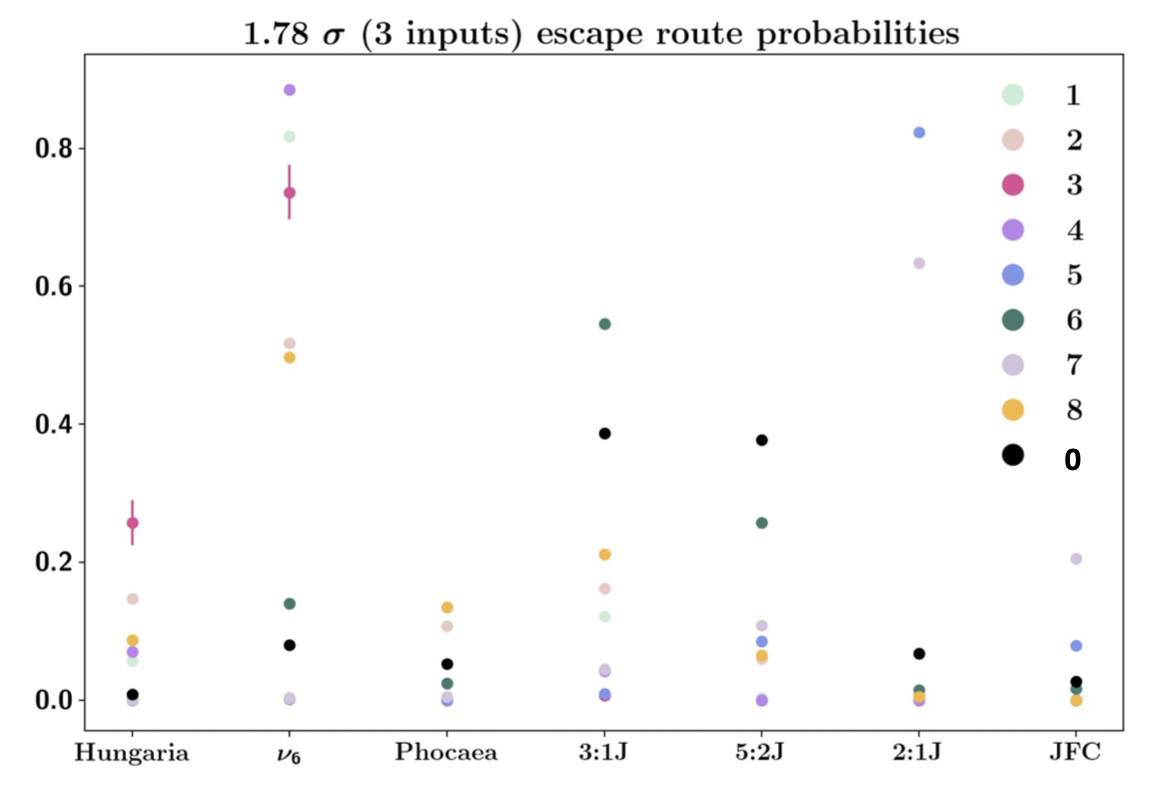
Fig. 1. Probability distributions for the G-mode clusters obtained at 1.78σ for A1 to emanate from any of the seven escape regions.
These results imply that most of the clusters have higher probability to emanate via ν6 secular resonance, known to be the most dominant escape path from the main-belt to the near-Earth space [16]. We observe that C5 and C7 have significant probabilities to emanate from outer-belt sources such as 2:1 mean motion resonance of Jupiter and JFCs. Thus, our dynamic modelling reinforces and corroborates existing results, pointing towards a primitive origin for the NEOs in these two clusters.
Similiary, we will present the results of A2 and discuss their implications.
Acknowledgements: We acknowledge the financial support from Agenzia Spaziale Italiana (ASI, contract No. 2017-37-H.0 CUP F82F17000630005) and funding from the European Union’s Horizon 2020 research and innovation programme under grant agreement No. 870403.
References:
[1] Marty, B., Guillaume, A. et al. 2016, Earth and Planetary Science Letters, Volume 441,Pages 91-102
[2] Altwegg, K, Balsiger, H, Bar-Nun, A. et al. 2015, Science, Vol. 347,6220,1261952
[3] Ehrenfreund, P. & Sephton 2006, Faraday Discuss., The Royal Society of Chemistry,133,277-288
[4]Perna, D., Barucci M.A., Fulchignoni M. 2013, Astronomy and Astrophysics Review,Vol.21,65
[5] Barucci, M.A., Capria, M.T., Coradini, A. et al. 1987,Icarus,72,304
[6] Gavrishin, A.I., et al. 1992, Earth, Moon and Planets,59,141-152
[7] Barucci, M.A., Belskaya, I., Fulchignoni, M. et al. 2005,AJ130,1291
[8] Bus, S.J., & Binzel, R.P. 2002, Icarus,158,146
[9] DeMeo, F.E., Binzel, R. P., Slivan, S.M. & Bus, S. J. 2009,Icarus,202,160-180
[10] DeMeo, F.E., Alexander, C.M.O., Walsh, K.J.et al. 2015, Asteroids IV,13-41
[11] Perna, D., Barucci,M.A. et al. 2018, Planetary and Space Science,157,82-95
[12] Devogèle, M., Moskovitz, N. et al. 2019, The Astronomical Journal, American Astronomical Society,158,196
[13] Ieva, S., Dotto, E. et al. 2020,A&A,644,A23
[14] Granvik, M., Morbidelli, A., Jedicke, R., et al. 2018,Icarus,312,181
[15] Vokrouhlický, D., Bottke, W. F., Chesley, S.R., Scheeres, D.J., & Statler, T.S. 2015, in Asteroids IV,509–531
[16] Bottke, W.F., Morbidelli,A., Jedicke,R., et al. 2002,Icarus,156,399
How to cite: Deshapriya, J. D. P., Perna, D., Bott, N., Hasselmann, P. H., Granvik, M., Dotto, E., Fulchignoni, M., Giunta, A., Perozzi, E., Ieva, S., Petropoulou, V., and Mazzotta-Epifani, E.: Statistical clustering analysis of NEOs to find correlations with spectral classes, Europlanet Science Congress 2022, Granada, Spain, 18–23 Sep 2022, EPSC2022-698, https://doi.org/10.5194/epsc2022-698, 2022.
Finding a link between meteorites and asteroids thanks to spectroscopy gives a great insight of the composition of the bodies in the asteroid population. Meteorites such as the Howardite-Ensatites-Diogenites (HEDs) have been successfully linked to the asteroid Vesta (McCord et al. (1970), summary by McSween Jr. et al. (2013)), and the ordinary chondrite meteorite population has been connected to a subtype of S-type asteroids, after having taken into account space weathering processes (Binzel et al. 2001). These processes alter the surface of asteroids and modify their reflectance spectra with respect to that of the fresher meteorites, hence they need to be taken into account prior to comparing asteroids with meteorites spectra (Hapke 2001). Other meteorite types have been studied and linked to asteroid types, but some objects still do not show convincing connections (DeMeo et al. 2022). Linking meteorites to the primordial population of objects would give information about the formation and evolution of bodies in the Solar System. Indeed, the planetesimals that formed earliest in the Solar System are thought to have been fully differentiated, due to the melting induced by the heating produced by the radioactive decay of 26Al isotopes. This should have resulted in planetesimals presenting a basaltic crust, an olivine-dominated mantle and an iron-rich core (DeMeo et al. 2019). However most of these primitive objects have evolved, have been disrupted or integrated to other bodies (such as planets) and their formation processes and the composition of their primordial crusts is not well known.
We will report about searching for potential parents bodies of meteorites coming from differentiated planetesimals, using literature data and the new dataset of reflectance spectra that will be released in the Gaia Data Release 3 (DR3) in June 2022. This dataset will present low resolution mean reflectance spectrum of 60 518 Solar System objects, acquired by Gaia’s blue and red spectrophotometers (BP and RP) between August 2014 and May 2017. Each spectrum will consist of 16 discrete wavelength bands that spans the visible wavelength range from 374 to 1034 nm (Gaia collaboration, Galluccio, Delbo et al. 2022). These data should allow to look inside asteroid collisional families and search for hints of differentiation, looking for members corresponding to the crust, mantle or core of a disrupted planetesimal. We intend to use these data to try to link meteorites that are known to have been produced by differentiation (e.g. metallic or andesitic bodies) to the primordial population of asteroids. Finding the parent body of differentiated meteorites would allow to understand better the formation and differentiation of planetesimals in our Solar System.
To compare the reflectance spectra of meteorites with Gaia’s asteroids, we will first use a curve matching method. Curve matching consists in determining whether any given spectrum is similar to a reference spectrum, by the means of a coefficient that has to be minimized (such as the χ2) or maximized (correlation coefficient for example) (Popescu et al. 2012). We will as well study the features of the spectra in order to better characterize the asteroids and validate the matches (Gaffey 2011). Space weathering processes will be taken into account.
Acknowledgements
The authors acknowledge the financial support of CNES and OCA, which make this study possible. M. Delbo thanks financial support from the ANR ORIGINS (ANR-18-CE31-13-0014).
References
Binzel, R. P., Rivkin, A. S., Bus, S. J., Sunshine, J. M., & Burbine, T. H. 2001, Meteoritics & Planetary Science, 36, 36
DeMeo, F. E., Burt, B. J., Marsset, M., et al. 2022, Icarus, 380, 114971
DeMeo, F. E., Polishook, D., Carry, B., et al. 2019, Icarus, 322, 13
Gaffey, M. J. 2011, AIP Conference Proceedings, 1386, 1386
Gaia collaboration, Galluccio, Delbo et al. 2022 Gaia Data Release 3: Reflectance spectra of Solar System Small Bodies. A&A under review.
Hapke, B. 2001, J. Geophys. Res., 106, 10039
McCord, T. B., Adams, J. B., & Johnson, T. V. 1970, Science, 168, 1445
McSween Jr., H. Y., Binzel, R. P., De Sanctis, M. C., et al. 2013, Meteoritics & Planetary Science, 48, 48
Popescu, M., Birlan, M., & Nedelcu, D. M. 2012, A&A, 544, 544
How to cite: Galinier, M., Delbo, M., Galluccio, L., and Marrocchi, Y.: Searching for parent bodies of differentiated meteorites in the main-belt using visible and near-infrared spectroscopy, Europlanet Science Congress 2022, Granada, Spain, 18–23 Sep 2022, EPSC2022-351, https://doi.org/10.5194/epsc2022-351, 2022.
Asteroids, along with other small bodies, are what is left over of the original planetesimal disk from the planet-formation era. Therefore, these objects are considered the best tracers for the processes that occurred during the earliest history of our Solar System. However, the majority of asteroids are fragments generated by the collisional breakup of the planetesimals, the first ~100-km sized bodies (Morbidelli et al., 2008, Delbo' et al., 2019) that accreted in the protoplanetary disk of our Sun.
Nevertheless, a small fraction of the planetesimal population survived the collisional evolution. In order to study these objects, the first step is to identify these surviving planetesimals among all the other (fragment) asteroids. To do so, we “cleaned” the inner part of the asteroid main belt (2,1 < a < 2,5) from all asteroid collisional family members (using the method of Bolin et al., 2017, Delbo' et al., 2017, 2019), thus revealing those asteroids that are not fragments that formed in the main belt. Thanks to this method, we revealed 64 surviving planetesimals in the inner main belt.
We carried out a spectroscopic survey of these identified IMB planetesimals, in order to constrain their composition and mineralogy. In particular, we performed visible and near-infrared spectroscopy using several telescopes such as the 1.82m Copernico Telescopio (Asiago, Italy) for the visible spectroscopy and the 4.2 Lowell Discovery Telescope (Flagstaff, USA); the 3.2 NASA Infrared Telescope Facility (Hawaii, USA) and the Telescopio Nazionale Galileo (La Palma, Spain) for the near-infrared part. To complete our survey, we also used spectra in the visible and near-infrared published in the literature, as well as size and albedo information that we obtained from the Minor Planet Physical Properties Catalog (https://mp3c.oca.eu/).
We performed the taxonomic classification following the Bus-DeMeo taxonomy (Bus et al., 2002; DeMeo et al., 2009), and using the M4AST tool (http://m4ast.imcce.fr) (Popescu et al., 2012). A visual inspection to identify the presence of absorption bands characteristic of some classes was performed to check the robustness of the automatic taxonomic classification. In addition, we compute for each planetesimal several spectral parameters, such as spectral slopes, and center, depth and area of absorption bands, when these are present. We also performed calculation of their mass, based on the method of (Carry, 2012). Finally, we used the RELAB database (Pieters, 1983), to look for meteorite analogues of each planetesimal.
We found that planetesimals of the Inner Main Belt (IMB) belong mainly to the S-complex (~45%), followed by C-complex (~25%) and X-complex (~17%). Further investigations on S-complex planetesimals showed that, for a majority of them, they are best matched by spectra of ordinary chondrites meteorites. We did not find any correlation with diameters, semimajor axis and the ratio of olivine/pyroxene. Almost 60% of the C-complex planetesimals belong to the Ch/Cgh types, showing spectroscopic features associated with hydrated minerals, and consequently indicating the presence of liquid water in the early formation phases of these objects. We also found that almost 5% of the IMB planetesimals belong to the D/T types with a diameter greater than 25 km. As this taxonomical class, as well as Ch/Cgh types, are likely to have formed in the outer part of the Solar System (at 3-7 au), their presence in the IMB (2,1-2,5 au) can be explained by dynamical models invoking large semimajor axis migration of these objects (e.g., Grand Tack of Walsh et al., 2011; low-mass asteroid belt of Raymond and Izidoro, 2017b for the C-complex and Vokrouhlický et al., 2016 for the D/T types).
Here, we will present the spectroscopic, physical and compositional results of our IMB planetesimals survey as well as the implications for planetary formation models.
Acknowledgements: We acknowledge support from the ANR ORIGINS (ANR-18-CE31-13-0014).
References : Morbidelli A. et al, Physica Scripta, Volume 130, Issue, id 014028 (2008) ; Delbo M. et al., A&A, Volume 624, id. A69 (2019) ; Bolin B. T. et al., Icarus, Volume 282, 2017, Pages 290-312 ; Delbo M. et al., Science, Volume 357, Issue 6355, pages 1026-1029, (2017) ; Bus S. J. et al., Icarus, Volume 158, Issue 1, Pages 146-177 (2002) ; DeMeo F. E. et al., Icarus, Volume 202, Issue 1, Pages 160-180 (2009); Carry, B. Planetary and Space Science, Volume 73, Issue 1, p. 98-118. (2012) ; Popescu M. et al., A&A, Volume 544, id. A130 (2012) ; Pieters, C. M., J. Geophys. Res., Volume 88, pages 9534– 9544 (1983) ; Walsh K. J. et al., Nature, Volume 475, Issue 7355, Pages 206-209 (2011) ; Raymond S. N. et al., Science Advances, Volume 3, Issue 9, Pages e1701138 (2017) ; Vokrouhlický D. et al., The Astronomical Journal, Volume 152, Issue 2, id. 39 (2016).
How to cite: Bourdelle de Micas, J., Fornasier, S., Delbo, M., Avdellidou, C., Van Belle, G., and Ochner, P.: Composition of Inner Main Belt Planetesimals, Europlanet Science Congress 2022, Granada, Spain, 18–23 Sep 2022, EPSC2022-440, https://doi.org/10.5194/epsc2022-440, 2022.
Introduction: V-type asteroids are those whose spectra is similar to Vesta [1].
Vesta underwent two huge impact events [2], that could have formed objects of this taxonomic class [3,4] and have eventually supplied the Vesta meteorites (HEDs) escaped from the Main Belt.
In this work, we look for statistically significant differences among the modal mineralogy of V-type asteroids belonging to different dynamical subclasses through a combination of spectroscopic analysis and Hapke Radiative Transfer Model (RTM).
Data and Methods: 76 Vis-NIR V-type asteroid spectra were downloaded from the Planetary Data System (PDS). In this work, we considered four dynamical families of V-type as follows:
(i) Vestoid: V-type members of the Vesta dynamical family, as defined by [4] using the hierarchical clustering method (HCM).
(ii) Fugitive: following the definition of [4], they are V-type asteroids with a < 2.3 au and comparable e and i with the Vesta family.
(iii) Low-I: according to [4], they are V-type asteroids having i < 6◦ and 2.3 < a < 2.5 au.
(iv) IOs (Inner Others): the remaining V-type asteroids in the inner main belt.
VNIR spectra of Vesta’s, V-type asteroids surface and HED show absorption bands centred at approximately 0.9 and 1.9μm, confirming the pyroxenes presence [5]. Through scatterplot analysis of spectral parameters (in particular, band depth and half width half maximum) of V-type asteroids and of HED, these two bands give evidence of the grain size range of each asteroid. The obtained information is used as constrain in the Hapke’s RTM (to prevent possible degeneration in the creation of synthetic spectra) to retrieve modal composition for each V-type asteroid. To simulate asteroids spectra in the Hapke RTM, we used the main endmembers of HED and we also added a darkening agent (Murchison spectrum) to find possible correlations between V-type asteroids and dark regions on Vesta [6].
Spectral fits of the asteroid’s dataset are robust with a global R mean square of 0.98, while the retrieved particle sizes are small with a mean value of 20 µm.
Results and Discussion: Comparing the modal mineralogy obtained from Hapke RTM and the [7] studies, it is possible to assign a lithology to each dynamical subclass. In particular, we can distinguish diogenites (approximately 100 % of pyroxene), noritic diogenites (2-42 % plagioclase, 52-97 pyroxene), cumulate eucrite (30-64 % plagioclase and 36-70 % pyroxene) and basaltic eucrite (39-46% plagioclase, 46-60 % pyroxene).
Then, in Figure 1, we report the mean and the standard deviation of sample of the four subclasses (Fugitive, Vestoids, Inner Others and Low-i). It seems that Vestoids and Fugitive are diogenitic (diogenitic and noritic diogenites respectively), while Low-I and Inner Other (IOs) are eucritic (Figure 2).
Figure 1: Results of mean mineralogy for each subclass from Hapke retrival
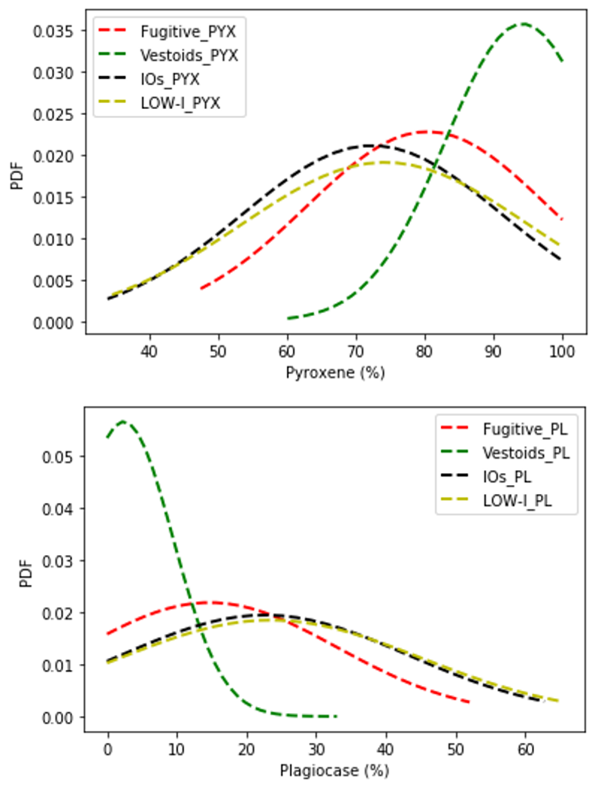
Figure 2: Probability density function of Pyroxene (up) and of Plagioclase (bottom) for each subclass
The most ‘ancient’ family, that is Low-i asteroids (they may date back to the LHB epoch or even to the 4.48-Ga impact on Vesta), seems to have an eucritic composition. In the most recent models of the structure of Vesta, it has a massive eucritic crust. Moreover, [2] found that the density of craters increases from the Rheasilvia rim to northern latitudes. This dichotomy in terms of crater density indicates that heavily cratered terrains (centered at about 348°E, 17°N and 110°E, 17°N) are much older than Rheasilvia basin, whose most probable age is estimated to be 1.0 ± 0.2 Ga [2]. Thus, it is compatible with the mineralogy of the Low-I asteroids that ‘swept out’, in the past, the outermost layer of Vesta.
Fugitive better match with a diogenitic composition. For this subclass, the probable age of formation is at least 1 Ga so that they could migrate away from Vesta [4], then it is possible that they were ejected in an older (2 Ga) cratering event that produced the Veneneia basin that underlies Rheasilvia [8].
Furthermore, [9] found from Dawn data that Rheasilvia basin (probable age is estimated to be 1.0 ± 0.2 Ga [9]) is consistent with a larger abundance of diogenite on the surface, while spectra from the equatorial regions are consistent with a larger eucrite amount. Thus, there is a possible chronologic link between impact events on Rheasilvia crater and the Vestoids, which, from our work, have a mineralogy associated to Diogenites.
In any family, there is no signature of dark material as carbonaceous chondrites (here we used Murchison spectra to simulate it). This could be explained by the fact that it has an exogenous origin [6,10], and it could have impacted on Vesta after the V-type family formation.
From this work, a possible chronologic link between impact events on Vesta and the V-type family is possible. We plan to augment the database of V-type asteroids to improve the statistical analysis.
References: [1] De Meo,F. E. et al. (2009), Icarus, n. 202,p.160–180; [2] Marchi, S. et al. (2012), SCIENCE, Vol 336, Issue 6082, pp. 690-694; [3] Carruba, V. et al. (2007), A&A 465, 315-330;[4] Nesvorny, D. et al. (2008), Icarus, vol 183, 85–95; [5] De Sanctis,M.C. et al. (2013), Meteorit. Planet. Sci, vol. 48, n. 11, p. 2166–2184; [6] Palomba,E et al. (2014), Ica-rus, n. 240, pp. 58-72; [7] Mittlefehldt,D.W. et al. (2015), Chemie der Erde, vol. 75, pp. 155-183 ; [8] McSween, H.Y.J. et al. (2013), Meteorit. Planet. Sci, vol. 48, n. 11, p. 2090–2104; [9] De Sanctis, M.C. et al. (2012), SCIENCE ,VOL 336; [10] Turrini, D. et al. (2014), Icarus, 240, 86-102
How to cite: Angrisani, M., Palomba, E., Longobardo, A., Raponi, A., Gisellu, C., and Dirri, F.: Are there significant differences among the mineralogy of V-type asteroids family?, Europlanet Science Congress 2022, Granada, Spain, 18–23 Sep 2022, EPSC2022-270, https://doi.org/10.5194/epsc2022-270, 2022.
Introduction: The 4 Vesta asteroid is a differentiated asteroid, i.e. it has experienced melting and its structure is distinct layered: crust, mantle, nucleus. Hence, study of materials from different depths of Vesta would be helpful to understand its evolutionary history. Moreover, Vesta preserves information on the composition of primordial smaller asteroids that impacted on its surface. Vesta bright surface shows indeed dark units [1], that are supposed to be linked to exogenous material, and are therefore useful to understand the initial stages of the Solar System.
The VIR spectrometer on board the NASA’s Dawn spacecraft [2], that orbited Vesta for approximately one year, collected thousands of hyperspectral images of its surface. Vesta spectra show the 2.7-2.8 μm absorption band, due to the presence of the OH molecule, whose distribution is inversely correlated with the reflectance of its surface [3]. In fact, it is included in carbonaceous chondrites, that are the darkening agents of the Vesta’s dark units [4].
Scientific Objectives: In this work we took advantage of the newly calibrated data of the VIR spectrometer, which are characterized by a better signal to noise (S/N) ratio, giving us the opportunity to search for spectral features that were never seen before, due to noise. Basing on this, the goals of this work were to: 1) confirm, reinforce and characterize the OH distribution on Vesta by studying the 2.7-2.8 µm band and by looking for OH combination bands that occur around 2.2-2.4 µm; 2) search for and characterize possible carbonates, that are supposed to be included in carbonaceous chondrites, i.e., the darkening agents of Vesta; 3) characterize the Vesta surface in the visible range.
OH absorption band: The analysis on absorption bands related to the hydroxyl evidenced an anticorrelation between the abundance of hydroxyl and the reflectance of the surface (Figure 1). This confirms that the OH molecule is linked to the presence of the dark units on Vesta [3]. This is also a definitive proof that dark hydrated impactors (likely carbonaceous chondrites) are the darkening agents on Vesta, ruling out other interpretations suggested in literature (regolith grain size, impact shock and presence of opaque-rich eucrites and metals) [1].
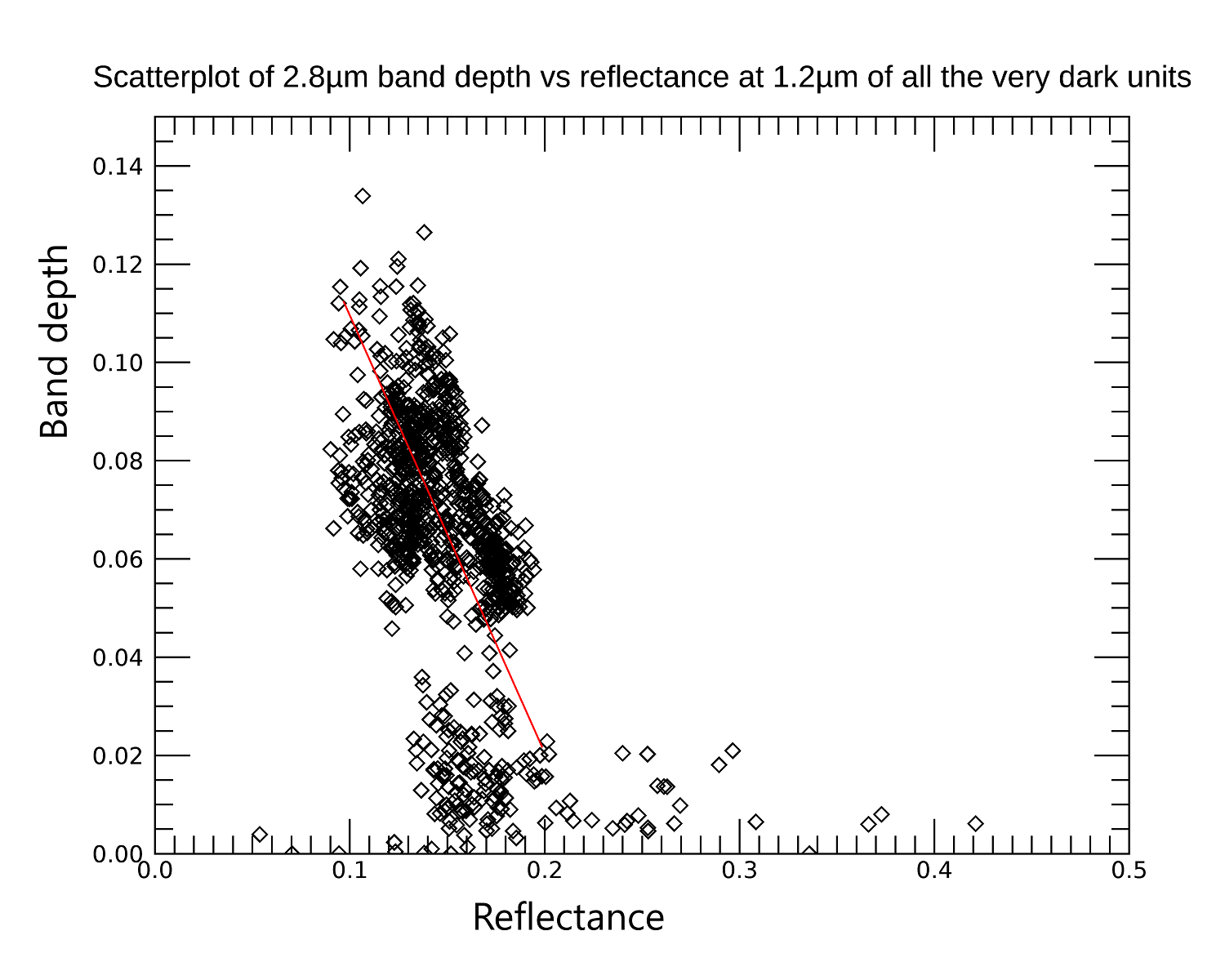
Figure 1: Anti-correlation between the 2.8 µm band depth and the reflectance of the surface.
We searched for the presence of possible combination bands centered around 2.2-2.4 µm. Weak features at 2.4 µm were found but no correlation with the 2.8 µm absorption band has been proved, so we can say that this feature is not related to the OH molecule and is likely a spectral artifact (Figure 2).
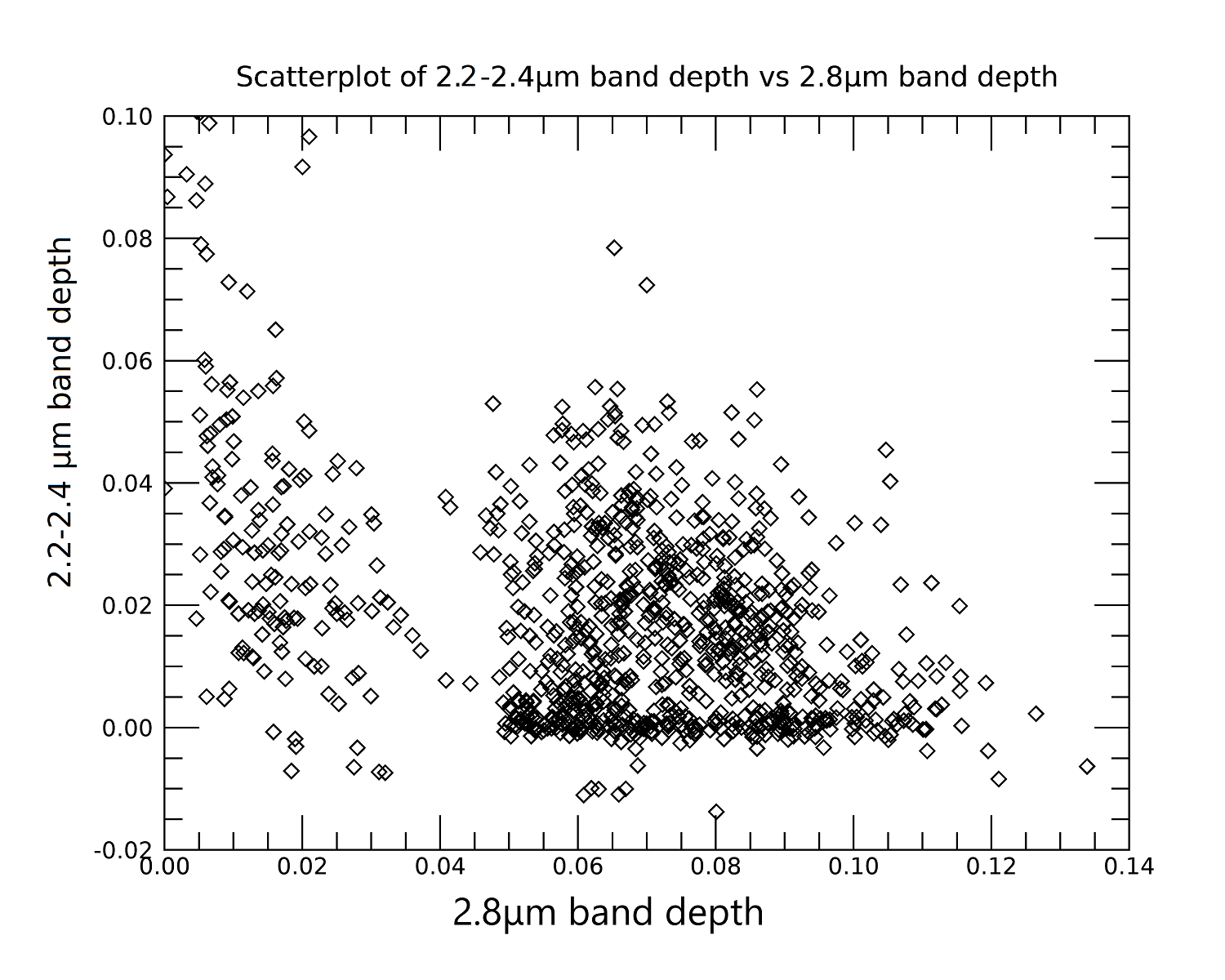
Figure 2: This scatterplot shows that the 2.4 µm feature is not correlated to the 2.8 µm absorption band.
Search for carbonates: We were not able to identify the 3.9 µm and the 3.4 µm absorption bands related to the presence of carbonates. This does not necessarily mean that carbonates are absent, but their abundance is not sufficient to observe an absorption band emerging from spectral noise. We compared VIR spectra with synthetic spectra of Vesta analogous mixtures (developed by applying a radiative transfer model) to calculate the upper limit of the abundance of carbonates on Vesta. The results show that carbonaceous chondrites that impacted on Vesta, contain no more than 0.5-2% of carbonates, in agreement with petrochemical analyses of typical Carbonaceous chondrites [5].
Caracterization in the visible range: The visible spectra showed an absorption band around 0.5 µm in addition to the strongest well known pyroxenes absorption band centered at 0.9 µm. We made a scatterplot between the 0.5 µm band depth and the 1.9 µm band depth related to the pyroxenes (Figure 3). In the scatterplot a linear dependance between the two features is evident. This proves that the 0.5 µm absorption band is due to the presence of the pyroxenes. Other features found in the visible range were instead associated to spectral artifacts. This emphasizes the results found by [6].
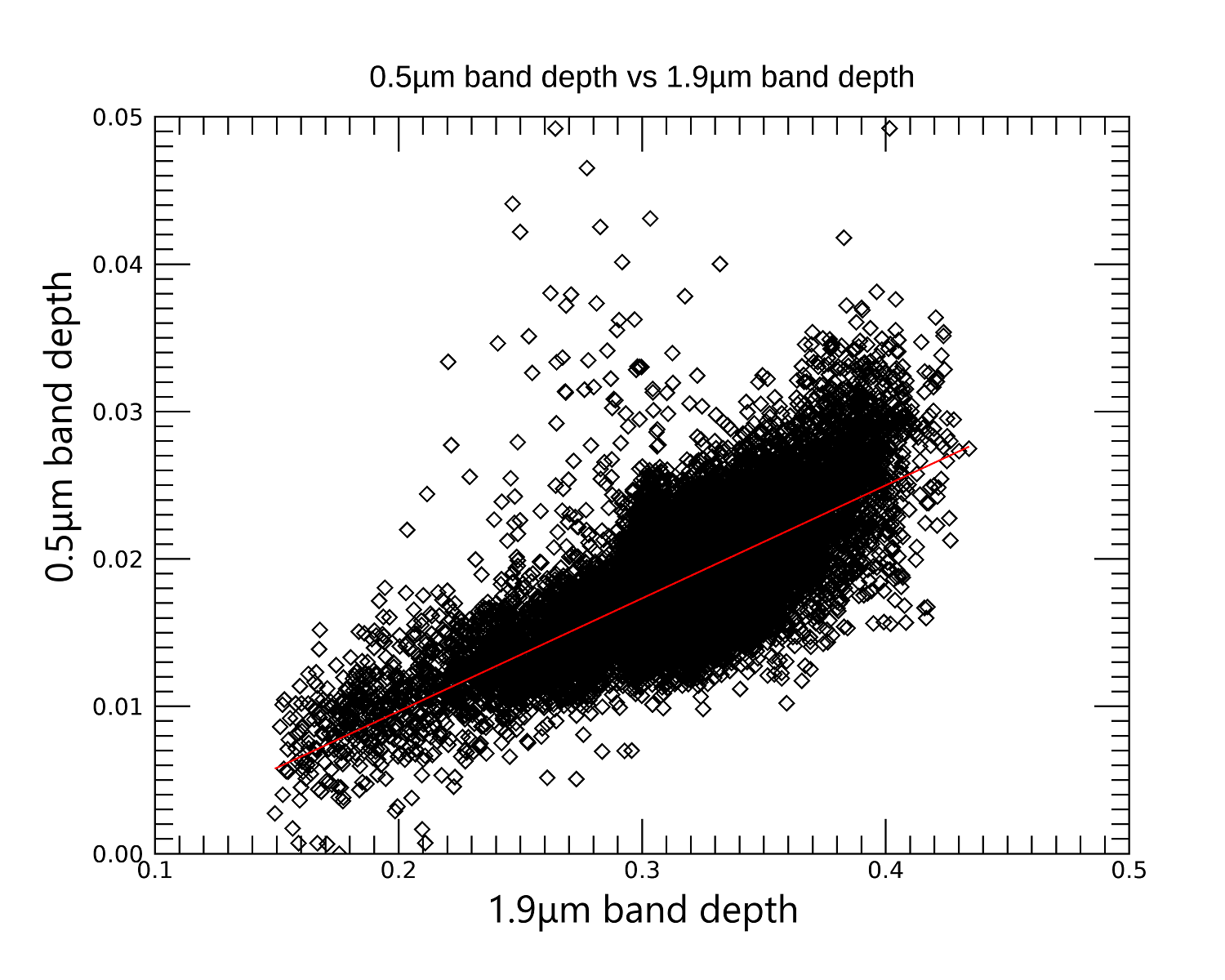
Figure 3: Correlation between the absorption band at 0.5 µm and the absorption band of the pyroxenes at 1.9 µm.
References:
[1] Palomba E. et al. (2014) Icarus, 240, 58–72.
[2] De Sanctis M. C. et al. (2011) SSR, 163, 329.
[3] De Sanctis M. C. et al. (2012) The astrophysical Journal Letters., 758.2, p. L36.
[4] McCord T. B. et al. (2012) Nature, 491.7422 , 83-86.
[5] de Leuw S., Rubin A. E., Wasson, J. T. (2010) Meteoritics & Planetary Science, 45.4, 513-530.
[6] Rousseau B. e al. (2021) Astronomy and Astrophysics, 653.
How to cite: Massa, G., Longobardo, A., Palomba, E., Angrisani, M., Gisellu, C., Dirri, F., De Sanctis, M. C., Raponi, A., Carrozzo, G., and Ciarniello, M.: Vesta surface composition as derived from newly calibrated Dawn data., Europlanet Science Congress 2022, Granada, Spain, 18–23 Sep 2022, EPSC2022-554, https://doi.org/10.5194/epsc2022-554, 2022.
The classification of the minor planets of the Solar System has been revisited regularly since its first outline in the 1970s as dichotomy of carbonaceous and silicaceous asteroids. The reformulations followed insights granted by new data (e.g. surveys such as ECAS, SMASS) or extensions of the observable feature space (e.g. CCD spectroscopy).
Since the last major update of the taxonomy by DeMeo et al. in 2009, we have seen a wealth of new data provided by targeted campaigns, which show that the spectroscopically-defined class boundaries do not align sufficiently with mineralogical and meteoritic population trends. Examples are the continuous trend between B- and C-type objects (Clark et al. 2010, De Leon et al. 2012) and the large subclassing of the continuous S-type asteroids (Vernazza et al. 2014). Furthermore, any compositional interpretation of members of the X-complex is tentative as shown by the diversity of radar albedos, densities, and spectral properties observed among them (Shepard et al. 2010, 2015, Carry 2012, Neeley et al. 2014).
Given the increase of data and insights into the compositional asteroid Main Belt, we derive a new iteration of the asteroid taxonomy, focusing primarily on a methodological improvement. Acknowledging that future survey efforts will contribute asteroid spectra in different wavelength ranges (e.g. Gaia (visible), SPHEREx (NIR), MITHNEOS (visible-NIR)), we evolve the current method into a probabilistic model approach which enables us to classify complete and partially observed spectra in the same scheme. We further re-introduce the visual albedo into the classification space to disentangle the degenerate X-complex.
By means of a clustering analysis of almost 3,000 minor body spectra and albedos, we devise a taxonomic scheme consisting of 17 classes with close resemblance to the Bus-DeMeo and Tholen systems (refer to Fig. 1): A, B, C, Ch, D, E, K, L, M, O, P, Q, R, S, X, V, Z. The two main complexes remain C and S. We resolve the X-complex and replace it by the new M-complex. Subclasses in the Bus-DeMeo system are replaced by a mineralogical interpretation of the continuous distribution of minor bodies in the classification space. The new class Z entails extremely-red objects in the inner Main Belt including the supposed TNO-implants (203) Pompeja and (269) Justitia (Hasegawa et al. 2021).
A python-tool to classify minor body observations in the derived taxonomic scheme is freely accessible to the community (https://classy.readthedocs.io).
Figure 1: Evolution of the asteroid taxonomy from the Tholen- (Tholen 1984) over the Bus-DeMeo- (Bus and Binzel 2002, DeMeo et al. 2009) to the system established in this work.
References
Clark, B. E., Ziffer, J., et al. (2010), Spectroscopy of B-type asteroids: Subgroups and meteorite analogs.
Carry, B. (2012), Density of asteroids.
Bus, S. J. and Binzel, R. P. (2002), Phase II of the Small Main-Belt Asteroid Spectroscopic Survey. A Feature-Based Taxonomy.
DeMeo, F. E., Binzel, R. P., et al. (2009), An extension of the Bus asteroid taxonomy into the near-infrared.
de León, J., Pinilla-Alonso, N., et al. (2012), Near-infrared spectroscopic survey of B-type asteroids: Compositional analysis.
Hasegawa, S., Marsset, M., et al. (2021), Discovery of Two TNO-like Bodies in the Asteroid Belt.
Neeley, JR., Clark, BE., et al. (2014), The composition of M-type asteroids II: Synthesis of spectroscopic and radar observations.
Shepard, M. K., Clark, B. E., et al. (2010), A radar survey of M- and X-class asteroids II. Summary and synthesis.
Shepard, M. K., Taylor, P. A., et al. (2015), A radar survey of M- and X-class asteroids. III. Insights into their composition, hydration state, & structure.
Vernazza, P., Zanda, B., et al. (2014), Multiple and Fast: The Accretion of Ordinary Chondrite Parent Bodies.
How to cite: Mahlke, M., Carry, B., and Mattei, P.-A.: A New Iteration of the Asteroid Taxonomy, Europlanet Science Congress 2022, Granada, Spain, 18–23 Sep 2022, EPSC2022-385, https://doi.org/10.5194/epsc2022-385, 2022.
Abstract
The Gaia mission of the European Space Agency (ESA) published its third release (DR3) on June 13, 2022, including for the first time a survey of 60 518 mean reflectance spectra of Solar System objects (SSOs). Each reflectance spectrum was derived from calibrated measurements obtained by the onboard Blue and Red low-resolution spectro-photometers (BP/RP) and consists of sixteen discrete wavelength bands, along with additional information about the data quality for each band.
We will describe the processing of the Gaia spectral data of SSOs and the steps of our internal validation procedures. We present the adopted approach for external validation against SSO reflectance spectra available in the literature, obtained from ground-based and space-borne telescopes, to assess the quality of Gaia SSO reflectance spectra. This work summarizes a more detailed description by Galluccio et al. (2022) [1].
- Introduction
Gaia DR3 contains information for a sample of more than 150,000 SSOs, including astrometry, photometry, osculating elements, and mean reflectance spectra [2]. The selection of these objects is described by Tanga et al. (2022) [2]. Based on the quality of the data and some criteria developed hereafter, DR3 contains 60518 mean reflectance spectra of Near-Earth Asteroids (NEAs), main-belt asteroids, Jupiter Trojans, transneptunian objects (TNOs), and other classes (Table 1) observed at relatively large phase angles (~20°).
Table 1: No. of SSOs with Gaia DR3 spectra for each of the dynamical classes listed on the NASA JPL website. The classes are defined according to the criteria based on the orbital semi-major axis a, the perihelion distance q, and the aphelion distance Q.
|
Dynamical Class |
No. of SSO |
Criterion (values in au) |
|
NEA Aten |
6 |
a < 1.0 & Q > 0.983 |
|
NEA Apollo |
52 |
a > 1.0 & q < 1.017 |
|
NEA Amor |
47 |
1.017 < q < 1.3 |
|
Mars-Crosser |
729 |
1.3 < q < 1.666 |
|
Inner Main Belt |
1 221 |
a < 2.0 & q > 1.666 |
|
Main Belt |
55 976 |
2.0 < a < 3.2 & q > 1.666 |
|
Outer Main Belt |
1 995 |
3.2 < a < 4.6 |
|
Jupiter Trojan |
477 |
4.6 < a < 5.5 |
|
Centaur |
5 |
4.6 < a < 5.5 |
|
TNO |
7 |
a > 30.1 |
|
Other |
2 |
none of the above |
- Production of SSO reflectance spectra
The first step in computing the SSO mean reflectance spectra consisted of a calibration of the BP/RP spectra and removal of all instrumental and astrophysical effects to produce internally calibrated epoch spectra [3]. Each of them is an array of 60 internal flux measurements and corresponding uncertainties, computed for each one of the 60 pixel-long XP (BP/RP). The BP operates in the wavelength range λ between 330 and 680 nm, and RP between 640 and 1050 nm. Next, BP and RP epoch reflectance R(λi)t were determined by dividing the flux ft(λi) of each SSO spectrum at the epoch t by the reference solar analogue spectrum F(λ). The latter has been computed by averaging Gaia DR3 mean spectra of several known solar analogue stars widely used in asteroid ground-based spectroscopy because their spectra closely mimic the one of our Sun. Epoch reflectance was then normalized at λ = 550 nm. To compute the mean reflectance spectrum, we first defined a set of fixed wavelength bands, each one having a width of 44 nm, in the interval from 374 nm to 1034 nm. Inside each wavelength band, we computed a weighted average reflectance using all epoch reflectance present in each bin after applying a sigma-clipping procedure (see Figure 1).
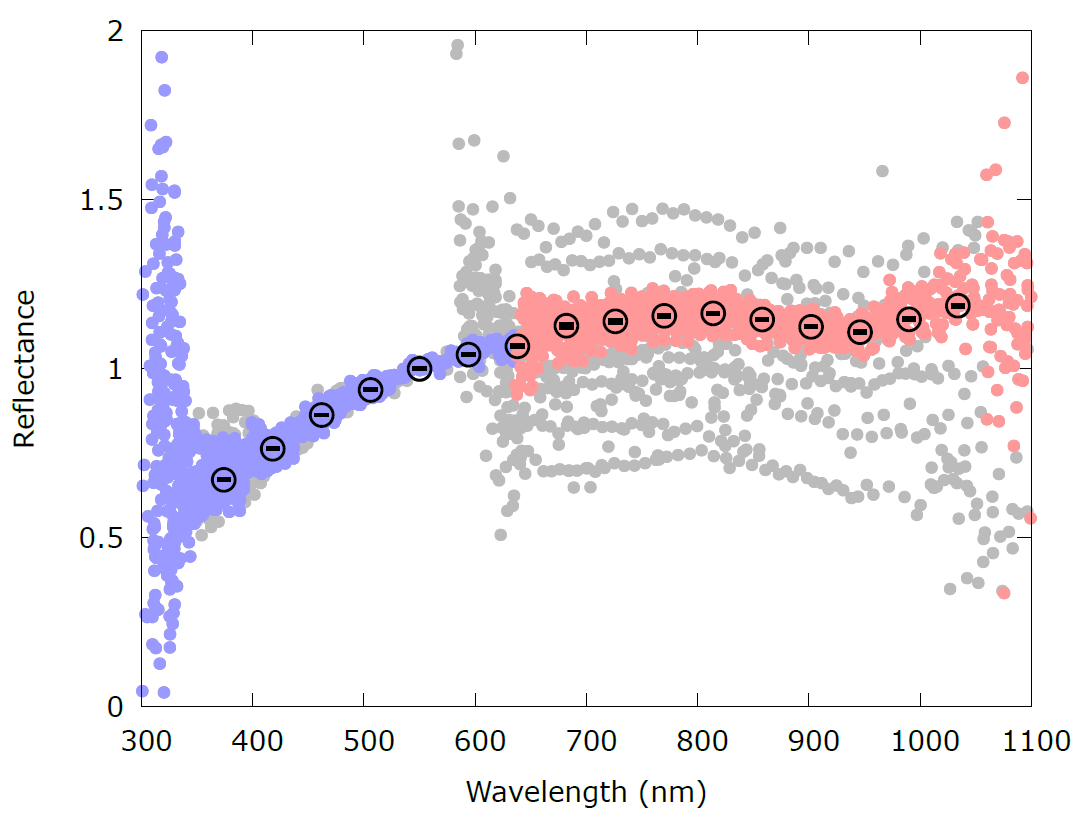
Figure 1: Example of the mean computed reflectance R(λi) (black circles) for the asteroid (61) Danae. The grey points are the R(λi)t corresponding to each epoch reflectance. The R(λi) t values accepted by our filtering method are coloured in blue (BP) and red (RP).
Some filters based on SNR and on quality criteria were finally applied to the sample of computed mean reflectance spectra. Along with the mean reflectance spectra, the Gaia DR3 catalogue also contains for each source a reflectance_spectrum_flag field, indicating the overall quality of the resulting reflectance spectrum.
- Validation
The validation of the Gaia DR3 mean reflectance spectra was obtained by studying and comparing spectral parameters including the spectral slope and the absorption band depth around 900 nm (equivalent to SDSS z-i colour) with those available in the literature, including the SMASSII survey [4] (Figure 2), ground-based observations at large phase angle [5] or space-borne telescope spectra. In general, Gaia DR3 mean reflectance spectra are in good agreement with the literature data. No significant spectral reddening was detected during the validation step.
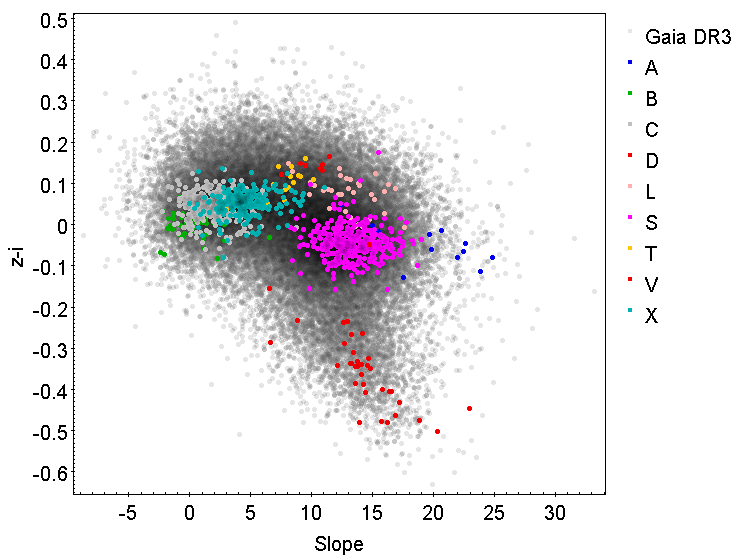
Figure 2: z colour vs. spectral slope of the asteroids of DR3 (grey dots). Over-plotted with circles of different colours are the same spectral parameters computed by us (see Section 4.2) for the asteroids of SMASSII [4]. The letters C, S, and X represent taxonomic complexes, the other letters spectral classes
- Conclusions
Gaia DR3 includes the largest space-based survey of reflectance spectra of Solar System small bodies observed at visible wavelengths with excellent quality. In the presentation of Delbo et al. (2022) at this conference some preliminary results about the Gaia view of asteroid collisional families will be described.
Acknowledgements
This work has made use of data from the European Space Agency (ESA) mission Gaia (https://www.cosmos.esa.int/gaia), processed by the Gaia Data Processing and Analysis Consortium (DPAC, https://www.cosmos.esa.int/web/gaia/dpac/consortium). Funding for the DPAC has been provided by national institutions, in particular the institutions participating in the Gaia Multilateral Agreement.
References
[1] Gaia collaboration, Galluccio, Delbo et al. 2022 Gaia Data Release 3: Reflectance spectra of Solar System Small Bodies. A&A under review.
[2] Gaia collaboration, Tanga et al. 2022 Gaia Data Release 3: the Solar System survey. A&A under review.
[3] De Angeli et al. 2022, Gaia Data Release 3: Processing and validation of BP/RP low-resolution spectral data A&A under review.
[4] Bus and Binzel. 2002. Icarus 158, 146-177.
[5] Cellino, Bendjoya, Delbo’ et al. 2020. A&A, 642, A80
How to cite: Galluccio, L., Delbo, M., De Angeli, F., Pauwells, T., Tanga, P., Mignard, F., Cellino, A., Brown, A. G. A., Muinonen, K., and Penttilä, A.: Survey of Solar system small bodies reflectance spectra in Gaia Data Release 3, Europlanet Science Congress 2022, Granada, Spain, 18–23 Sep 2022, EPSC2022-357, https://doi.org/10.5194/epsc2022-357, 2022.
The Gaia mission of the European Space Agency (ESA) was launched in December 2013 and began it scientific operations in July 2014. Gaia is essentially devoted to the measurement of positions, parallaxes, proper motions, brightnesses, and colours of stars. However, Gaia has also obtained astrometric, photometric, and spectroscopic measurements for several hundreds of thousands of asteroids.
The Gaia Data Release 3 (DR3) is the first to contain low resolution reflectance spectra of 60,518 solar system small bodies, the large majority of which are asteroids of the main belt (Gaia collaboration, Galluccio, Delbo et al. 2022). The global survey properties, the methods of data production and validation are detailed in the aforementioned paper published by the journal Astronomy and Astrophysics, which accompanies the DR3, and also summarised in the presentation of Galluccio et al. (2022) at this conference (EPSC 2022).
Here we present preliminary results about the Gaia view of asteroid collisional families. We identified asteroids belonging to families during the validation of Gaia asteroid spectra. Based on the family identification of Nesvorny et al. (2015), with the addition of the New Polana and the Eulalia families from Walsh et al. (2013), we found that in the Gaia DR3 there are 25,088 asteroids that belong to 116 collisional asteroid families of the 121 listed in Tab.1. This table also reports the number of family members and the number of members with a Gaia DR3 reflectance spectrum. However, the family identification of current catalogues is conservative by construction in order to keep good separation between the families. Hence, it is very likely that (i) some of the known families are more extended than what is available in current catalogues, namely, that catalogues based on dynamical criteria do not capture the whole extent of a family, and (ii) some unknown families are yet to be identified. This implies that the aforementioned number of asteroid family members with Gaia DR3 reflectance spectra is likely an estimation lower than the true number.
We will present some important features that Gaia observed in families. One of these is the correlation between some spectral parameters, such as the slope and the depth of the 1-micron absorption band of the reflectance spectrum, and the age of members of asteroid families belonging to the so called spectroscopic S-complex (DeMeo et al. 2009). These correlations can be explained in terms of a space weathering process that reddens and reduces the 1-band depth as a function of time on S-complex asteroids.
For the brightest asteroids, the extension of Gaia reflectance spectra at wavelengths shorter than 0.45 micron is very useful for distinguishing the composition of primitive, carbonaceous asteroid families, which are difficult to be discriminated with the ground based spectroscopic data currently present in the literature.
References:
- DeMeo, F. E., Binzel, R. P., Slivan, S.~M., Bus, S. J. 2009. Icarus 202, 160–180.
- Gaia collaboration, Galluccio, Delbo et al. 2022. A&A under review.
- Nesvorný, D., Brož, M., & Carruba, V. 2015. in Asteroids IV (P. Michel, et al. eds.) University of Arizona Press, Tucson.,
- Walsh, K. J., Delbo, M., et al. 2013. Icarus 225, 283–297.
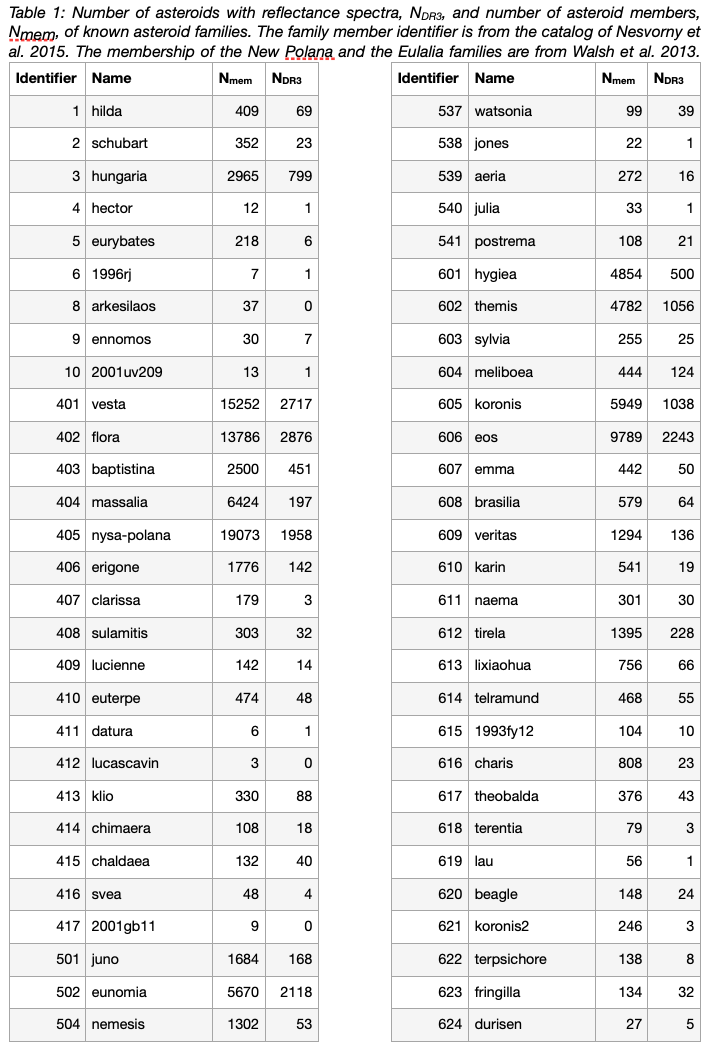
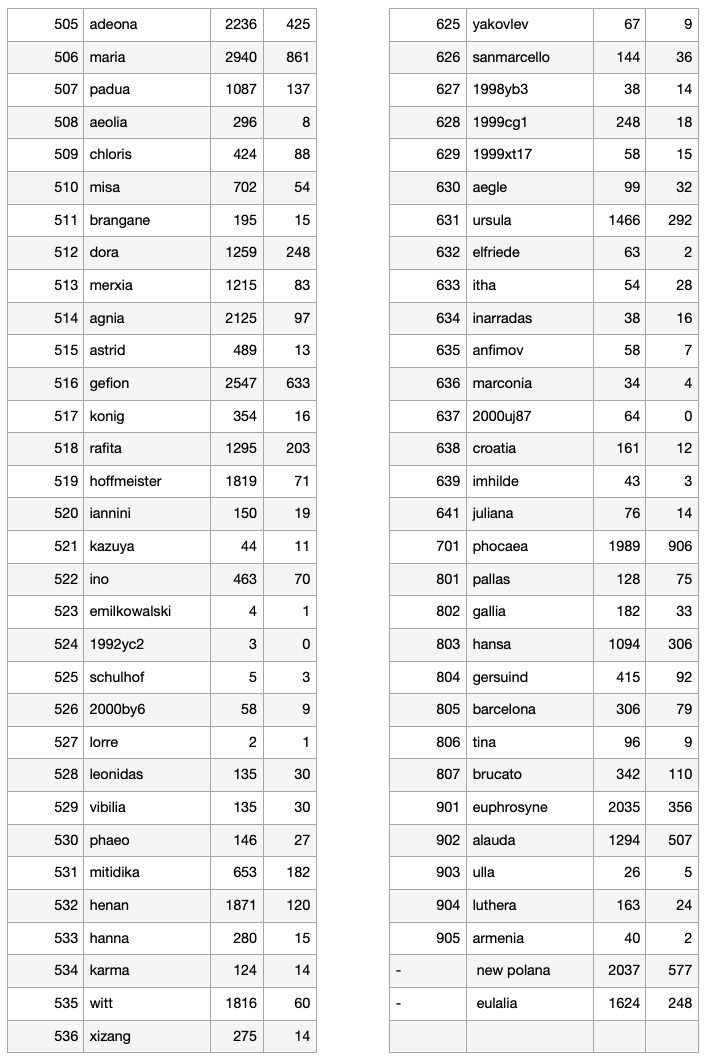
How to cite: Delbo, M., Galluccio, L., De Angeli, F., Pauwels, T., Tanga, P., Miagnard, F., Cellino, A., Brown, A., Muinonen, K., and Penttila, A.: Gaia spectroscopic view of asteroid collisional families: preliminary results, Europlanet Science Congress 2022, Granada, Spain, 18–23 Sep 2022, EPSC2022-237, https://doi.org/10.5194/epsc2022-237, 2022.
Long-awaited, Gaia Data Release 3 was published 2022, on June 13th and contains ultra-precise astrometric measurements for over 150 000 small bodies in the Solar System (Tanga et al. 2022). Compared to Gaia DR2, this release will contain a longer observational arc which is crucial in finding subtle non-gravitational forces, such as the Yarkovsky effect (A2 or da/dt). The main consequence of this perturbation is a secular drift of the semi-major axis (a) of small bodies.
The influence of Gaia data in the determination of the Yarkovsky effect has already been proven (Gaia Collaboration, Spoto et al. 2018, Spoto et al. 2019, Dziadura et al. 2022, Tanga et al. 2022). This effect is now quite well known for Near-Earth Asteroids but still remains hard to detect especially for objects in the Main Belt.
So far we have tried to detect the Yarkovsky effect for all NEAs, Mars Crossers and MBA objects available in Gaia DR2 (606 objects). We used the new weighting scheme (Spoto et al., in preparation) which contains weights for observations depending on: the observatory code, the stellar catalogue used for reduction, the epoch of the observations, and a given magnitude class. We present our result in Fig. 1. The S value represents S = A2(this work)/A2(expected) where the expected value is determined as in Spoto et al. (2015). There are 13 asteroids which meet the conditions of S > 2 and SNR > 3 (green points), all of them are NEAs. In Fig. 2 and 3 we plotted the same asteroids in dependency of diameter (d) and semimajor axis respectively. As expected we conclude that even with Gaia DR2, this effect still remained difficult to detect for Mars Crossers and MBAs.
We present preliminary results obtained from Gaia DR3. We selected all the objects with a diameter < 5 km and we compared our detected value to the expected value determined based on the physical and orbital parameters of the objects.
Acknowledgements
This work presents results from the European Space Agency (ESA) space mission Gaia. Gaia data are being processed by the Gaia Data Processing and Analysis Consortium (DPAC). Funding for the DPAC is provided by national institutions, in particular the institutions participating in the Gaia MultiLateral Agreement (MLA). The Gaia mission website is https://www.cosmos.esa.int/gaia. The Gaia archive website is https://archives.esac.esa.int/gaia.
The research leading to these results has received funding from the Ministry of Science and Higher Education of Poland in the years 2018/2022, as a research project under the ‘‘Diamond Grant’’ program, grant number 0062/DIA/2018/47.
References
Tanga et al. 2022, Gaia Data Release 3: the Solar System Survey, 2022, submitted to A&A
Gaia Collaboration, Spoto et al. 2018: Gaia Data Release 2: Observations of Solar System Objects, 2018, A&A
Spoto, F., Tanga, P., & Carry, B. (2019, September). Direct detections of the Yarkovsky drift with Gaia DR2. In EPSC-DPS Joint Meeting (p. 182)
Dziadura, K., Oszkiewicz, D., & Bartczak, P. (2022). Investigating the most promising Yarkovsky candidates using Gaia DR2 astrometry. Icarus, 115040
Spoto, F., Milani, A., & Knežević, Z. (2015). Asteroid family ages. Icarus, 257, 275-289
Del Vigna, A., Faggioli, L., Milani, A., Spoto, F., Farnocchia, D., & Carry, B. (2018). Detecting the Yarkovsky effect among near-Earth asteroids from astrometric data. Astronomy & Astrophysics, 617, A61
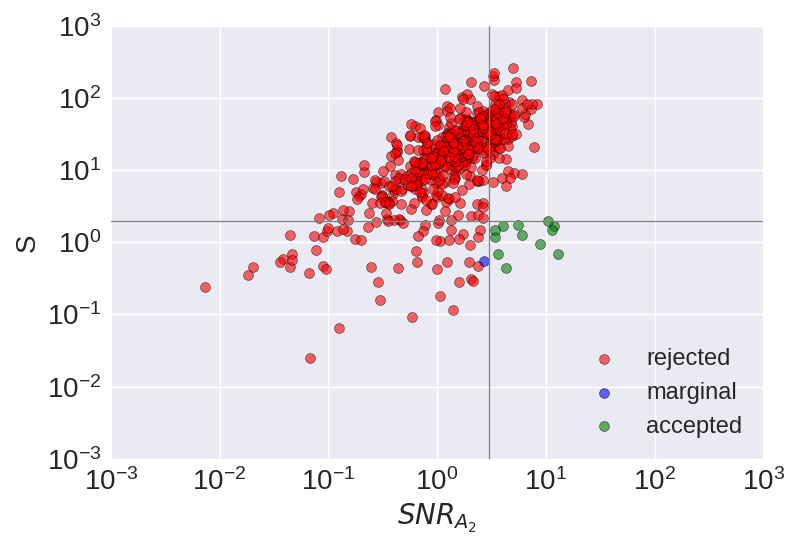
Figure 1. S parameter as a function of signal to noise ratio SNRA2. Green circles represent accepted values (SNRA2 > 3 and S < 2) - consistent with expected value determined, blue circles are marginal cases (2.5 < SNRA2 < 3 and S < 2), and red are values with SNRA2 > 3 or S > 2.5. Horizontal line represents S = 2. The Vertical line represents SNRA2 = 3. (Del Vigna et al. 2018)
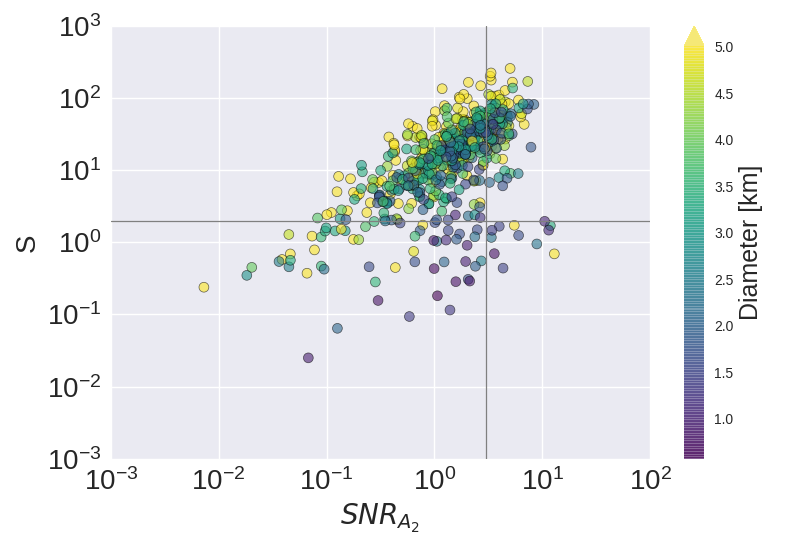
Figure 2. The Color bar represents the dependence of the asteroid's diameter. If the diameter was not available in JPL it was calculated from the absolute magnitude. Axes as in Figure 1.
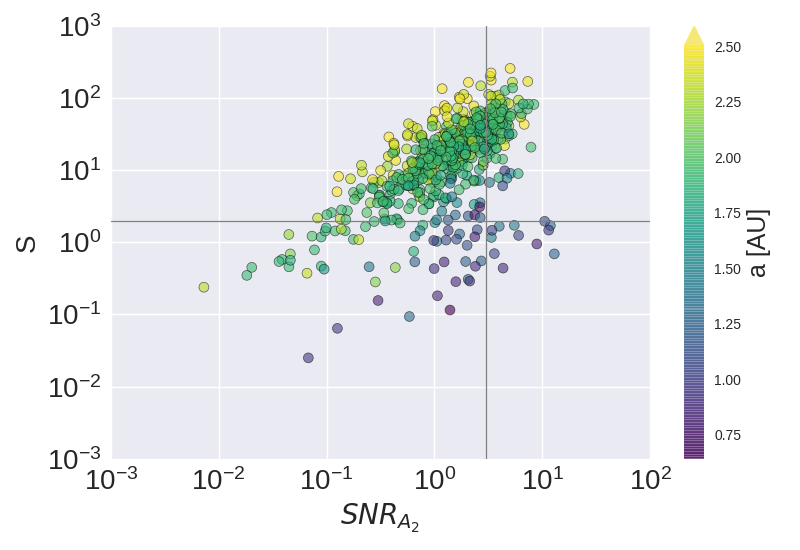
Figure 3. The Color bar represents the dependence of the asteroid's semimajor axis. Axes as in Figure 1.
How to cite: Dziadura, K., Spoto, F., Oszkiewicz, D., Carry, B., Bartczak, P., and Tanga, P.: Computing the Yarkovsky effect for asteroids in Gaia DR3, Europlanet Science Congress 2022, Granada, Spain, 18–23 Sep 2022, EPSC2022-649, https://doi.org/10.5194/epsc2022-649, 2022.
Please decide on your access
Please use the buttons below to download the presentation materials or to visit the external website where the presentation is linked. Regarding the external link, please note that Copernicus Meetings cannot accept any liability for the content and the website you will visit.
Forward to presentation link
You are going to open an external link to the presentation as indicated by the authors. Copernicus Meetings cannot accept any liability for the content and the website you will visit.
We are sorry, but presentations are only available for users who registered for the conference. Thank you.
Posters: Mon, 19 Sep, 18:45–20:15 | Poster area Level 2
Outer main belt asteroid (223) Rosa has been proposed as potential ESA JUICE mission flyby target of opportunity on its way to Jupiter (Avdellidou et al. 2021, Agostini et al. 2022). Rosa is a very dark (p < 0.05) object, with an effective diameter D of about 83 km. The very low albedo and the featureless red spectra indicate a P-type asteroid in the Tholen taxonomy, though the yet known bulk density estimates (2.0 ± 1.1 g cm−3 and 3.1 g cm−3; derived from masses by Fienga et al. 2019 and Park et al. 2021; see also Avdellidou et al. 2021) did not match very well this classification.
Aim of this work was to derive new estimates for the mass and for the bulk density for (223) Rosa. From the gravitational deflection on two small 'test' asteroids during close encounters with the perturber, namely (35525) 1998 FV64 on 2010-12-31.87 and (315162) 2007 FL24 on 2016-07-04.05, the mass of Rosa was derived as M = (3.62 ± 1.25) × 1017 kg (weighted mean of both results). This yields to a bulk density ρ = 1.2 ± 0.5 g cm−3, when adopting an effective diameter of D = 83 ± 8 km, as average of the available literature values. This density agrees well with typical densities for P-type asteroids like (87) Sylvia and (107) Camilla (ρ ≈ 1.3 g cm−3 ; see e.g. Carry et al. (2021), Vernazza et al. (2021)).
References
Agostini, L., Lucchetti, A., Pajola, M., et al. 2022, Planetary and Space Science, 216, 105476
Avdellidou, C., Pajola, M., Lucchetti, A., et al. 2021, A&A, 656, L18
Fienga, A., Deram, P., Viswanathan, V., et al. 2019, Notes Scientifiques et Techniques de l’Institut de Mecanique Celeste, 109
Carry, B., Vernazza, P., Vachier, F., et al. 2021, A&A, 650, A129
Park, R. S., Folkner, W. M., Williams, J. G., & Boggs, D. H. 2021, AJ, 161, 105
Vernazza, P., Ferrais, M., Jorda, L., et al. 2021, A&A, 654, A56
How to cite: Kretlow, M.: An astrometric mass estimate for asteroid (223) Rosa, Europlanet Science Congress 2022, Granada, Spain, 18–23 Sep 2022, EPSC2022-42, https://doi.org/10.5194/epsc2022-42, 2022.
Most asteroids are slow rotators
Results from space missions like Kepler and TESS (Molnar et al. 2018; Pal et al. 2020), but also ground-based surveys e.g. ATLAS and ZTF (Erasmus et al. 2021) reveal unexpectedly large numbers of slowly rotating asteroids in the main belt, with periods reaching up to a few thousand hours. Actually majority of asteroids rotate slowly, with periods impossible to be fully covered during one night. As a consequence, their spin and shape models are mostly missing, skewing the big picture of asteroids spins, shapes, sizes and other properties.
Our long-term project (see e.g. Marciniak et al. 2015; and 2021) targets a few tens of slow rotators with periods up to 60 hours, to obtain their full lightcurves in an efficient world-wide observing scheme. Dense lightcurves then serve for spin and shape reconstructions via lightcurve inversion. Recently we launched a special campaign among stellar occultation observers1,2, to put these models into scale, and also to verify the shape solutions, often allowing to break the mirror-pole ambiguity.
Sample result
Our lightcurve survey resulted e.g. in a rich enough lightcurve dataset to create unique spin and shape model of asteroid (439) Ohio, a challenging slow rotator displaying 37-hours period. At the same time, two successful, multi-chord stellar occultations by this asteroid have been registered within the "slow rotators" campaign in March 2022. Together with one archival occultation from PDS database (Herald et al., 2019) they allowed us to precisely scale our shape model of (439) Ohio using the method by Durech et al. (2011). This has independently confirmed the size and location of shape features down to single kilometers on this 74-km body (see the figure below).

Fig. 1. Shape model of asteroid (439) Ohio (blue contours) fitted to chords from three stellar occultations (black lines). Grey segments denote occultation timing uncertainties. North is up and west is right. Volume equivalent diameter: 74 +/- 2 km.
Conclusions and future prospects
Presented scheme resulted recently in obtaining quality shape models for 15 slow rotators, most of them for the first time. Sizes determined from fitting these models to stellar occultations agree with sizes from infrared space missions WISE (Wright et al. 2010), IRAS (Neugebauer et al. 1984), and AKARI (Usui et al. 2011), yet providing better accuracy, or resolving previous inconsistencies in size determinations in some cases. That stems from creating robust spin and shape models instead of spherical shape approximation with unknown spin used in Simple Thermal Model (Harris & Lagerros 2002). For roughly half of the targets this fitting allowed to reject one of two mirror pole solutions, clearly pointing to the preferred one, thus removing the ambiguity inherent to lightcurve inversion. Such well determined and scaled asteroid shapes will e.g. constitute a solid basis for precise density determinations, once their masses are available (for some of our targets expected already from Gaia mission). Spin and shape models in general keep filling the gap caused by various biases.
Acknowledgements: This work was supported by the National Science Centre, Poland, through grant no. 2020/39/O/ST9/00713.
References:
Durech, J., Kaasalainen, M., Herald, D. et al. 2011, Icarus 214, 652
Erasmus, N., Kramer, D., McNeill, A. et al. 2021, MNRAS 505, 3872
Harris, A. W., Lagerros, J. S. V. 2002, in Asteroids III, 205
Herald, D., Frappa, E., Gault, D., et al. 2019, Asteroid Occultations V3.0, NASA Planetary Data System
Marciniak, A., Pilcher, F., Oszkiewicz, D., et al. 2015, Planet. Space Sci., 118, 256
Marciniak, A., Durech, J., Ali-Lagoa, V., et al. 2021, A&A, 657, A87
Molnar, L., Pal, A., Sarneczky, K., et al. 2018, ApJS, 234, 37
Neugebauer, G., Habing, H. J., van Duinen, R., et al. 1984, ApJ, 278, L1
Pal, A., Szakats, R., Kiss, C., et al. 2020, ApJS, 247, 26
Usui, F., Kuroda, D., Mueller, T. G., et al. 2011, PASJ, 63, 1117
Wright, E. L., Eisenhardt, P. R. M., Mainzer, A. K., et al. 2010, AJ, 140, 1868
1https://www.iota-es.de/neglected_asteroids.html
2https://cloud.occultwatcher.net/campaigns
How to cite: Marciniak, A., Durech, J., Choukroun, A., Frappa, E., and Beisker, W. and the Two teams of observers: Focus on slow rotators - first results from stellar occultations campaign on long-period asteroids, Europlanet Science Congress 2022, Granada, Spain, 18–23 Sep 2022, EPSC2022-224, https://doi.org/10.5194/epsc2022-224, 2022.
1. Introduction
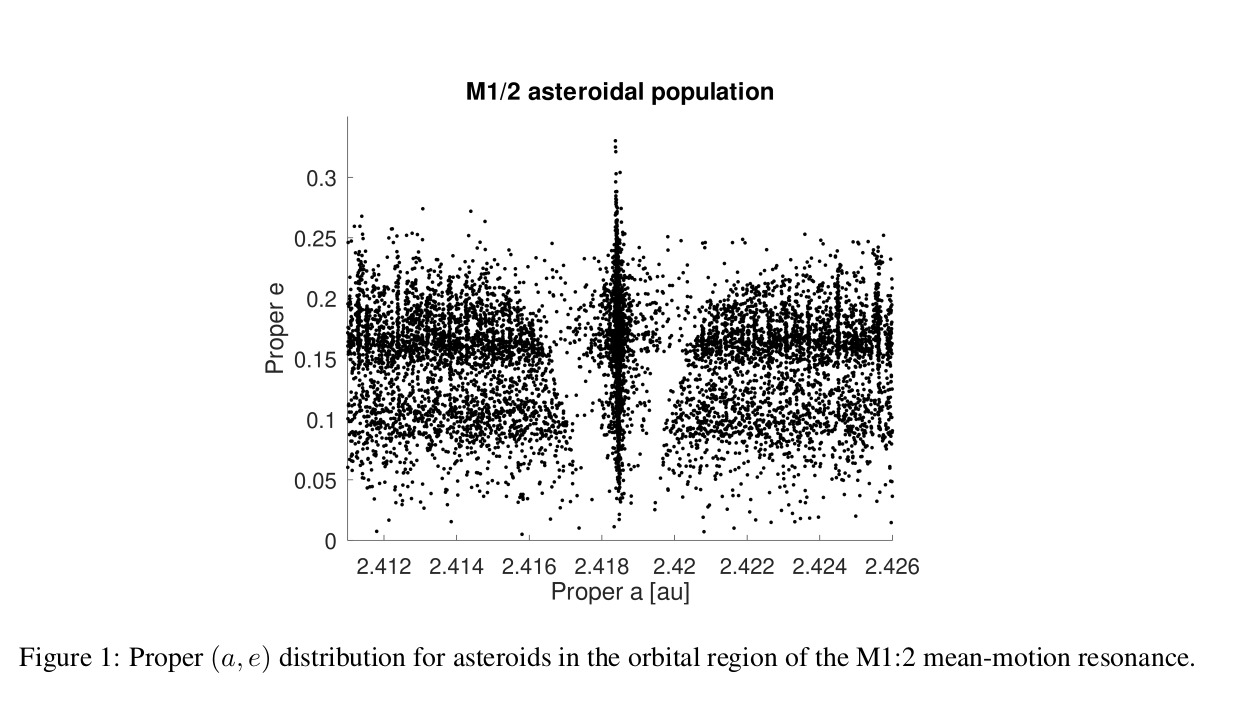
During the last five years, machine learning and deep learning have been used more commonly in the field of asteroid dynamics. Artificial neural networks have been recently used for identifying members of asteroid families [6]. This is the first attempt to use deep learning for the automatic classification of images of asteroids resonant arguments. The population of asteroids inside the M1:2 mean motion resonance with Mars was studied by [4]. The V-shaped region at the resonance center in the proper (a, e) plane (see figure (1)) is associated with the M1:2 resonance. [4] defines two main resonant arguments. σ is given by:
where λ = M + Ω + ω is the mean longitude, ϖ = Ω + ω, with Ω the longitude of the node, ω the argument of pericenter, and where the suffix M identifies the planet Mars. σ1 is defined as:
The orbital behavior of asteroids in the affected region can be identified by studying the time dependence of these two angles. Asteroids for which the critical arguments cover the whole range of values, from 0◦ to 360◦, are on circulating orbits. If the argument oscillates around an equilibrium point, we have a librating orbit. Whether the argument alternates phases of libration and circulations we have a switching orbit, as defined in this work. The main equilibrium point for the σ1 argument is near 0◦. Pure σ librators tend to be much rarer than pure σ1 ones. Since in this work we are interested in treating a multi-class problem we focus our study on the case of the σ1 resonant argument.
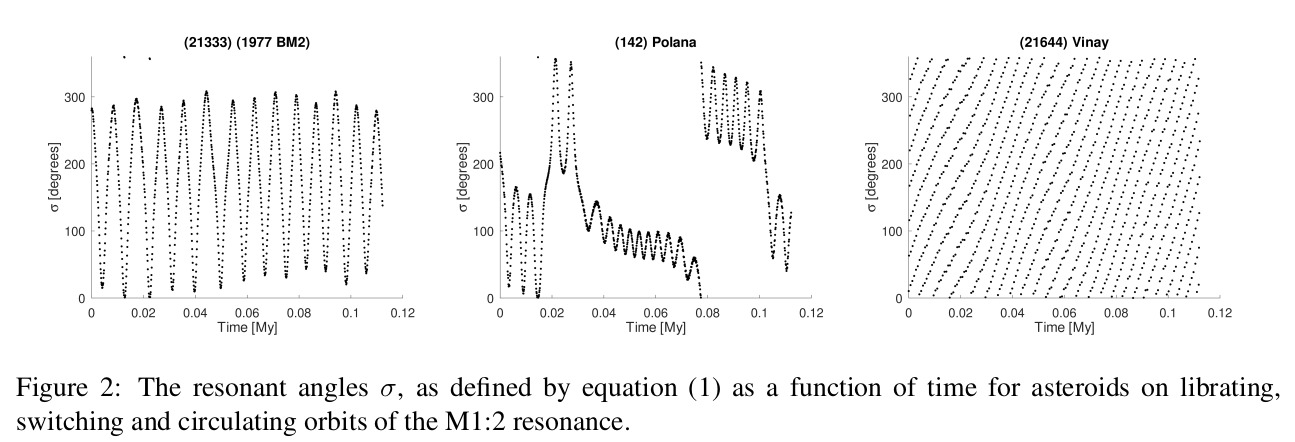
2. Artificial Neural Networks (ANN)
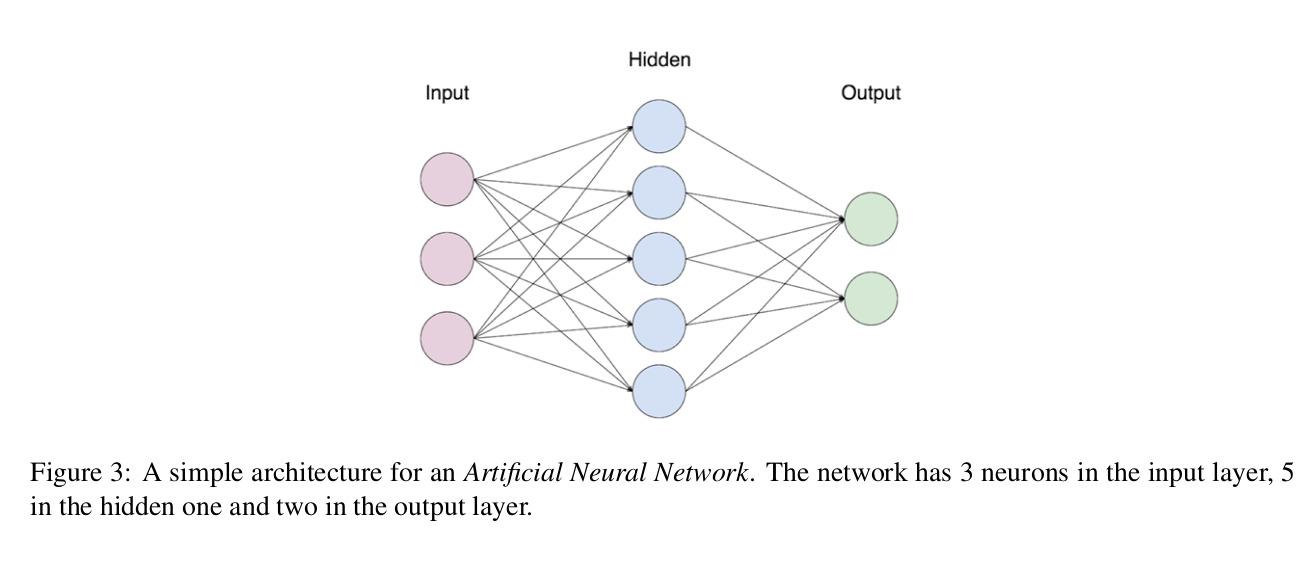
Artificial neuron networks mimic the neuron's web in a biological brain. Each artificial neuron can transmit a signal to other neurons. This signal can be processed, and the signal coming out of each neuron is computed as a non-linear function of the inputs. A basic architecture for ANN consists of an input and an output layers, with the possible presence of one or more hidden layers between them to improve the model precision. Each neuron will perform a weighted sum, WS, given by:
where n is the number of input to process, Xi are the signals from other neurons, and wi are the weights. ANN will optimize the values of the weights during the learning process. On the weighted sum WS, ANN will apply an activation function. For images classifications, one of the most used activation function is the “relu”, defined as:
which will produce as an outcome the weighted sum itself WS, if that is a positive number, or 0, if WS has a negative value. As a next step, the loss function must be applied to all the weights in the network through a back-propagation algorithm. A loss function is usually calculated by computing the differences between the predicted and real output values. Interested readers can find more information in the Keras documentation (https://keras.io/, [5]).
3 Applications of ANN to M1:2
Here, we used the Keras implementation of ANN, which is based on the Tensorflow Python software package [2]. The process used in this work is the following:
1. The asteroid orbits are integrated under the gravitational influences of the planets.
2. We compute the resonant arguments.
3. Images of the time dependence of resonant arguments are drawn.
4. The ANN trains on the training label image data.
5. Predictions on the test images are obtained, and images of the test data, with their classification, are produced.
To identify resonant argument images, we created a four-layer model with a flatten, an inner, a hidden, and an output layers. The flatten layer will transform the image matrices into arrays. The inner layer will look for simpler patterns in the arguments images, while the hidden layer will search for more complex features. The output layer, with three nodes, will perform the final classification for the three possible classes. To quantitatively classify the outcome of ANN, it is often useful to compute values of metrics. [3] defines accuracy as:
Our model performs quite well: Accuracy values were all above 0.996.
4. ML identification of resonant groups
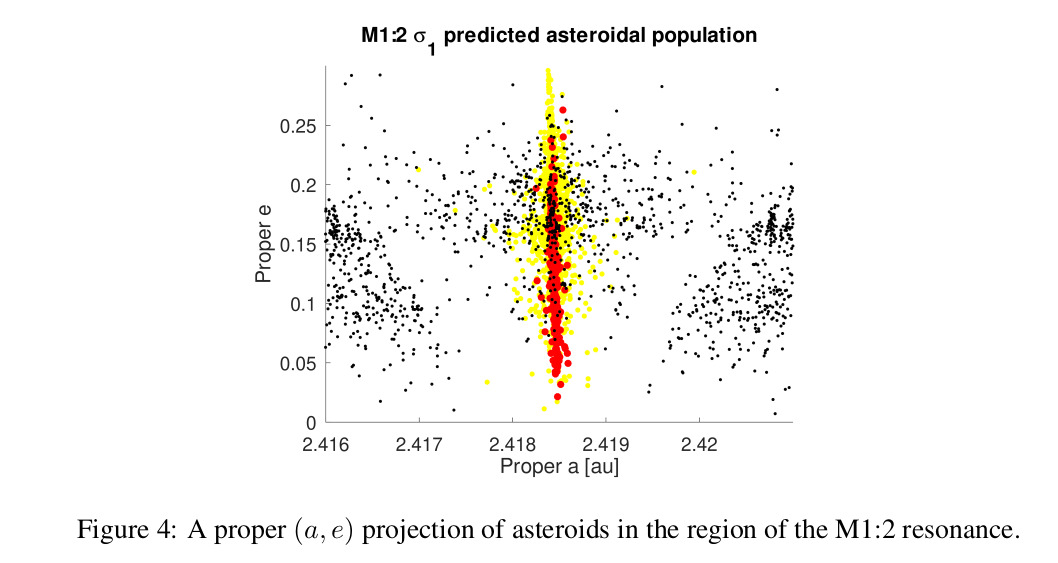
Using ANN and ML, we obtained labels for 6440 asteroids in the M1:2 resonance region. We then used the ML Hierarchical Clustering Method (ML-HCM) of [1] to identify asteroid groups among the resonant population of M1:2 resonators. Our analysis produced seven possible groups, all associated with the Massalia, Nysa, and Vesta families. This confirms the analysis of [4].
5. Summary and Conclusions
The use of ANN allowed us to classify the orbital type of all numbered asteroids affected by the M1:2 resonance. The identification of clusters in the population of asteroids in librating and switching orbits suggested that three asteroid families, those of Massalia, Nysa, and Vesta, are the most dynamically affected by this resonance.
Acknowledgements
We would like to thank the Brazilian National Research Council (CNPq, grant 301577/2017-0). More information on this work can be obtained from Carruba et al. (2021), MNRAS, 504, 692.
References
[1] CARRUBA, V., ALJBAAE, S., AND LUCCHINI, A. Machine-learning identification of asteroid groups. MNRAS 488, 1 (Sept. 2019), 1377–1386.
[2] CHOLLET, F., AND OTHERS. Keras: The Python Deep Learning library, (June 2018).
[3] FAWCETT, T. An introduction to ROC analysis. Pattern Recognition Letters 27, 8 (Jun. 2006), 861 –874.
[4] GALLARDO, T., VENTURINI, J., ROIG, F., AND GIL-HUTTON, R. Origin and sustainability of the population of asteroids captured in the exterior resonance 1:2 with Mars. Icarus 214, 2 (Aug. 2011), 632–644.
[5] LECUN, Y., BENGIO, Y., AND HINTON, G. Deep learning. Nature 521, 7553 (May 2015), 436–444.
[6] VUJIČIĆ, D., PAVLOVIĆ, D., D., M., Ð ORÐEVIĆ, S., S., R., AND D., S. Classification of asteroid families with artificial neural networks. Serb. Astron. J. 200 (Dec. 2020), 1–8.
How to cite: Carruba, V., Aljbaae, S., Domingos, R. C., and Barletta, W.: Artificial Neural Network classification of asteroids in the M1:2 mean-motion resonance with Mars., Europlanet Science Congress 2022, Granada, Spain, 18–23 Sep 2022, EPSC2022-245, https://doi.org/10.5194/epsc2022-245, 2022.
Introduction
The main belt asteroid 4429 Debussy belongs to a unique group among binary asteroids in the Solar System which are known as synchronous binary, the systems with two bodies having comparable sizes and with the same rotational and orbital period. Photometric observations of these objects are still the main source of their physical properties. Lightcurves for synchronous binary systems are not quasi-sinusoidal as for most asteroids, but have very characteristic U-V shape due to the rotation of nonspherical bodies and caused by mutual eclipses. The collection of data from apparitions over several years (evenly distributed along the ecliptic longitudes), allows to determine key parameters of such binary systems (such as a non-convex shape solution and the object's spin-axis orientation) (Bartczak et al., 2014, Bartczak et al., 2017, Kryszczyńska et al., 2008).
The ultimate goal of this kind of sophisticated spin-shape modeling is to determine the asteroid's density. It is indicative of the internal structure of the body and also puts constraints on its composition. However, the estimation of density is based on mass and volume. The determination of the volume of an asteroid requires a detailed shape solution, and information about the absolute size. Our main goal of modelling Debussy is calculating a new non-convex model with its uncertainties, which are crucial in further analysis (like radiometric studies) and for the estimation of other parameters (like thermal surface properties or bulk density).
4492 Debussy
The binary nature of Debussy was discovered in 2002 (Behrend et al., 2004), when photometric observations showed a lightcurve with typical features for eclipsing binaries - the amplitude of light changes (of about 0.5 mag) corresponding to the rotation of two nonspherical bodies, and two minima (about 0.6 mag deep) due to their mutual eclipses. Further observations showed that the rotation period is P = 26.5811 ± 0.0002 h (Polińska et al., 2008). Since 2002 Debussy has been observed at almost all ecliptic longitudes evenly distributed along the orbit. All gathered data present lightcurves with deep minima caused by mutual eclipses. This means that the edge of the orbit of the binary system always points towards the observer.
Modelling
The spin-shape model of the Debussy system is calculated in the same way as for 90 Antiope (Bartczak et al., 2014) and 809 Lundia (Bartczak et al., 2017, Kryszczyńska et al., 2008), using the genetic-algorithm-based modelling method SAGE (Shaping Asteroids with Genetic Evolution). The SAGE method is based on photometric observations from several apparitions. The modelling process works best for observations obtained with different and evenly distributed ecliptic longitudes. It allows to create non-convex shape, spin axis orientation and rotational period of synchronous binary asteroids. With the new model we would like to demonstrate the recently developed shape uncertainty method for binary objects in the same way as it was done for single asteroids and described in Bartczak & Dudziński (2019).
4492 Debussy was detected in the AKARI infrared survey and also during the cryogenic phase of WISE (calibrated fluxes were taken from the Database for thermal IR observations of small bodies, see Szakats et al. 2020). In addition, there is a dedicated Spitzer-IRS spectrum available (Marchis et al. 2012). We used the available thermal measurements to determine the size (size of an equal-volume sphere), the geometric albedo and the thermal inertia of Debussy via a well-tested thermophysical model (see e.g., Müller et al. 2017). For the radiometric study, we considered Debussy's derived spin properties, as well as different simple, convex, and non-convex shape solutions.
References
Behrend et al., 2004, IAU Circ., No. 8354
Bartczak et al., 2014, MNRAS, 443, 1802
Bartczak et al., 2017, MNRAS, 471, 1, 941-947
Bartczak P. & Dudziński G., 2019, MNRAS, 485, 2, 2431-2446
Kryszczyńska et al., 2008, A&A 501, 769-776
Marchis et al. 2012, Icarus 221, 1130
Müller et al. 2017, A&A 599, A103
Polińska et al., 2008, ACM paper id. 8134
Szakats et al. 2020, A&A 635, A54
How to cite: Polińska, M., Bartczak, P., and Müller, T. and the SAGE Team: New modeling of 4492 Debussy eclipsing binary asteroid, Europlanet Science Congress 2022, Granada, Spain, 18–23 Sep 2022, EPSC2022-286, https://doi.org/10.5194/epsc2022-286, 2022.
Up to now, only (4) Vesta has been identified as the source of differentiated material, which has been discovered all around the Main Belt region. Most of the basaltic asteroids, identified through spectroscopic measurements, are located in the inner main belt region (2.15-2.5AU) and constitute the Vesta family. These asteroids are indeed dynamically linked to Vesta and share similar spectroscopic properties, showing the absorption bands at 0.92-0.94 micron and 2.0 micron, which are indicative of a basaltic composition. From a dynamical point of view, these objects have proper semimajor axis ap, eccentricity ep and inclination ip in the ranges 2.26 < ap < 2.48, 0.075 < ep <0.122 and 5.6° < ip < 7.9°, respectively (Nesvorny et al. 2015). In addition, a faint absorption band at 0.506 micron, due to a spin forbidden transition of Fe2+, was recently detected also in some V-type asteroids, both members and non-members of the Vesta family (Migliorini et al. 2021).
Ground-based observations have shown that few asteroids distributed beyond the 3:1 MMR (Mean Motion Resonance) at 2.5 AU have a basaltic composition (Lazzaro et al. 2000; Hardersen et al. 2004, 2018; Roig et al. 2008; De Sanctis et al. 2011; Solontoi et al. 2012; Ieva et al. 2018; Leith et al. 2017; Migliorini et al. 2018, 2021; Medeiros et al. 2019), although with some differences with respect to Vesta and its family members (Jasmim et al. 2013). Thus, their origin seems to be likely linked to the break-up of large, differentiated objects other than Vesta. Dynamical studies allowed the identification of possible asteroid families, like (221) Eos, (1272) Gefion and (1040) Klumpkea families, which could be the result of the disruption of a differentiated or partly-differentiated parent body. These asteroid families include members with very different spectral types, including basaltic asteroids. Among the asteroids we observed in a previous ground-based campaign, some confirmed V-type asteroids were found to be members of these identified asteroid families, while others lay close to these asteroid families (Migliorini et al. 2021).
In the figure below, confirmed basaltic asteroids located beyond 2.5 AU are shown in the proper a- proper I plane and indicated with a circle. Asteroid families are also marked with different colors. Some objects classified as M- (crosses) and A- type (triangles) are also included.
We started a new observing campaign to spectrally characterize asteroids selected among the above listed asteroid families, aiming to identify other members with a basaltic composition.
In this work we revise the spectral and dynamical properties of basaltic asteroids in the middle and outer main belt, not related to Vesta, and recent observations of asteroids members of the (221) Eos, (1272) Gefion and (1040) Klumpkea families.
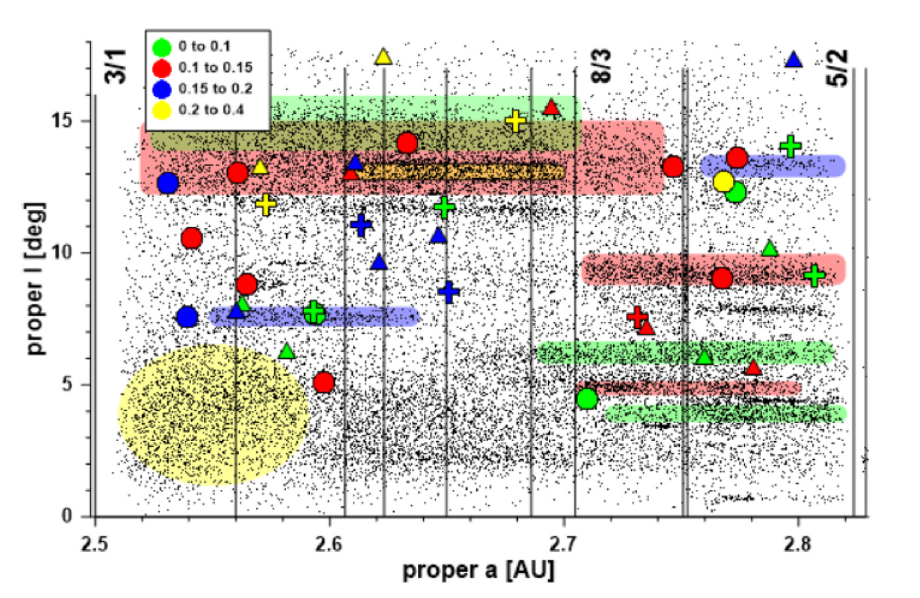
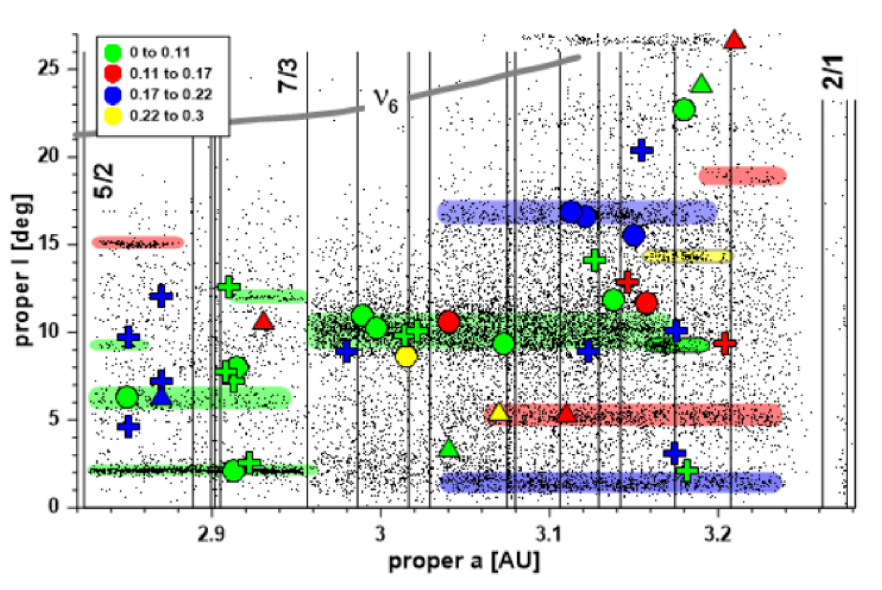
Figure 1. a-i plane of proper semimajor axis and inclination of the middle (left) and outer (right) main belt. Basaltic asteroids from Migliorini et al. (2021) are shown with circles. Some are identified as members of the asteroids families shaped with different colors, while some are locate close to these families. Some M- type and A- type asteroids, located in the same region, are also reported with crosses and triangles, respectively, for comparison.
References
De Sanctis M.C. et al. 2011, A&A, 533, A77.
Hardersen P.S. et al. 2004, Icarus, 159, 178.
Hardersen P.S. et al. 2018, AJ, 156, 11.
Ieva S. et al. 2018, MNRAS, 479, 2607.
Jasmim F.L. et al. 2013, A&A, 552, A85.
Lazzaro D. et al. 2000, Science, 288, 2033.
Leith T.B. et al. 2017, Icarus, 205, 61.
Medeiros H. et al. 2019, MNRAS, 488, 3866.
Migliorini A. et al. 2018, MNRAS, 475, 353.
Migliorini A. et al. 2021, MNRAS, 504, 2019.
Nesvorny D. et al. 2015, Asteroids IV, p. 895.
Roig F. et al. 2008, Icarus, 194, 125.
Solontoi M. et al. 2012, Icarus, 218, 571.
How to cite: Migliorini, A., Michtchenko, T., Lazzaro, D., De Sanctis, M. C., Lazzarin, M., La Forgia, F., and Morate, D.: Basaltic asteroids beyond 2.5 AU: spectral investigation of asteroid families, Europlanet Science Congress 2022, Granada, Spain, 18–23 Sep 2022, EPSC2022-318, https://doi.org/10.5194/epsc2022-318, 2022.
Vast majority of known V-type asteroids belong to the dynamical Vesta family. A small number of V-types in the mid and outer parts of the Main Asteroid Belt is considered unrelated to the fossil planetesimal (4) Vesta. These objects have low probability of dynamically evolving from the Vesta family and show spectral properties distinct from typical Vestoids [1-7]. Whether there are V-types unrelated to Vesta (non-Vestoids) in the inner part of the Main Asteroid Belt is still an open question.
To answer it, we performed a large and long-lasting observing campaign of V-types in the inner Main Belt outside the dynamical Vesta family [8,9]. We determine their rotational properties and compare them with the numerical simulations made by Nesvorny et al. 2008. According to that study 81% of objects evolving from the Vesta family to so-called Cell I (defined by orbital elements 2.2 au<a<2.3 au, 0.05<e<0.2, 0 deg <i<10 deg) and 40% to Cell II (2.32 au <a<2.48 au, 0.05<e<0.2, 2 deg<i< 6 deg) should have retrograde rotations.
We observed a total of 23 asteroids larger than 5 km in diameter in both of those Cells over multiple apparitions. We determined spins and shapes for 13 of them so far. In Cell I we found only retrograde objects and in Cell II 6 prograde and 2 retrograde objects. With the complete sample we plan to put constraints on the distribution of possible non-Vestoids in the inner Main Belt.
[1] Lazzaro, D. et al., 2000, Science 288, 2033–2035.
[2] Hardersen et al., 2004, 167, Icarus 170–177
[3] Michtchenko et al., 2002, Icarus 158, 343–359.
[4] Fulvio, D. et al, 2018, Planetary and Space Science 164, 37–43.
[5] Ieva, et al. 2016, Monthly Notices of the Royal Astronomical Society 455, 2871–2888.
[6] Ieva, S.et al., 2018, Monthly Notices of the Royal Astronomical Society 479, 2607–2614.
[7] Roig, F. et al. 2008, Icarus 194, 125–136.
[8] Oszkiewicz, D., et al., 2020, Astronomy & Astrophysics 643, A117
[9] Oszkiewicz, D. et al., 2021, Icarus 357, 114158.
[10] Nesvorný, D., et al., 2008, Icarus 193, 85–95.
How to cite: Oszkiewicz, D., Troianskyi, V., Wilawer, E., Galad, A., Marciniak, A., Skiff, B., Fohring, D., Polakis, T., Geier, S., Kwiatkowski, T., Kolenczuk, P., Moskovitz, N., Benishek, V., Pray, D., Shevchenko, V., Kankiewicz, P., and Hasegawa, S. and the SONATA-13: Spins and shapes of V-type asteroids outside the dynamical Vesta family, Europlanet Science Congress 2022, Granada, Spain, 18–23 Sep 2022, EPSC2022-340, https://doi.org/10.5194/epsc2022-340, 2022.
Near-Earth objects (NEOs) provide us with knowledge regarding the formation and evolution of our solar system. By being in close proximity to Earth, we are able to study the physical parameters of smallest asteroids down to several meters. On the flip side, some NEOs create a potential collision hazard to Earth. Such asteroids are classified as Potentially Hazardous asteroids (PHAs) based on their Earth’s MOID value and absolute magnitude.
Here we present the updated dataset of surface colors for NEOs obtained using the 1.2m telescope at the Haute-Provence Observatory (France). The ongoing survey is being carried out in the framework of the NEOROCKS (NEO Rapid Observation, Characterization, and Key Simulations) project funded by the European Union’s Horizon 2020 program. While selecting the targets, special focus was given to PHAs and objects with larger absolute magnitudes.
New observations were performed during four runs between June 2021 and January 2022. As a result, surface colors for 28 NEOs were added to the dataset published in [1], which extended our sample to 79 objects. Figure 1 shows color-color diagrams of the observed objects.
The obtained B-V, V-R, and V-I colors were used to estimate the taxonomic type. To do this we used M4AST service [2], and considered only the main taxonomic classes, such as S– (including Q-type), C-, and X-complexes, and A-, D-, V-types of the DeMeo classification [2]. The distribution of taxonomic classes is shown in Figure 2.
The majority of objects (47%) are classified into S+Q-complex, 19% are classified into X-complex, 14% are classified as both C-complex and D-type asteroids, and, finally, 3 and 4% of objects belong to V- and A-type, respectively. The found distribution is in good agreement with existing works (see, e.g [4,5,6]).
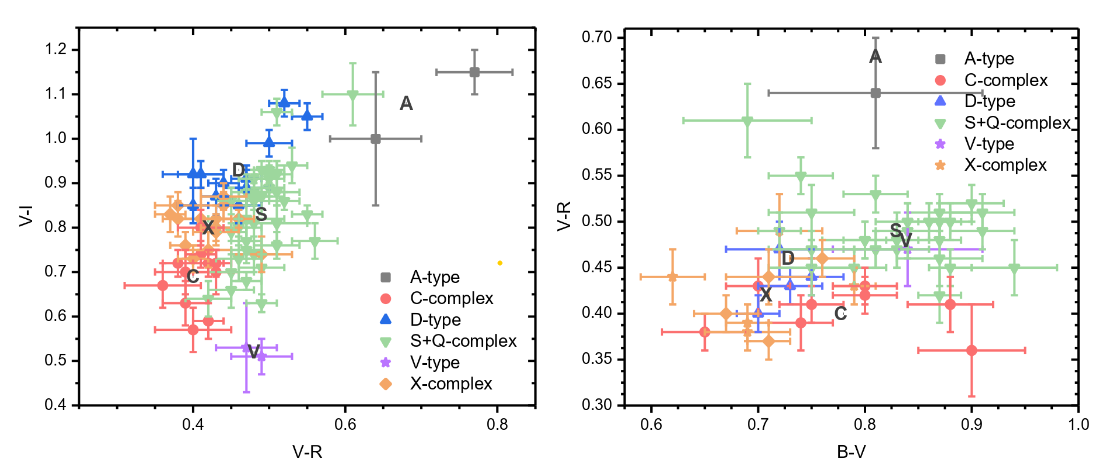
Figure 1. Color-color diagram of the 79 NEOs observed within the NEOROCKS project since November 2020.
Figure 2. Distribution of taxonomic classes in our dataset of NEOs.
References
[1] Hromakina, T., Birlan, M., Barucci, A., et al. A&A, 656, A89, 2021.
[2] Popescu, M., Birlan, M., Nedelcu, D. A&A, 544, 130, 2012.
[3] DeMeo, F., Binzel, R., Stephen M. Slivan, S., Bus, S. Icarus, 202, 160, 2009.
[4] Binzel, R. P., DeMeo, F. E., Turtelboom, E. V., et al. Icarus, 324, 41, 2019.
[5] Devogèle, M., Moskovitz, N., Thirouin, A., et al. AJ, 158, 196, 2019.
[6] Ieva, S., Dotto, E., Mazzotta Epifani, E., et al. A&A, 644, A23, 2020.
Acknowledgments. This project has received funding from the European Union’s Horizon 2020 research and innovation programme under grant agreement No 870403.
How to cite: Hromakina, T., Birlan, M., Barucci, M. A., Fulchignoni, M., Colas, F., Fornasier, S., Merlin, F., Sonka, A., Anghel, S., Perna, D., and Dotto, E. and the NEOROCKS: Updated dataset of NEOs surface colors obtained within the NEOROCKS project, Europlanet Science Congress 2022, Granada, Spain, 18–23 Sep 2022, EPSC2022-364, https://doi.org/10.5194/epsc2022-364, 2022.
On April 29th 2020, the potentially hazardous asteroid (52768) 1998 OR2 (herafter OR2) flew-by the Earth at a distance of 16.4 Lunar distances. OR2 is a near-Earth object of absolute magnitude H = 16 that can experience close approaches to Earth as close as 6 Lunar distances.
During this fly-by we obtained high SNR Arecibo S-band (2380 MHz; 12.6 cm) radar delay-Doppler images between Apr 13-23. We also obtained polarimetric observations with the ToPol polarimeter [1] mounted on the Omicron-West 1-m telescope from the Calern Observatory, Nice, France. These polarimetric observations span a range of phase angles from 30° to 77° allowing detailed characterization of the positive branch of 1998 OR2 phase-polarization curve. We also obtained new photometric observations with the Trappist-North telescope [2] located at the Oukaimeden Observatory in Morroco.
Using the radar delay-Doppler and the lightcurve observations, we derived a non-convex shape model of 1998 OR2. This model displays a typical top-shape (diamond-like) model with an equivalent diameter of 1.6 km. The spin axis solution is oriented toward 330° +- 10° of ecliptic longitude and 23° +- 10° of ecliptic latitude with a rotation period of 4.1084 +- 0.0001 hours. Top-shape asteroids are typical for near-Earth objects as it had been observed for the asteroids Bennu [3], Ryugu [4], or Moshup [5]. Radar shape modeling has already been proven to be effective in modeling these type of asteroid as the radar shape model of Bennu [3], that was obtained before the Osiris-Rex mission, proved to be highly accurate.
OR2 delay-Doppler images are characterized by the presence of a large feature visible on the leading edge of the echo. The shape model shows that this feature is a crater located near the equator. The shape model also shows that there are other craters/concavities formations mostly located on one-side of OR2 while the other side is lacking large scale structures.
The polarimetric observations of OR2 displays a phase-polarization curve typical of moderate albedo objects with a polarization of 8.3% at a phase angle of 77.5°. The degree of linear polarization (especially at large phase angles) of an asteroid is directly correlated with its albedo. At a similar phase angle, the low albedo asteroid (3200) Phaethon (pv = 0.107 +- 0.011 [6]) is displaying a polarization of 27.3% [7] while the high albedo object E-type 1998 WT24 (pv = 0.654 +- 0.13 [8]) only displays a polarization around 1.5% [9].
Polarimetric observations were also collected over several hours during the same nights in order to obtain time-series. Folding the polarimetric data according to the rotation period of OR2, we observed that the degree of linear polarization is dependant on the rotation phase angle. Such variation means that the surface of OR2 displays heterogeneities that can be either due to a variation of albedo or grain size over the surface. We also observe that the maximum of the polarization occurs when crater is facing the observer.
In conclusion, we obtained new radar, polarimetric, and photometric data of 1998 OR2 during its close approach to Earth on April 2020. These observations allowed us to obtain a non-convex shape model displaying a spin axis orientation of (330°,23°) with a rotation period of P = 4.1084 +- 0.0001 hours. The shape model displays large scale structures like concavities and craters. The polarimetric observations display variation of the polarization locked with the rotation phase angle of 1998 OR2 that seems to be correlated with the large structures observed on the shape model.
[1] Devogèle, M. et al. Monthly Notices of the Royal Astronomical Society 465, 4335–4347 (2017).
[2] Jehin, E. et al. The Messenger 145, 2–6 (2011).
[3] Nolan, M. C. et al. Icarus 226, 629–640 (2013).
[4] Watanabe, S. et al. Science 364, 268–272 (2019).
[5] Ostro, Steven. J. et al. Science 314, 1276–1280 (2006).
[6] Tedesco, E. F., Noah, P. V., Noah, M. & Price, S. D. IRAS Minor Planet Survey V6.0. NASA Planetary Data System IRAS-A-FPA-3-RDR-IMPS-V6.0 (2004).
[7] Devogèle, M. et al. Monthly Notices of the Royal Astronomical Society 479, 3498–3508 (2018).
[8] Mainzer, A. K. et al. NEOWISE Diameters and Albedos V1.0. NASA Planetary Data System EAR-A-COMPIL-5-NEOWISEDIAM-V1.0 (2016).
[9] Kiselev, N. N., et al. Proceedings of Asteroids, Comets, Meteors - ACM 2002 (2002).
How to cite: Devogele, M., Venditti, F., Marshall, S., Zambrano Marin, L., Mcgilvrey, A., Virkki, A., Bendjoya, P., Rivet, J.-P., Abe, L., Vernet, D., Jehin, E., and Ferrais, M.: Radar shape modeling and physical characterization of the PHA 1998 OR2, Europlanet Science Congress 2022, Granada, Spain, 18–23 Sep 2022, EPSC2022-600, https://doi.org/10.5194/epsc2022-600, 2022.
Introduction:
The dynamics of Solar System objects is determined by their mutual gravitational interactions. In addition, non-gravitational effects need to be taken into account to properly model the dynamics of objects smaller than about 30-40 km in diameter. For asteroids, two the most relevant effects are the Yarkovsky and Yarkovsky-O’Keefe-Radzievskii-Paddack (YORP). The Yarkovsky effect is caused by sunlight. When an asteroid is heated up by the Sun it eventually re-radiates the energy away as heat, creating a tiny thrust. This recoil acceleration is much weaker than the gravitational forces, but it can produce substantial orbital changes over long timescales. The same physical phenomenon is also responsible for the YORP effect, a thermal torque that, complemented by a torque produced by scattered sunlight, can modify the rotation rates and obliquities of small bodies as well (e.g. Bottke et al. 2006, Vokrouhlický et al. 2015). Therefore, the Yarkovsky effect changes the orbital motion of an asteroid, while the YORP effect changes its spin state. However, as the magnitude of the Yarkovsky effect depends on the spin state, the two effects are coupled. For this reason, a high-precision analysis of the orbit evolution of small objects requires both effects to be considered.
N-body integrators for small solar system objects:
The three most widely used numerical integration packages in the planetary science community are swift (Levison and Duncan 1994), mercury (Chambers and Migliorini 1997), and orbit9 (Milani and Nobili 1988) which is included in the OrbFit package. In addition to these well-established packages, rebound (Rein and Liu 2012) became a top-rated tool in the last few years. The last decade also saw a fast improvement in the performance of graphical processing units (GPUs). GPUs can efficiently handle parallel computing, and for this reason, packages such as Genga (Grimm and Stadel 2014) have been developed to exploit the advantages of this kind of hardware.
For studies of the long-term evolution of small Solar System objects, it is fundamental to add the Yarkovsky and YORP effects to the dynamical model. Implementations of these effects in publicly available N-body codes, however, are typically lacking or the effects are implemented using simplified models. In this work, we describe the implementation of the Yarkovsky/YORP effect in the mercury and orbit9 integrators (Fenucci and Novakovic 2022). Both integrators have been extensively used for simulations of the long-term orbit evolution of asteroids.
Mercury and Orbit9: implementation of Yarkovsky and YORP effects:
To implement the two effects in the mercury and orbit9 integrators we adopted the following strategy. The Yarkovsky effect is computed as a non-conservative vector field along the tangential direction that produces the semi-major axis drift given by analytical theories (e.g. Vokrouhlický 1999). For the YORP effect, we follow an approach similar to the one described in Bottke et al. (2015), which is suitable for statistical studies of the evolution of asteroids. In our code, we provide two different YORP models: a static and a stochastic one. Along with the two effects, we introduced the effect of collisions and breakups on the asteroid spin state.
Results:
An example of the results obtained with the new versions is shown in Figure 1. The figure shows the evolution of an asteroid's spin period, obliquity, and semi-major axis drift for different integrators and YORP models. The red colour corresponds to the mercury integrator, while the blue represents the orbit9 integrator. The solid curves depict the simulations performed with the static YORP model, while dotted curves are those from the stochastic YORP model.

Repositories:
The new versions of the integrators that allow for proper treatment of the non-gravitational forces are publicly available at https://github.com/Fenu24/mercury (Mercury package), and at https://github.com/Fenu24/OrbFit (Orbit9 integrator).
References:
-
Bottke, William F., J., Vokrouhlický, D., Rubincam, D. P. and Nesvorný, D. 2006, AREPS, 34, 157
-
Bottke, W. F., Vokrouhlický, D., Walsh, K. J., et al. 2015, Icarus, 247, 191
-
Chambers, J. E. and Migliorini, F. 1997, in AAS/DPS Meeting Abstracts #29, AAS/Division for Planetary Sciences Meeting Abstracts, 27.06
-
Fenucci, M., Novakovic, B. 2022, Serb. Astron. J. 204, 51–63
-
Grimm, S. L. and Stadel, J. G. 2014, ApJ, 796, 23
-
Levison, H. F. and Duncan, M. J. 1994, Icarus, 108, 18
-
Milani, A. and Nobili, A. M. 1988, Celestial Mechanics, 43, 1
-
Rein, H. and Liu, S. F. 2012, A&A, 537, A128
-
Vokrouhlický, D., Bottke, W. F., Chesley, S. R., Scheeres, D. J. and Statler, T. S. 2015, The Yarkovsky and YORP Effects (University of Arizona Press), 509–532
How to cite: Novakovic, B. and Fenucci, M.: Mercury and OrbFit packages for numerical orbit propagation: Implementation of the Yarkovsky and YORP effects, Europlanet Science Congress 2022, Granada, Spain, 18–23 Sep 2022, EPSC2022-620, https://doi.org/10.5194/epsc2022-620, 2022.
In our field of work, a wide variety of large databases are being generated from data obtained by different instruments, in different formats, on similar objects at different times or thousands of different objects over a number of years. In recent years only, catalogues of CCD optical observations from ground-based telescopes are published. Well known examples are the catalogues of moving objects from SLOAN, Gaia-DR2, K2 and several others.
In this paper we present a set of software tools that can process images from any telescope, any filter and any FITS header content. The source code of the tools is open to the scientific community using a public repository.
Those tools (OM, M2 and HENOSIS) are executed locally (no internet access required), does not include any dependence with traditional software packages (IDL, Python), store the results in a database and has been designed in Scala programming language, allowing to run them in computation clusters (with Spark Hadoop and Yarn) for massive data processing and also enabling the use of latest machine learning algorithms.
The OM tool, automatically detects relevant information of an image (telescope, filter, observing date, etc.), including the image type (i.e. science, bias, flat-field, dark). Then it performs the calibration of science images using the master flat, bias and dark previously generated. Finally, it solves the images astrometry using the Gaia-EDR3 catalogue.
The M2 tool has a set of capabilities using as input the calibrated images generated by OM:
1) Astrometry
a) It fits the image WCS to increase the accuracy
b) Manages an astrometry database with 100K images calibrated by OM
2) Photometry
a) Calculates the absolute and relative photometry of an asteroid/TNO
b) Calculates the light curve and rotational phase of an asteroid/TNO
c) Locates all Gaia-EDR3 sources present in an image and calculates its absolute and relative
photometry
d) Locates all images that contains a specific asteroid/TNO, by request
e) Locates all known asteroids/TNOs in a sequence of images
f) Using an input sequence of images, locates the groups of them with the biggest common field
of view
Finally, the HENOSIS tool, allows to cross match different catalogues (Gaia-DR2 MOC, SDSS MOC,MPC...) including the database generated by M2, obtaining as result a unique extended catalogue merging all disperse data.
Note that with point 2.c) of M2, for the Gaia stars, the G, Bp and Rp magnitudes are extracted and with them it is possible to calculate the V and R magnitudes. We then calculate and fit to a cubic polynomial and obtain the parameters from which we can obtain the asteroid/TNO magnitude in V and R filters. In this way, data from different telescopes, in different filters and with years of difference, can be compared, assuming a known V-R color for the object.
We have tested the system on images from our database of observations over 21 years, at different telescopes and observing filters and present the first results in the poster "Absolute photometry of the transneptunian dwarf planets in a long time span" done by Nicolas Morales at this same meeting.
How to cite: Morales, R., Morales, N., Duffard, R., Ortiz, J. L., Vara-Lubiano, M., Rommel, F., Kretlow, M., Santos-Sanz, P., Fernandez-Valenzuela, E., Alvarez-Candal, A., and Robles, N.: Cataloguing astronomical ground-based images of asteroids and TNOs, Europlanet Science Congress 2022, Granada, Spain, 18–23 Sep 2022, EPSC2022-652, https://doi.org/10.5194/epsc2022-652, 2022.
We report an analysis of photometric observations for two potentially hazardous asteroids – (52768) 1998 OR2 and (99942) Apophis. Data for 1998 OR2 was obtained in March – April 2020 and for Apophis in February – March 2021, when both objects experienced their close approaches to Earth. The aim of the observations was mainly to refine the physical characteristics (rotation periods, absolute magnitudes H, slope parameter G, to find out the approximate taxonomy, or even to estimate the heliocentric position of the north pole).
Observations and data reduction
The observations of both PHAs were carried out with the 0.61-m f/4.3 Newton reflector at the Skalnaté Pleso Observatory (Slovakia, IAU code 056) and CCD camera SBIG ST-10XME. We obtained photometric data using broad-band Johnson-Cousins B, V, and R filters, 2×2 binning, and a resolution of 1.07 arcsec/px. The calibration with dark and flatfield frames was applied in the standard way. Next, we used a differential aperture photometry technique to obtain lightcurves.
Results
Asteroid 1998 OR2 was observed for 9 nights. From each night we obtained 3 – 4 hr series in BVR filters, from which we determined the exact synodic rotation periods. Figure 1 shows the composite light curves with periods of 4.11 hours. We divided them into three groups to emphasize the time- and phase-angle-dependent changes in the lightcurve shape.
Data from the V filter we used to determine the absolute magnitude H, which has a value of 15.72 ± 0.02 mag (Fig. 2). We kept the slope parameter G at 0.15 because of the narrow range of phase angles. Next, we calculated the approximate effective diameters of the asteroid using an albedo value of 0.2. These varied only minimally between 2.1 and 2.3 km on each observing night, with a mean value of 2.14 ± 0.06 km.
Color photometry also allowed us to determine an approximate taxonomic class in the Tholen classification. Figure 3 shows the positions of the color indices on each night along with the mean value of the B-V and V-R indices. With high probability, the asteroid surface is dominated by a metallic material, which characterizes the X-class. Our finding is confirmed by Hromakina et al. (2021) [2].
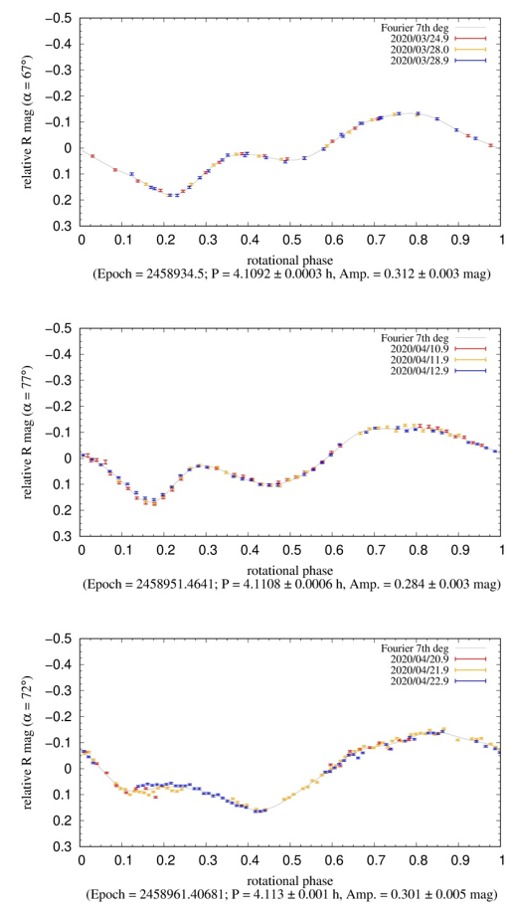
Fig. 1 Three composite lightcurves of asteroid 1998 OR2 obtained from March 24 to April 22 through the R filter. We divided them into three groups to show the changing of some features in brightness in the range of rotational phase from 0 to 0.2. All lightcurves have the same scale of relative magnitudes (y-axis) for better comparison. The typical rms of all composite lightcurves is less than 0.010 mag.
Fig. 2 Plot of magnitude-phase relation of 1998 OR2. In this case, the slope parameter G is fixed at 0.15.
Fig. 3 Color plots of V-R vs. B-V for 1998 OR2 within various Tholen taxonomic classes [1].
In the spring of 2021, perhaps the most famous asteroid, Apophis, approached the Earth. We used this time to obtain photometric material to refine the physical characteristics known so far. The aim was not to make long-term observations to determine the rotational period, as this is known, a fact complicated by the excited rotational state (tumbling). We mainly focused on finding the B-V and V-R color indices, the absolute magnitude H, and the diameter. Already after the first observations, it was clear that either the shape of the object is highly elongated or the rotation is not performed along one axis. The values of the effective diameter varied significantly from 0.31 to 0.40 km each night. We observed a similar effect when determining the absolute magnitude, which we calculated to be 19.08 ± 0.06 mag (with fixed G = 0.24).
Similarly to the previous asteroid, we used color photometry. It shows almost unequivocally that Apophis is classified as an S-type asteroid (Fig. 4). A similar finding was obtained by Hromakina et al. (2021) [2] or Lin et al. (2018) [3].
Fig. 4 Color plots of V-R vs. B-V for Apophis within various Tholen taxonomic classes [1].
References
[1] Dandy, C. L., Fitzsimmons, A., and Collander-Brown, S. J., “Optical colors of 56 near-Earth objects: trends with size and orbit”, Icarus, vol. 163, no. 2, pp. 363–373, 2003. doi:10.1016/S0019-1035(03)00087-3.
[2] Hromakina, T., “Photometric survey of 55 near-earth asteroids”, Astronomy and Astrophysics, vol. 656, 2021. doi:10.1051/0004-6361/202141600.
[3] Lin, C.-H., Ip, W.-H., Lin, Z.-Y., Cheng, Y.-C., Lin, H.-W., and Chang, C.-K., “Photometric survey and taxonomic identifications of 92 near-Earth asteroids”, Planetary and Space Science, vol. 152, pp. 116–135, 2018. doi:10.1016/j.pss.2017.12.019.
How to cite: Husárik, M. and Ivanova, O.: Photometric results of two PHAs: (52768) 1998 OR2 and (99942) Apophis, Europlanet Science Congress 2022, Granada, Spain, 18–23 Sep 2022, EPSC2022-671, https://doi.org/10.5194/epsc2022-671, 2022.
Introduction
The observation of NEOs allows us to study the physical characteristics of the smallest size bodies of our Solar System as well as to impose constraints on their origin and evolution. Considering that these objects are in unstable orbits over the age of the Solar System, this implies that it is a transient population, which can be asteroids or comets, forming a particularly interesting population to study [1,2]. Important physical properties of atmosphereless bodies can be derived from their phase curves which represent how the object’s brightness varies with the solar phase angle. These properties are based on the understanding that the physical properties of the material present on the object’s surface can be retrieved from the analysis of the scattering of the incident solar radiation. Therefore, we set up an observational campaign in order to determine the phase curve for a large number of NEOs, deriving their absolute magnitude, H, and the G1 and G2 parameters. Together, these two parameters can provide information about composition, texture, and roughness properties [3].
Observations and results
In order to obtain the physical parameters of NEOs, we set up an observational campaign since 2017 to derive phase curves of these objects. Considering all objects observed in our campaign, taken from works [4,5,6] and Arcoverde et al., (submitted), we analyzed a homogeneous dataset of 32 NEOs. The data were mainly acquired at the Astronomical Observatory of Sertão de Itaparica (Brazil), with some NEOs also observed at the Osservatorio di Campo Imperatore (Italy). Then, using data from the dual-band photometry phase curves of NEOs and MB, acquired by the Asteroid Terrestrial-impact Last Alert System Survey [7,8] telescopes, we analyzed the behavior in G1 vs G2 of 21,865 MB and 105 NEOs. The objects were separated into three bands of albedo - low, medium and high - and three bands of diameter - less than 10 km, greater than 10 km, but less than 50 km and greater than 50 km.
Analyzing the large sample of MB, we found evidence that the distribution in phase space G1 - G2 has a strong dependence not only on the albedo but also on the size of the object, as shown in figure 1. Objects with D > 10km correspond to the behavior expected [9], and occupy specific regions in the phase space according to the albedo.
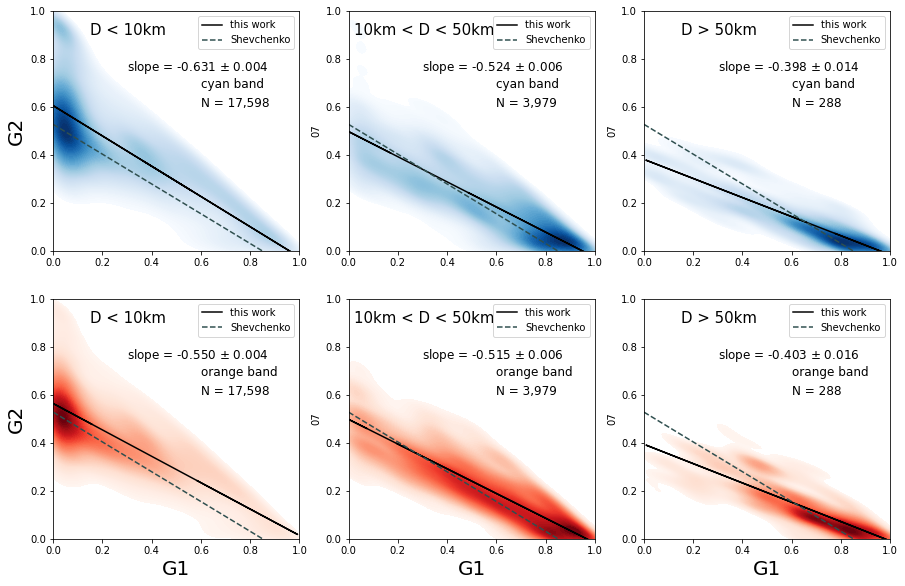
Figure 1: G1, G2-distributions for three diameter ranges of MB objects, from the ATLAS dual-band photometry asteroid phase curve catalog, observed in cyan (blue adjustment) and orange (red adjustment). The black line corresponds to the linear fit of the sample with the slop value shown, and the dashed line corresponds to the linear fit with the 93 MB of work [9], for comparison.
This size dependence on the G1 - G2 phase space is particularly true for smaller objects. As our NEOs are an even smaller population than the MB's, we cannot estimate the albedo of small objects from their phase curve parameters, as shown in Figure 2, from the distribution of our 105 NEOs in the G1 - G2 phase space. Obviously, a larger dataset of very small MB objects is needed to confirm whether the behavior mentioned above is specific to NEOs or to all very small bodies in the Solar System.
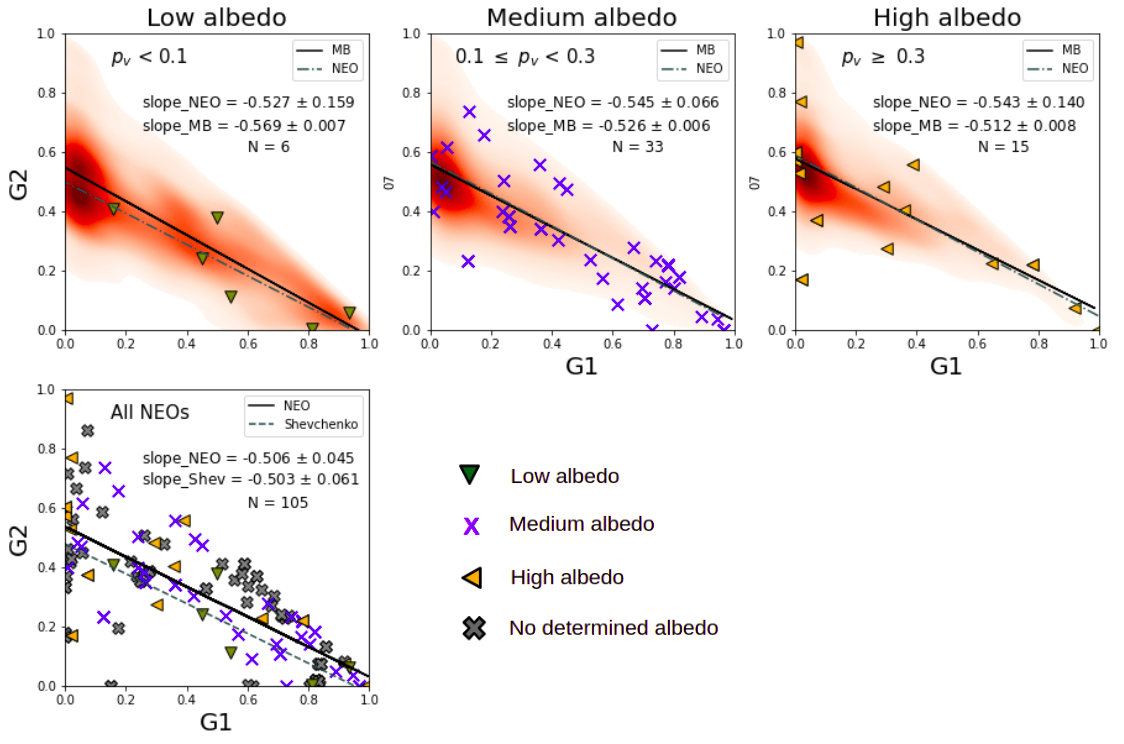
Figure 2 : G1, G2-pairs for MB 𝐷 < 10km with three albedo ranges for all NEOs with determined albedo (upper panels), and for all 105 NEO sample (bottom panel). The black line indicate the linear fits to the MB data and the dashed line indicate the linear fits to the NEO.
Acknowledgements
P.A., E.R., F.M., M.E, W.P. and J.M. would like to thank CNPq, FAPERJ and CAPES for their support through diverse fellowships. Support by CNPq (310964/2020-2) and FAPERJ (E-26/202.841/2017 and E-26/201.001/2021) is acknowledged by D.L. The authors are grateful to the IMPACTON team, in special to R. Souza, A. Santiago and J. Silva for the technical support.
References
[1] Bottke, W.F., Morbidelli, A., Jedicke, R., Petit, J.M., Levison, H.F., Michel, P., Metcalfe, T.S., 2002. . Icarus 156, 399–43.
[2] Morbidelli, A., Walsh, K.J., O’Brien, D.P., Minton, D.A., Bottke, W.F., 2015. pp. 493–507
[3] Helfenstein, P., Veverka, J., 1989. Asteroids II, University of Arizona Press, Tucson, pp. 557–593
[4] Rondón, E., Arcoverde, P., Monteiro, F., Medeiros, H., Navas, G., Lazzaro, D., Carvano, J.M., Rodrigues, T., 2019. 484, 2499–2513
[5] Rondón, E., Lazzaro, D., Carvano, J., Monteiro, F., Arcoverde, P., Evangelista, M., Michimani, J., Mesquita, W., Rodrigues, T., 2022. 372, 114723.
[6] Ieva, S., Arcoverde, P., Rondón, E., Giunta, A., Dotto, E., Lazzaro, D., Mazzotta Epifani, E., Perna, D., Fanasca, C., Rodrigues, T., Monteiro, F., Medeiros, H., Silva-Cabrera, J.S., Di Paola, A., 2022.
[7] Mahlke, M., Carry, B., Denneau, L., 2021. 354, 114094.
[8] Tonry, J.L., Denneau, L., Flewelling, H., Heinze, A.N., Onken, C.A., Smartt, S.J., Stalder, B., Weiland, H.J., Wolf, C., 2021. VizieR Online Data Catalog , J/ApJ/867/105.
[9] Shevchenko, V.G., Belskaya, I.N., Muinonen, K., Penttilä, A., Krugly, Y.N., Velichko, F.P., Chiorny, V.G., Slyusarev, I.G., Gaftonyuk, N.M., Tereschenko, I.A., 2016. . 123, 101–11
How to cite: Arcoverde, P., Rondón, E., Monteiro, F., Pereira, W., Ieva, S., Lazzaro, D., Michtchenko, T., Evangelista, M., Michimani, J., Mesquita, W., Corrêa, T., Dotto, E., Giunta, A., Di Paola, A., Medeiros, H., Carvano, J. M., and Rodrigues, T.: Physical properties of NEOs derived from their phase curves, Europlanet Science Congress 2022, Granada, Spain, 18–23 Sep 2022, EPSC2022-746, https://doi.org/10.5194/epsc2022-746, 2022.
Introduction
Asteroids lightcurves have been used extensively to derive many important physical characteristics such as rotational properties (rotational period and pole direction) and shape (Kaasalainen et al., 2004; Hanus et al., 2011; Durech et al., 2015), as well as to identify and characterize binary asteroids (Pravec et al., 2006). In addition, the rotational period and shape obtained from lightcurves can be used to estimate the internal cohesion strength required to prevent structural failure by centrifugal forces (e.g. Holsapple, 2007; Scheeres et al., 2010; Sánchez and Scheeres, 2014). Here, we will present some results of our extensive observational campaign for the physical characterization for a large sample of NEOs (Monteiro et al., 2017; Monteiro et al., 2018a,b; Rondón et al., 2019, 2020; Monteiro et al., 2020, 2021; Rondón et al., 2022; Monteiro et al., submitted).
Observations and data reduction
Photometric observations of about 150 NEOs were made at the Observatório Astronômico do Sertão de Itaparica (code Y28, OASI) of the IMPACTON project between 2012 and 2020. The images were acquired with the 1.0-m telescope using a 2048 x 2048 Apogee Alta U42 CCD camera. More details on the available instrumentation are given in Rondón et al., 2020. Lightcurve observations were carried out using sidereal tracking and an R-Johnson-Cousins filter. To obtain photometric spectra, observations were made using the g, r, i, z Sloan Digital Sky Survey (SDSS) filters. The science images were calibrated following the standard procedures, including bias, dark and flat-field images. The rotation periods were derived using a Fourier series analysis (Harris et al., 1989) while the spin direction and shape model were obtained by applying the lightcurve inversion method (Kaasalainen and Torppa, 2001; Kaasalainen et al., 2001). To investigate binary periods we used the "Dual Period Search" tool in MPO Canopus software. To obtain the photometric spectrum of some objetcs, we used standard field stars to calculate the zero-point of the night and, consequently, the calibrated magnitude of the asteroid.
Results
Reliable rotational periods and lightcurve amplitudes were determined for 88 NEOs (Monteiro et al. 2018a,b; Monteiro et al., submitted). For another 30 NEOs, only an estimate for the rotational period was obtained. The spin direction and shape model were obtained for about 15 NEOs. As an example, Fig. 1 shows the convex shape model for the NEO 2011 UW158, whose complete physical characterization was reported in Monteiro et al. (2020). These pole directions, along with those obtained from the DAMIT database (Durech et al. 2010), were used to analyze the pole distribution of the NEO population (Fig. 2). It is interesting to note that there appears to be a lack of poles toward the ecliptic plane. Clearly, a more representative sample is needed in order to derive robust conclusions.
Figure 1
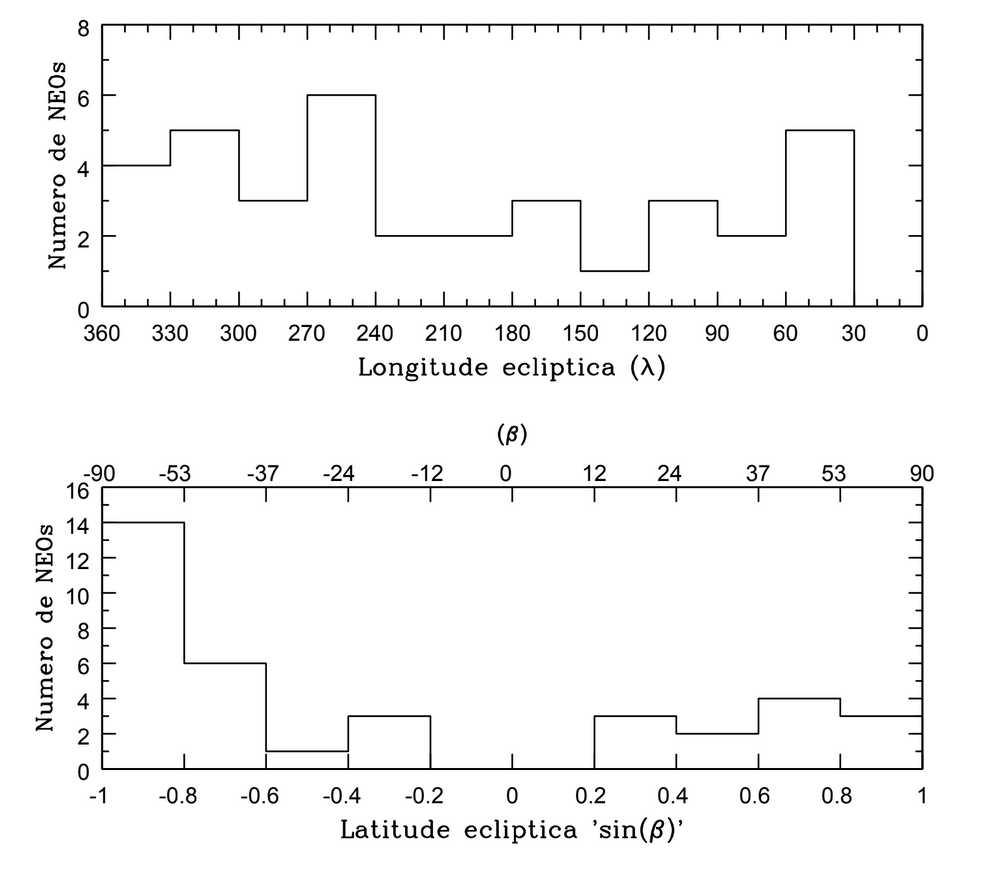
Figure 2
About 20 fast rotators in our sample were analyzed for signs of satellites. For 8 of them, binarity signatures were found in their lightcurves (Monteiro et al., submitted). Fig. 3 shows the primary and secondary lightcurves of a suspected binary showing a possible mutual observed event. For the possible binaries (138846) 2000 VJ61 and (243566) 1995 SA, we derived the minimum relative size of the components of 0.26 and 0.37, respectively. NEOs 2007 EX, 2014 KD91 and 2015 FS332 showed a secondary lightcurve, but no signs of eclipse/occultation, indicating the rotation of a possible satellite.
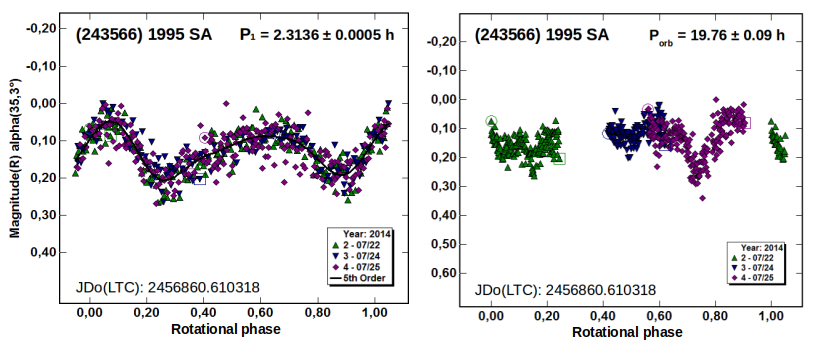
Figure 3
We found binarity signatures for 3 confirmed binaries (Monteiro et al., submitted). The NEO (31345) 1998 PG showed a secondary lightcurve, but no clear mutual events, with a period of about 16 h. The primary and secondary lightcurves of this objects is shown in Fig. 4. Finally, we estimate the internal cohesion strength required to prevent the failure of seventeen binary candidates that rotate beyond the cohesionless bodies limit. We found a minimum cohesion ranging from 3 to 90 Pa, which is in agreement with the numerical simulations reported in the literature (Sánchez and Scheeres, 2014). This analysis is included in detail in our recently submitted paper (Monteiro et al., submitted).
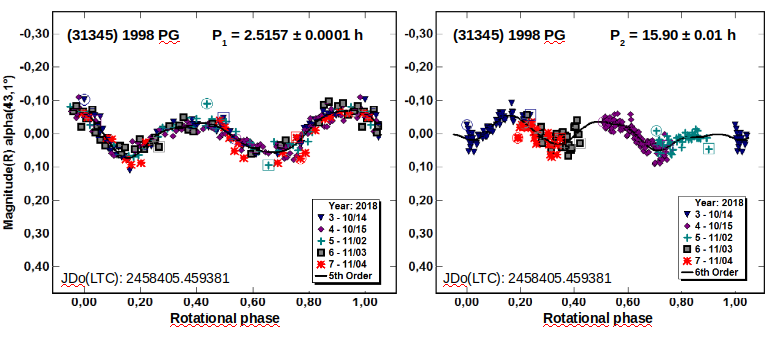
Figure 4
Conclusions
We determined a large sample of reliable lightcurves with well defined rotation period and amplitude. We derived the rotational period for about 30 PHAs and for some of them we indicated their possible taxonomic types. The derived spin direction, along with those obtained from the DAMIT database, continue to show a majority of retrograde rotators, which is consistent with a preferential transport route from the inner main belt. In addition, we identified 8 possible binary NEOs, which showed binarity signatures in their lightcurves. Finally, we showed that some fast rotators in our sample require an internal cohesion strength of 3 to 100 Pa to avoid structural failure by centrifugal forces.
Acknowledgements
F.M. thanks the financial support given by FAPERJ (E-26/201.877/2020). E.R., M.S., P.A, W.P., W.M., H.M. and T.C. would like to thank CAPES and CNPq for supporting this work through diverse fellowships. Support by CNPq (310964/2020-2) and FAPERJ (E-26/202.841/2017 and E-26/201.001/2021) is acknowledged by D.L. The authors are grateful to the IMPACTON team and, in particular, to R. Souza and A. Santiago for the technical support.
References
Durech J. et al. (2010), A&A, 513, A46.
Durech, J.,et al., 2015. Asteroids IV, pages 183-202.
Harris A. W., et al., 1989, Icarus, 77, 171.
Holsapple, K. A. (2007). Icarus, 187(2):500-509.
Kaasalainen, M. and Torppa, J. (2001). Icarus, 153:24-36.
Kaasalainen, M., Torppa, J., and Muinonen, K., 2001. Icarus, 153:37-51.
Kaasalainen, M., et al., 2004. Icarus, 167(1):178-196.
Margot J.L., et al., 2015. Asteroids IV. Pp 355–374.
Monteiro, F., et al., 2017. Minor Planet Bulletin 44, 20-22.
Monteiro, F., et al., 2018a. Minor Planet Bulletin 45, 221-224.
Monteiro, F., et al., 2018b. Planet. Space Sci. 164, 54-74.
Monteiro, F., et al., 2020. MNRAS, 495, 3990-4005.
Monteiro, F., et al., 2021. MNRAS 507, 5403–5414.
Perna, D., et al., 2016. AJ, 151(1):11.
Pravec, P., et al., 2006, icarus, 181, 63.
Rondón, E., et al., 2019. MNRAS, 484:2499–2513.
Rondón, E., et al., 2020. PASP, 132(1012):065001
Rondón, E., et al., 2022. Icarus 372, 114723.
Sánchez, P. and Scheeres, D. J., 2014. Meteoritics and Planetary Science, 49(5):788-811.
Scheeres, D. J., et al., 2010. Icarus, 210(2):968-984.
How to cite: Monteiro, F., Lazzaro, D., Rondón, E., Evangelista-Santana, M., Arcoverde, P., Pereira, W., Mesquita, W., Michimani, J., Medeiros, H., Corrêa, T., Silva-Cabrera, J., and Rodrigues, T.: Physical characterization of near-Earth objects from the IMPACTON project, Europlanet Science Congress 2022, Granada, Spain, 18–23 Sep 2022, EPSC2022-767, https://doi.org/10.5194/epsc2022-767, 2022.
Introduction
Asteroid (594913) 'Aylo'chaxnim, formerly designated as 2020 AV2, is the only one known to orbit inside Venus orbit. It was first observed by the Zwicky Transient Facility on January 4, 2020 (Bolin et al. 2020) and it may represent the largest member of a new population of small bodies with the aphelion distance smaller than 0.718 a.u., called Vatiras (Greenstreet et al. 2012). Because of its orbit, the surface of this asteroid is being constantly modified by the high temperature, by the strong solar wind irradiation that characterizes the innermost region of the Solar system, and by high-energy micrometeorite impacts. Thus, it represents an extreme case when compared with the near-Earth asteroids.
Based on the observations obtained on January 13, and 14, 2020, we found that 'Aylo'chaxnim has a wide spectral absorption band around 1 μm that represents the signature of an olivine-rich composition. The estimated absorption band center BIC = 1.08 ± 0.02 μm corresponds to a ferroan olivine mineralogy (Popescu et al. 2020 MNRAS). By comparing these spectra with the taxonomic types from Bus-DeMeo taxonomy, we found Sa types as the best fit for the (0.5 - 1.5 ) μm spectral interval. The classification as an S-complex asteroid was also reported by Bolin et al. (2020 EPSC) based on a visible spectrum obtained on January 23, 2020 with the Keck I telescope. They also reported a reddish surface with g-r=0.65 mag and r – i = 0.23 mag and i-z = 0.11 mag.
Here we report new near-infrared spectra, in the range 0.8-2.5 μm, obtained using the 3m NASA Infrared Telescope Facility (NASA IRTF). The observations were performed during August 2021, when the object was close to its maximum solar elongation of 40 deg.
Table 1. Observational circumstances for (594913) 'Aylo'chaxnim.
|
Spec. ID |
Average UT |
Average airmass |
Total exp.[sec] |
No. of exp. |
|
S1 |
2021-08-11T14:38:38 |
2.8 |
1912.7 |
16 x 120 sec |
|
S2 |
2021-08-12T14:37:21 |
2.9 |
1793.2 |
15 x 120 sec |
|
S3 |
2021-08-14T15:05:12 |
2.3 |
836.8 |
7 x 120 sec |
Observations
We used the SpeX instrument, with the PRISM mode and a slit of 0.8 x 15 arcsec. This configuration allowed us to cover the 0.82 – 2.5 μm spectral interval. The spectral images were acquired in the ABBA mode. Table 1 shows the observation log for the three sets of data. The object was observable at an air-mass of ~2.5-3 for about 30 min before the start of the morning twilight. We noticed a wide apparent magnitude variation between the nights.
In order to obtain the reflectance spectrum, the asteroid’s observed spectral data must be divided by that of a solar analog. We could observe only one solar analog, a G2V star, namely GSC 01881-01236, which was the best suited for our work in terms of apparent vicinity and time constraints. The data reduction was performed with the Spextool package (Cushing et al. 2004).
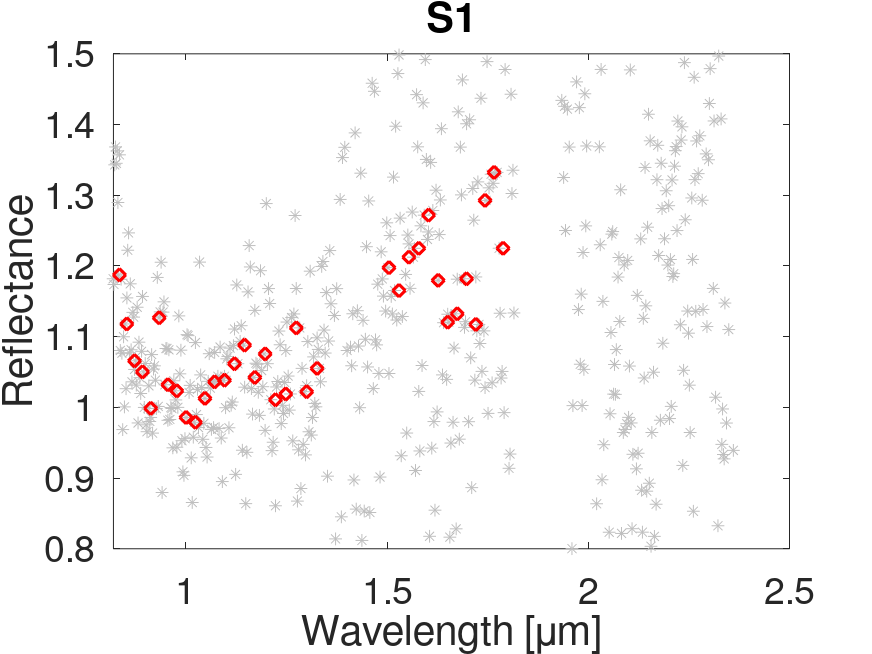
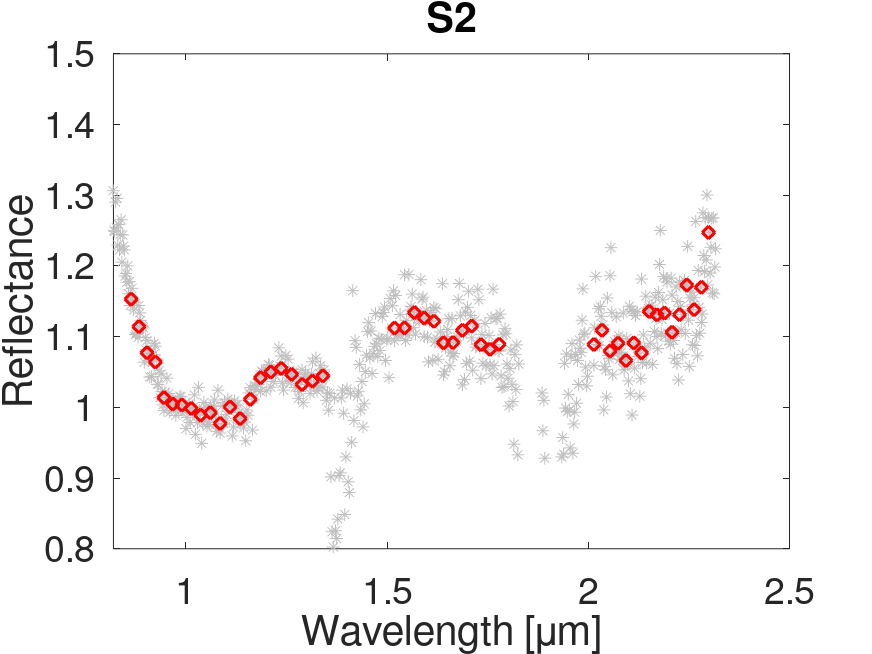
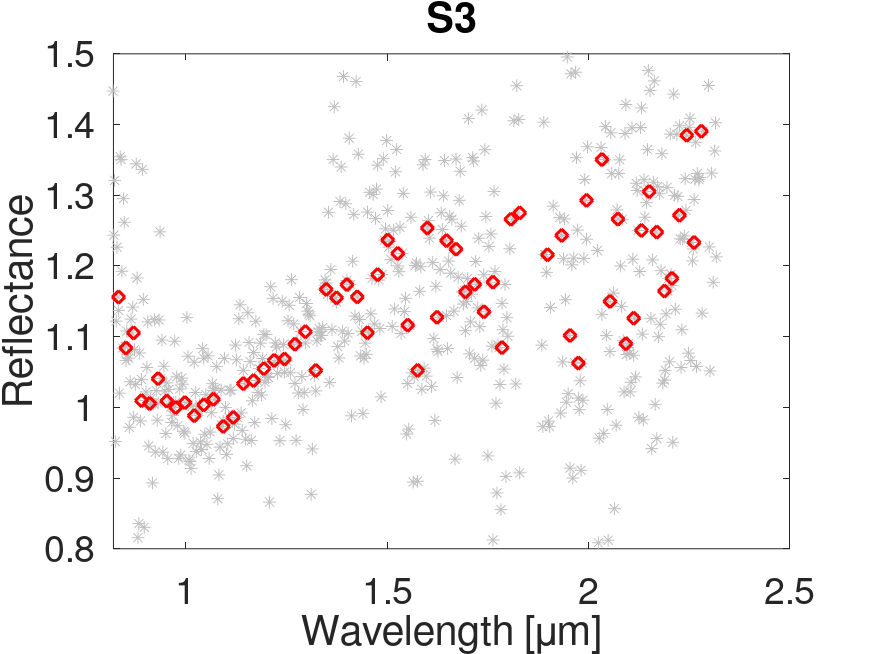
Fig.1 The spectral data obtained with IRTF/SpeX during August 2021 for (594913) 'Aylo'chaxnim. The gray points represent the data obtained as provided by Spextool (the pipeline used to reduce the spectral images). The red points were obtained by binning every 9 points from the original data (the gray ones). The observational details associated with S1, S2, S3 are described in Table 1. The data are normalized at 1 μm.
Results
The spectra obtained during the three nights are identical up to 1.3 μm. They also match the spectrum obtained in 2020 (Fig. 2). The S1 and S3 spectra are redder compared with S2, for wavelengths longer than 1.3 μm. A thermal tail is identifiable for S2.
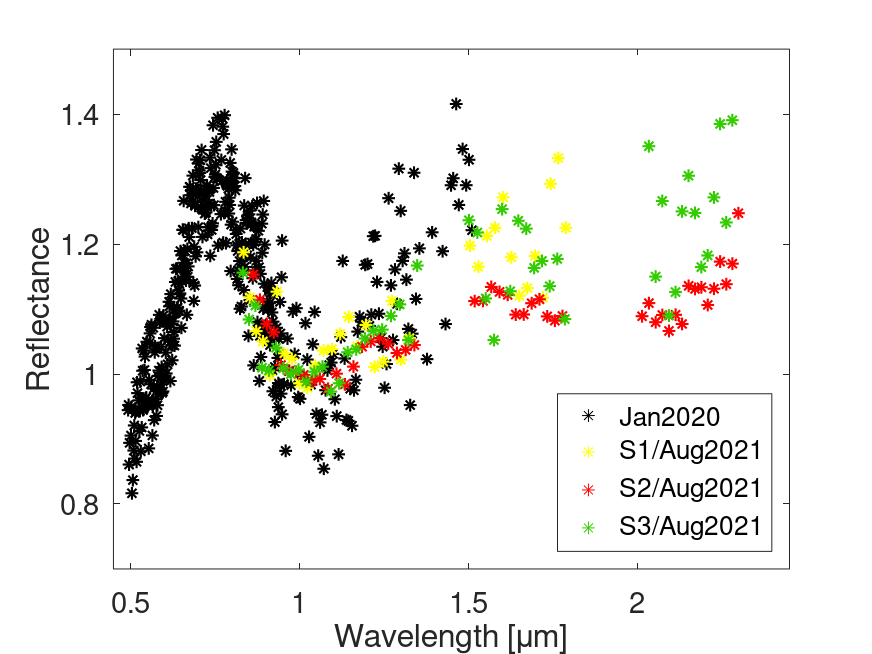
Fig. 2 Comparison between the spectra obtained during January 2020 (Popescu et al. 2020), and those obtained during August 2021. All spectra are normalized to 1 μm.
The absorption band minima (BImin) is located at 1.07 +/- 0.015 μm for S2, and 1.09 +/-0.02 μm for S3 (we did not compute this band center for S1 due to its large error-bars). This result is consistent with the olivine rich composition proposed based on the 2020 observations. The S2, which has the best signal to noise ratio, shows a possible feature at 1.25-1.30 μm, which can also be attributed to olivine.
We used the S2 spectrum for comparison with the RELAB spectral database . Its shape is best matched by the CK meteorites (Cloutis et al. 2021). These are characterized by an olivine associated absorption band in the 1.05 μm region. Compared to pure olivine, CK spectra are darker, have a more subdued olivine absorption band, and are often more blue-sloped (Cloutis et al. 2012).
References
1. Bolin et al. 2020 , Minor Planet Electronic Circ., No. 2020-A99 (2020)
2. Bolin et al. 2020, the 14th Europlanet Science Congress 2020, abstract id. EPSC2020-482
3. Cloutis et al. 2012, Icarus, Volume 221, Issue 2, p. 911-924
4. Greenstreet S., Ngo H., Gladman B., 2012, Icarus, 217, 355
5. Popescu et al. 2020, MNRAS, Volume 496, Issue 3, pp. 3572-3581
Acknowledgments
The work of MP was supported by a grant of the Romanian National Authority for Scientific Research – UEFISCDI, project number PN-III-P1-1.1- TE-2019-1504. The work of MP, JdL, JL, is made in the framework of EU-funded project ”NEOROCKS - The NEO Rapid Observation, Characterization and Key Simulations project”, SU-SPACE-23-SEC-2019 from the Horizon 2020 - Work Programme 2018-2020, under grant agreement No 870403. The abstract make use of data published by the Relab Spectral Database
How to cite: Popescu, M., de la Fuente Marcos, C., Văduvescu, O., de la Fuente Marcos, R., Bus, S., de León, J., Licandro, J., Tatsumi, E., and Simion, G. N.: New near-infrared spectra of (594913) 'Aylo'chaxnim, the first known asteroid orbiting inside Venus orbit, Europlanet Science Congress 2022, Granada, Spain, 18–23 Sep 2022, EPSC2022-804, https://doi.org/10.5194/epsc2022-804, 2022.
Basaltic V-type asteroids are the leftovers from the formation and evolution of the differentiated planetesimals. They are thought to originate from mantles of multiple different parent bodies. Identifying the links between individual V-type asteroids and multiple planetesimals is challenging, especially in the inner part of the Main Asteroid Belt where the majority of V-type asteroid is expected to originate from a fossil planetesimal (4) Vesta.
We perform a 2Gy numerical integration of orbits of the selected V-type asteroids. For each asteroid we use 1001 clones to estimate the orbital uncertainties. In the integration we use information on physical properties of the considered V-type asteroids such as pole orientation, rotational period and thermal parameters. This may confirm the hypothesis that the number of differentiated basaltic objects in the Main Belt should be much higher than previously assumed. We show results for the ~25 V-type asteroids outside the dynamical Vesta family in the Main Asteroid Belt.
How to cite: Troianskyi, V., Kankiewicz, P., and Oszkiewicz, D.: Dynamical evolution of basaltic asteroids outside the dynamical Vesta family, Europlanet Science Congress 2022, Granada, Spain, 18–23 Sep 2022, EPSC2022-888, https://doi.org/10.5194/epsc2022-888, 2022.
How to cite: Tan, H. and Durech, J.: Models and physical properties of asteroids from optical and infrared data, Europlanet Science Congress 2022, Granada, Spain, 18–23 Sep 2022, EPSC2022-958, https://doi.org/10.5194/epsc2022-958, 2022.
INTRODUCTION
Barbarian asteroids are a group of objects belonging to the inner part of the Main Belt. It consists mainly of L-type asteroids based on SMASS spectra [1]. Barbarians have an outstanding anomalous polarimetric behaviour, which was first observed for (234) Barbara (hence the name of the whole group). It serves as a prototype of Barbarians and demonstrates a wide negative branch of the polarisation phase curve [2]. Other members of this group show similar features. One of them – asteroid (599) Luisa – has specific to this group parameters of the polarisation phase curve αmin=14.7°, Pmin= –1.68%, αinv= 29.2° [3]. However, it appears to have atypically low-albedo, pv=0.11 [4], in comparison to other L-type asteroids, which have albedo around 0.20.
Since the polarimetric phase curves are often connected to magnitude phase curves, we decided to derive such a relation for a number of Barbarians. Here we report the preliminary results for (599) Luisa based only on the data collected with one telescope. Final results, derived with the whole data set, will be presented at the conference.
OBSERVATIONS & REDUCTION
We observed (599) Luisa during its 2021 opposition with the 0.7-m Roman Baranowski Telescope (RBT/PST2) at Winer Observatory in Arizona (IAU code 648). During the time from 7 March to 12 Jun the asteroid was visible at the solar phase angles from 9.48 deg, through 3.68 deg to 17.86 deg. Some phase angles were observed before and after opposition. All CCD frames were exposed in the Johnson R filter. Aperture photometry was performed by using the Photometry Pipeline (PP) software package [5]. Results were calibrated with the solar analogue stars taken from the PanSTARRS DR1 catalogue.
RESULTS
A composite lightcurve, including all data, is presented in Fig. 1. It was obtained with the synodic period of P=9.5639 hours (the average for the whole opposition) by a standard Fourier series fit procedure. The composite lightcurve was used to correct partial lightcurves (which did not cover all rotation phases) to the same level of maximum brightness. The magnitudes of maxima of brightness from different nights were then plotted against the phase angle producing a mag-phase curve (Fig. 2).
Three different phase functions were fitted to the data: the (H,G), (H,G1,G2), and (H, G12) relations. As can be seen, the (H,G12) function does not fit the data well while the other two display good agreement. In Fig. 3 we compare the obtained G1, G2 parameters with the reference set obtained by Shevchenko et al. (2016) for 127 Main Belt asteroids. The preliminary result obtained for (599) Luisa is not statistically different from the rest of asteroids (note the big 1-sigma vertical uncertainty) . However, this can change if the remaining data are added to the fit. The final results will be presented at the conference.
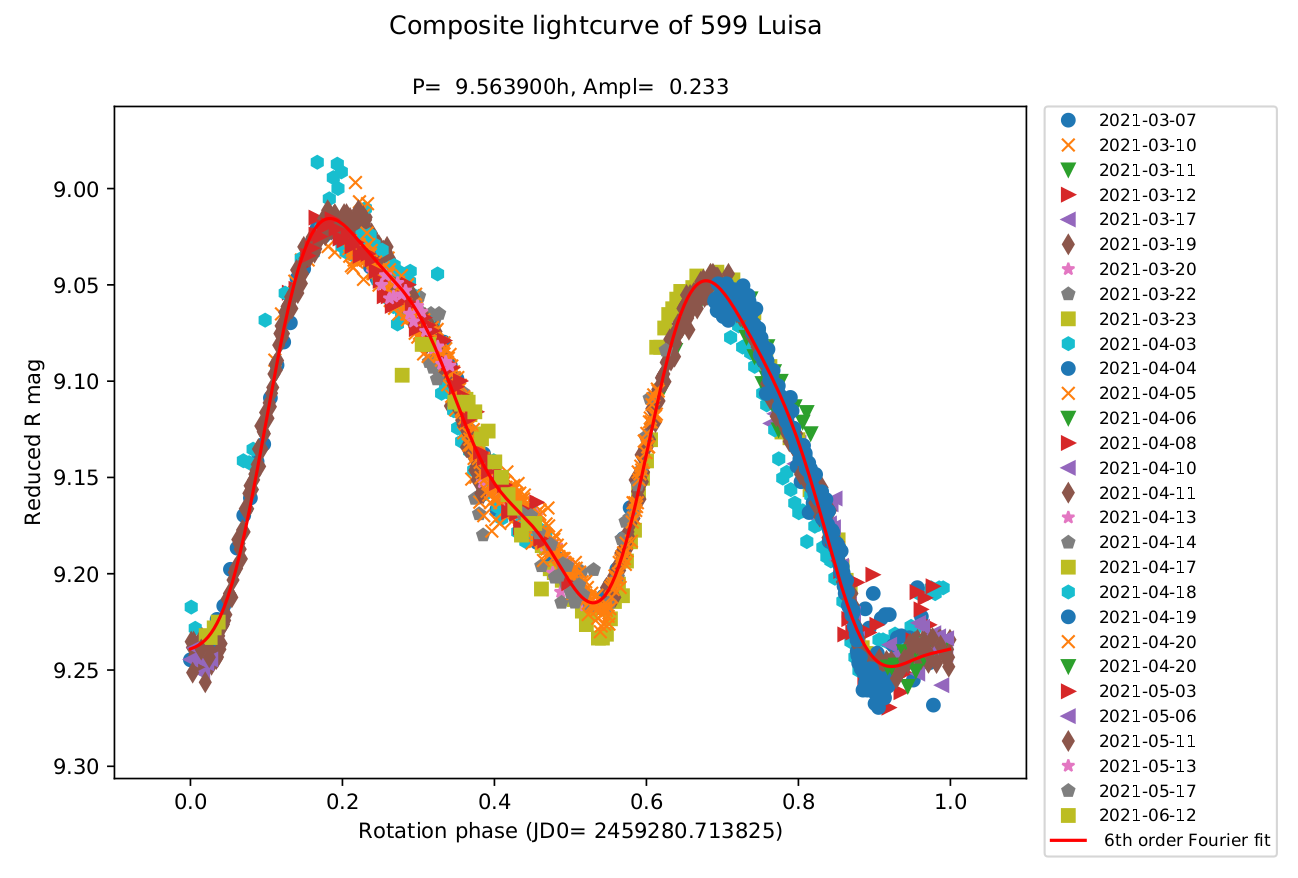
Fig 1. Composite lightcurve of (599) Luisa made from all observations. The synodical period of P=9.5639 is an average from the period of three months. The R magnitude, reduced to unit distances from the asteroid and Sun, refers to the first night. The rest of the lightcurves have been shifted vertically to fit the first data set.
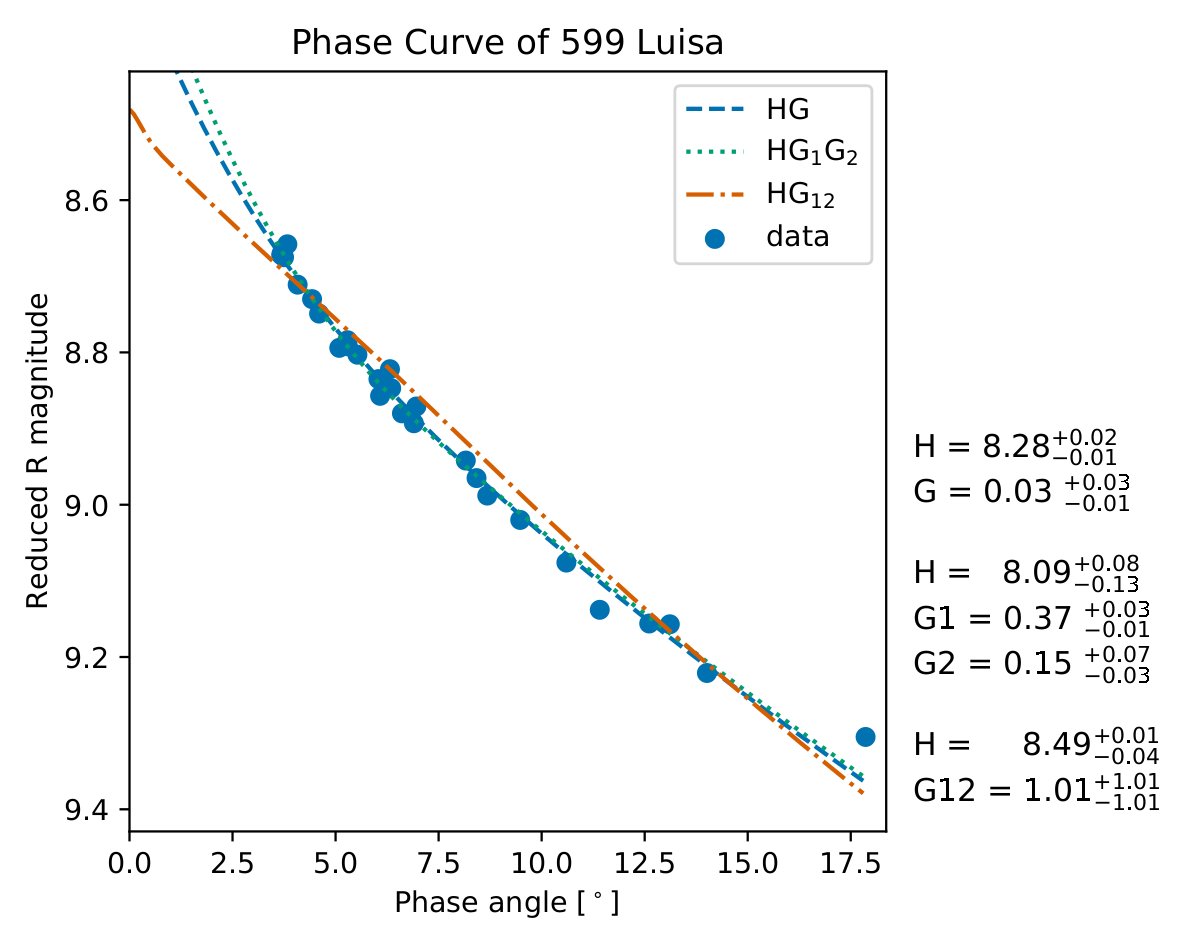
Fig 2. A preliminary magnitude-phase curve of (599) Luisa with three phase functions fitted to the data.
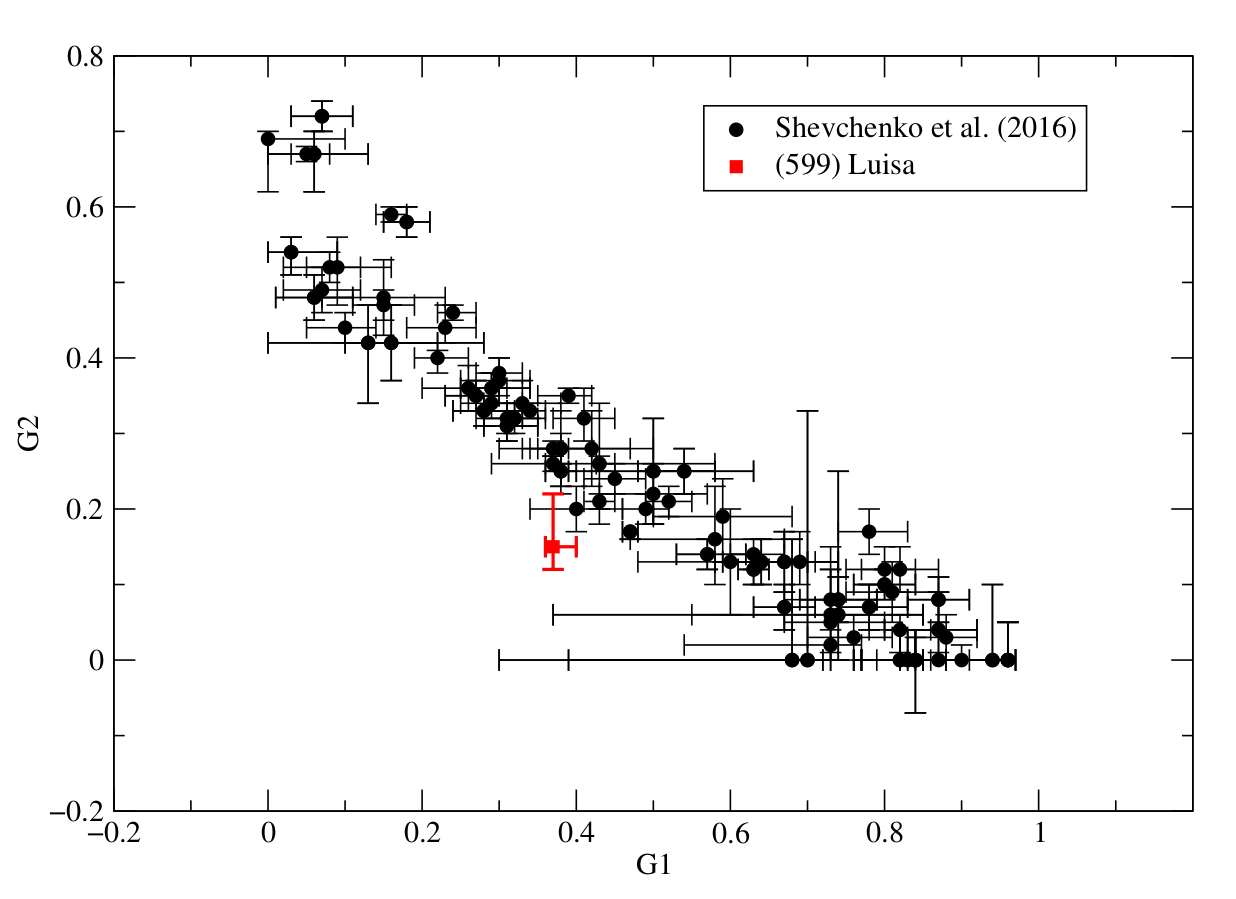
Fig. 3. A comparison of the preliminary G1,G2 coefficients of Luisa with the most accurate values obtained for other Main Belt asteroids by Shevchenko et al. (2016). The error bars denote the 1-sigma uncertainties. Their values are different because the underlying model of statistical uncertainties is not symmetric.
ACKNOWLEDGMENT
Sofiia Mykhailova is grateful to Adam Mickiewicz University in Poznań for offering her an internship.
Tomasz Kwiatkowski acknowledges support from the grant No. 2017/25/B/ST9/00740 from the National Science Centre, Poland.
REFERENCE
1) Bus, S. J., & Binzel, R. P. (2002). Phase II of the small main-belt asteroid spectroscopic survey: A feature-based taxonomy. Icarus, 158(1), 146-177.
2) Cellino, A., Belskaya, I. N., Bendjoya, P., Di Martino, M., Gil-Hutton, R., Muinonen, K., & Tedesco, E. F. (2006). The strange polarimetric behavior of Asteroid (234) Barbara. Icarus, 180(2), 565-567.
3) Lupishko, D. F., Kiselev, N. N., & Karpov, N. V. (2020). Polarimetry of the Asteroid (599) Luisa: a New Barbarian. Solar System Research, 54(1), 44-48.
4) Mainzer, A. K., Bauer, J. M., Cutri, R. M., Grav, T., Kramer, E. A., Masiero, J. R., ... & Wright, E. L. (2019). NEOWISE diameters and albedos V2. 0. NASA Planetary Data System.
5) Mommert, M. (2017). PHOTOMETRYPIPELINE: An automated pipeline for calibrated photometry. Astronomy and Computing, 18, 47-53.
6) Shevchenko, V. G., Belskaya, I. N., Muinonen, K., Penttilä, A., Krugly, Y. N., Velichko, F. P., ... & Tereschenko, I. A. (2016). Asteroid observations at low phase angles. IV. Average parameters for the new H, G1, G2 magnitude system. Planetary and Space Science, 123, 101-116.
How to cite: Mykhailova, S., Kwiatkowski, T., and Kamiński, K.: Magnitude-phase curve of (599) Luisa, a Barbarian asteroid, Europlanet Science Congress 2022, Granada, Spain, 18–23 Sep 2022, EPSC2022-959, https://doi.org/10.5194/epsc2022-959, 2022.
Introduction
The asteroid (4660) Nereus is considered one of the most accessible targets for a rendez-vous space mission. It was proposed as a possible target for the NASA Near-Earth Asteroid Rendezvous (NEAR) and for JAXA Hayabusa spacecraft.
The lightcurve analysis and the radar shape modeling revealed a long rotational period of ≅ 15.16 ± 0.04 h [1, 2]. The radar [2] and thermal [3] observations report optical albedo values of 0.54 (-0.09, +0.03) and 0.55 ± 0.17 respectively. Coupled with the featureless spectrum [4], Nereus is classified as an E-type object in the Tholen taxonomy. This class has been associated with enstatite achondrite meteorites.
During the fall of 2020 and the beginning of 2021, (4660) Nereus made a favorable apparition for observations with ground-based telescopes. It had an apparent magnitude brighter than 18.5 V mag. for about 7 months. The peak brightness was 12.9 on the night of December 7. In this context, we performed an extended characterization using various telescopes. Thus, we report light-curves, spectro-photometric data and spectral observations for Nereus.
Observations
We obtain the light curve of (4660) Nereus using the T025-BD4SB, a 0.25 m aperture telescope located at the Bucharest Astronomical Institute , Romania. About 65 hours of observations were obtained during 8 nights spread between October 27 and November 25, 2021. These data were acquired using the QHY294M CMOS camera.
The color indices in the visible region were determined using the MuSCAT2 instrument of the 1.52 m Telescopio Carlos Sanchez (TCS) located in Tenerife, Spain. This instrument allows simultaneous images with the broad band filters g (0.40 - 0.55 μm), r (0.550 - 0.70 μm), i (0.70 - 0.82 μm), and zs (0.82 - 0.92 μm). As such, we gathered 15.2 hours of data during six nights of observations spread over October 02, 2021 until April 02, 2022.
Additional photometry data was obtained using the 2.54 m Isaac Newton Telescope (La Palma, Spain) equipped with Wide Field Camera (WFC). We obtained 6 hrs of photometric observations using the B, V, R Johnson filters, and the r and z SDSS filters during the nights of March 2, and April 18, 2022.
The spectrum in the near-infrared region was obtained using the 3.58m Galileo National Telescope (La Palma, Spain). We used the near-infrared camera spectrometer (NICS) with the AMICI prism and a a.5 arcsec slit-width. The configuration allowed a resolving power of R=50 and a spectral interval coverage of 0.8 - 2.45 μm.
The photometric data reduction has been made using the Photometry Pipeline [5]. We also used IRAF and MP0 Canopus to cross-check the results. The spectral data was reduced using a dedicated pipeline written in Python.
Results
First we performed a photometric analysis of the asteroid (4660) Nereus. We determined its period using the Lomb-Scargle Periodogram and we investigated the YORP effect on the asteroid. Subsequently, we obtained the object's phase curve and we computed its absolute magnitude (H) and the slope parameter (G). Then we determined its color indices and we used them for classification. Finally, we reviewed its taxonomic classification based on the new acquired spectrum.
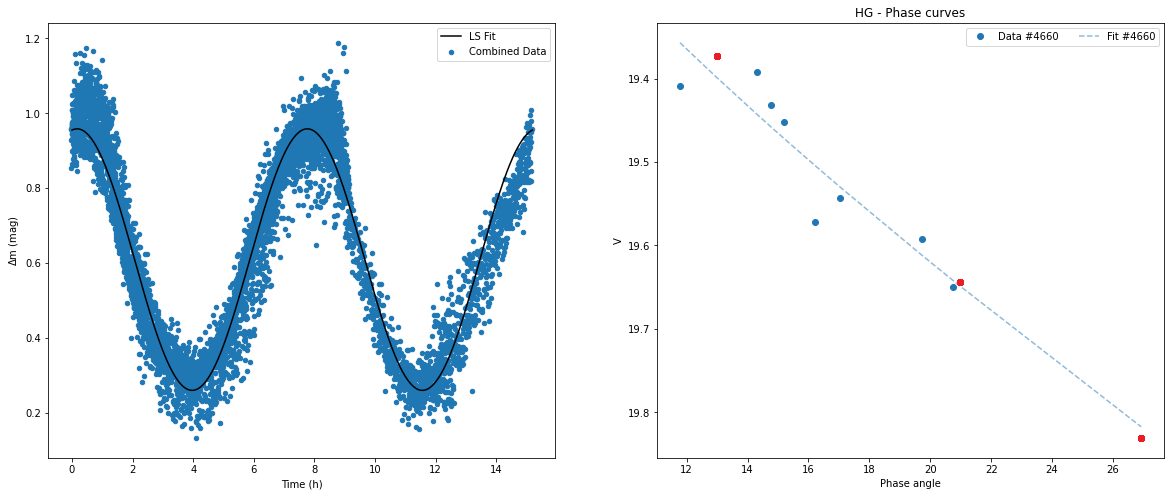
Fig 1: Left: The folded lightcurve of (4660) Nereus obtained by combining
the data from T025-BD4SB and TCS. Right: Phase curve of (4660) Nereus. The
red points are TCS observations while the blue ones are T025-BD4SB. The
dotted line represents the H-G model fit.
The Lomb-Scargle periodogram peaks at a value of 15.19 hrs. The light-curve corresponding to this period is plotted in Fig. 1. This value is in the range reported by [1] determined a period of 15.1 ± 1.2 h. It is also compatible with the value obtained using radar data [2] of 15.16 ± 0.04 h.
Because of its size, (4660) Nereus is subjected to the YORP effect which affects the asteroid's spin rate. We estimate a change of one to four seconds for its rotation period in a range of 10 years. Unfortunately, the previous values for its rotation period have much larger uncertainties. As such, another favorable observing window is needed to quantify this effect.
Furthermore, we determine the phase curve of the asteroid in order to obtain its absolute magnitude. In order to do this, we use the Pyedra software [6]. The algorithm allowed us to use the H-G model [7] in order to fit our phase curve (Fig. 1). We obtained the absolute magnitude (H = 18.69 ± 0.18) and the slope parameter (G = 0.209 ± 0.06). In Fig. 1 we show our results. For comparison, [8] reported a value of 18.58 ± 0.06.
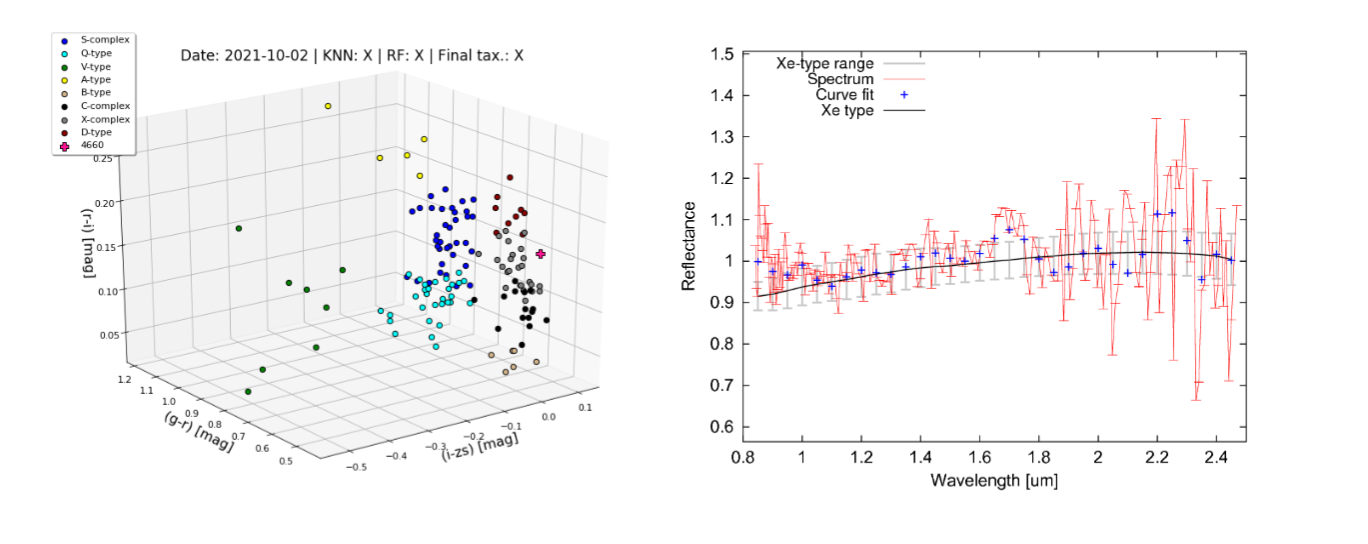
Fig 2: Left: The color-color diagram of (4660) Nereus compared with the reference data-set (Popescu et al. 2022 - paper in preparation). Right: The near-infrared spectrum of (4660) Nereus and its taxonomic classification.
The TCS/MuSCAT2 instrument allowed us to simultaneously obtain the light-curve in all four filters. We found (g-r) = 0.537 ± 0.048, (r-i) = 0.145 ± 0.012, (i-zs) = 0.091 ± 0.017. In addition to these values, we obtained the (B-R) = 1.15 ± 0.05 mag, and ± = 0.043 ± 0.03 mag color indices.
The average color values obtained with TCS/MuSCAT2 are compatible with an X-complex classification (Fig. 2). This result complements the spectral classification based on the data obtained with TNG/NICs instrument. The spectrum shown in Fig. 2 is compatible with the Xe type.
Acknowledgments
The work of MP and RMG was supported by a grant of the Romanian National Authority for Scientific Research -- UEFISCDI, project number PN-III-P1-1.1-TE-2019-1504. The work of MP, JdL, JL, and DM is made in the framework of EU-funded project "NEOROCKS project", SU-SPACE-23-SEC-2019 from the Horizon 2020 - Work Programme 2018-2020. The observations were obtained trough the EURONEAR collaboration.
[1] Y. Ishibashi et al, 2000, Earth, Planets and Space
[2] Marina Brozovic et al, 2009, Icarus
[3] Marco Delb ́o et al, 2003, Icarus
[4] Richard P. Binzel et al, 2004, Asteroids II
[5] M. Mommert, 2017, Astronomy and Computing
[6] M. Colazo et al, 2022, Astronomy and Computing
[7] Edward Bowell et al, 1989, Asteroids II
[8] Y. Ishibashi et al, 2000, Advances in Space Research
How to cite: Mansour, J. A., Popescu, M., de León, J., Berteșteanu, D., Morate, D., Văduvescu, O., Licandro, J., Dumitru, B. A., Simion, G. N., Gherase, R. M., Pinter, V., and Tatsumi, E.: Physical characterization of asteroid (4660) Nereus, Europlanet Science Congress 2022, Granada, Spain, 18–23 Sep 2022, EPSC2022-984, https://doi.org/10.5194/epsc2022-984, 2022.
The aim of this project is to derive reference phase functions and their parameters using data from the ATLAS survey. The reference phase function corrects for the observation geometry by removing the influence of the asteroid shape by normalizing it to a sphere. (Muinonen et al. 2020)
The ATLAS survey performed photometric observations in two filters: cyan (420-650 nm) and orange (560 - 820 nm) for over 180 000 asteroids at phase angles even below 1 deg (Heinze et al. 2018). Mahlke et al. (2021) derived over 1270 000 phase curve parameters using the ATLAS photometry, but they were corresponding to different viewing geometries, so they cannot be directly compared with each other.
Traditional phase curves are derived based on lightcurve brightness maximum (or mean) values at a given phase angle. When using sparse photometry (e.g., Gaia, ATLAS), the observational geometry can substantially change between observations and objects. As a result, it is challenging to compare phase curves obtained for different asteroids (even if they were observed at the same epoch). If enough photometry is available, one can account for brightness changes due to shape, rotation, and aspect changes by moving to a reference phase function, which can be directly compared with the phase functions of other objects. (Muinonen et al. 2020, Martikainen et al. 2021, Wilawer et al. 2022)
We derive the reference phase functions for ~2750 asteroids with models derived by Ďurech et al. (2020) using ATLAS photometric data. As a result, for each object, we will derive two reference phase functions: one for each ATLAS filter.
This work has been supported by grant No. 2017/25/B/ST9/00740 from the National Science Centre, Poland.
References
Ďurech, J., J. Tonry, N. Erasmus, L. Denneau, A. N. Heinze, H. Flewelling, and R. Vanco. ‘Asteroid Models Reconstructed from ATLAS Photometry’. Astronomy & Astrophysics 643 (November 2020): A59. https://doi.org/10.1051/0004-6361/202037729.
Heinze, A. N., J. L. Tonry, L. Denneau, H. Flewelling, B. Stalder, A. Rest, K. W. Smith, S. J. Smartt, and H. Weiland. ‘A First Catalog of Variable Stars Measured by the Asteroid Terrestrial-Impact Last Alert System (ATLAS)’. The Astronomical Journal 156, no. 5 (November 2018): 241. https://doi.org/10.3847/1538-3881/aae47f.
Mahlke, Max, Benoit Carry, and Larry Denneau. ‘Asteroid Phase Curves from ATLAS Dual-Band Photometry’. Icarus 354 (January 2021): 114094. https://doi.org/10.1016/j.icarus.2020.114094.
Martikainen, J., K. Muinonen, A. Penttilä, A. Cellino, and X.-B. Wang. ‘Asteroid Absolute Magnitudes and Phase Curve Parameters from Gaia Photometry’. Astronomy & Astrophysics 649 (May 2021): A98. https://doi.org/10.1051/0004-6361/202039796.
Muinonen, K., J. Torppa, X.-B. Wang, A. Cellino, and A. Penttilä. ‘Asteroid Lightcurve Inversion with Bayesian Inference’. Astronomy & Astrophysics 642 (October 2020): A138. https://doi.org/10.1051/0004-6361/202038036.
Wilawer, E, D Oszkiewicz, A Kryszczyńska, A Marciniak, V Shevchenko, I Belskaya, T Kwiatkowski, et al. ‘Asteroid Phase Curves Using Sparse Gaia DR2 Data and Differential Dense Light Curves’. Monthly Notices of the Royal Astronomical Society 513, no. 3 (May 2022): 3242–51. https://doi.org/10.1093/mnras/stac1008.
How to cite: Wilawer, E., Oszkiewicz, D., Kryszczyńska, A., Muinonen, K., MacLennan, E., and Uvarova, E.: Asteroid reference phase functions from the ATLAS photometry, Europlanet Science Congress 2022, Granada, Spain, 18–23 Sep 2022, EPSC2022-1000, https://doi.org/10.5194/epsc2022-1000, 2022.
Introduction: NEOROCKS is an EU project funded in the framework of the H2020 programme. The aim of NEOROCKS is to improve our knowledge of the physical properties of Near Earth Objects (NEOs) in order to understand their nature and the potential hazard they pose to human beings. A special attention is given to the timely detection and characterization of small potential imminent impactors of the Earth, which are likely to represent the next real threat.
The project:
The knowledge of the physical properties of a NEO has strong implications for both science and impact mitigation. To date, only 20% of the known NEO population has been characterized, 30% considering only objects larger than 1 km. NEOROCKS proposes an innovative approach to the study of NEOs, taking into consideration the incoming operation of the next generation sky surveys (encompassing wide-field high-sensitivity telescopes) which will dramatically change the NEO discovery scenario.
The NEOROCKS innovative approach is focused on:
a) performing high-quality physical observations and related data reduction processes;
b) investigating the strong relationship between the orbit determination of newly discovered objects and the quick execution of follow-up observations in order to face the threat posed by the "imminent impactors";
c) profiting of the European industrial expertise in on-going Space Situational Awareness initiatives to plan and execute breakthrough experiments foreseeing the remote tasking of highly automatized robotic telescopes, in order to provide a proof-of-concept rapid-response system;
d) guarantee extremely high standards in the data dissemination through the development of a highly sophisticated data model and the involvement at agency level of a data center facility already operating in a European and international context.
NEOROCKS introduces novel methods for orbit determination and for the prioritization of follow-up observations, for future operational NEO hazard monitoring systems. Speeding up the process from discovery to physical follow-up, will be fundamental in the next future for addressing the "imminent impactors" threat, since small objects in route of collision with the Earth are likely to be routinely discovered by the new generation NEO sky surveys. A real-time telescope tasking experiment has been also performed in the framework of NEOROCKS, as a test case scenario with the potential to scale up to a global level.
International scenario: The NEOROCKS team includes Universities, research centers, the Italian Space Sgency and industrial partnerships actively participating to the European projects devoted to Space Situational Awareness.. The goal of this activity is to probe the engagement of European and international partners in a proactive contribution to the detection of NEO potential threats, as well as to the planning and implementation of effective mitigation measures in a highly synergic and complementary scenario.
Moreover, NEOROCKS sets up necessary infrastructure to store, maintain and disseminate data produced and tools developed, well beyond the nominal lifetime of the project, thus granting the continuation of its approach and the update of its results. This is achieved through partnership with the ASI Space Science Data Centre (SSDC https://www.ssdc.asi.it/), which is equipped with necessary HW/SW environment. NEOROCKS has the potential to perpetuate the developed approach and the obtained results, through the in-kind contribution of the ASI-SSDC in hosting the project products.
The possibility of profiting from a well-established facility devoted to science data exploitation after the project is finished ensures a high-level dissemination toward the scientific and technological communities involved in NEO research as well as to the public at large.
Ackowledgement: This project has received funding from the European Union's Horizon 2020 research and innovation programme under grant agreement No 870403.
How to cite: Ieva, S. and the the NEOROCKS team: “NEO Rapid Observation, Characterization and Key Simulations project”: the EU funded NEOROCKS project, Europlanet Science Congress 2022, Granada, Spain, 18–23 Sep 2022, EPSC2022-1036, https://doi.org/10.5194/epsc2022-1036, 2022.
The Herschel Space Observatory observed with its PACS and SPIRE instruments a diverse selection of astronomical objects, including Solar System objects (SSOs), either in dedicated measurements or serendipitously. The infrared observations of asteroids helped scientists to determine their physical and thermal properties. In addition, PACS and SPIRE observations of selected large asteroids were used for a wide range of calibration aspects. Due to their strong thermal emission, SSOs may sporadically also contaminate the photometric measurements of other sources. Racero et al. (2022) presented ESASky tools to find these moving targets in Herschel data products. As a first step, we focused on the flux extraction of these serendipitous observations of SSOs in Herschel/PACS measurements at 70, 100 and 160 μm. We obtain far-infrared photometry on the PACS maps, either by extracting the flux densities from the existing standard data products, or via re-reducing the PACS maps in the co-moving frame of the target. Based on these scientifically very important far-IR flux densities, in combination with already published IR detections (Szak ́ats et al., 2020), we perform radiometric studies to determine the objects’ physical and thermal properties with unprecedented accuracy.
A natural continuation of our current work is the extension to SPIRE maps at 250, 350, and 500 μm, with a two-fold aim. First, to find serendipitous asteroids, extract new submm flux densities and flag sources in the SPIRE Point Source Catalog (Schulz et al., 2018) for possible contamination. In addition, the dedicated SPIRE observations of asteroids for various calibration activities are not yet published. As the SPIRE absolute photometry is connected to planet models, these asteroid flux densities are of great value and will put strong constraints on their submm emissivity properties. All SPIRE asteroid measurements were reprocessed and calibrated with the latest pipeline. The final maps are then used to extract high quality IR/submm flux densities. The flux densities are then added to the publicly available SBNAF Infrared Database (Szakáts et al., 2020).
We collected the Herschel/SPIRE targeted asteroid measurements, and we went through the list of SPIRE observations with potential serendipitous asteroid detections (from Racero et al. 2022). We only considered those, where the isvisible flag was ’true’. In a first step we verified that the photometry via the point source calibrated maps and the SSO calibrated maps are in agreement. This is important because all the dedicated measurements were reprocessed in the object co-moving frame and made available in the Herschel Science Archive, but not the serendipitous ones. Our tests confirmed that the two maps give the same flux densities within the error bars, so there is no need to reprocess the serendipitous maps into the co-moving frame. In a second part of the project, after making all flux densities available in the IR database, we perform radiometric
studies for individual asteroids. Depending on the a priori knowledge for a given object, we distinguish between the following five categories: (1) mission targets, well-known/-studied objects; (2) objects with good-quality spin-shape solution and multi-epoch/-mission thermal measurements; (3) good-quality spin-shape solution, but very limited or no thermal measurements available; (4) no good-quality spin-shape solution, but sufficient multi-epoch/-mission thermal measurements available; (5)
no spin-shape solution and very limited thermal measurements available. In each of these five categories, the SPIRE (and PACS) flux densities are important to obtain the object’s emissivity properties, to constrain the thermal properties of the surface or to establish basic radiometric size-albedo solutions.
We will present an overview of the new far-IR and sub-mm measurements (for about 17 dedicated program asteroids and several different main-belt asteroids), the extracted flux densities, and applications for the different categories.

Figure 1: The SPIRE maps for asteroid (10) Hygiea at 250, 350, and 500 μm, taken from a dedicated calibration sequence, and processed in the object’s co-moving frame.

Figure 2: The SPIRE maps of the serendipitously seen asteroid (464) Megaira (marked by the green circles) at 250, 350, and 500 μm.
How to cite: Szakáts, R., Kiss, C., Müller, T., and Valtchanov, I.: Herschel/SPIRE photometry of targeted and serendipitously observed asteroids, Europlanet Science Congress 2022, Granada, Spain, 18–23 Sep 2022, EPSC2022-1060, https://doi.org/10.5194/epsc2022-1060, 2022.
This presentation will show results of the observing campaign for the very small, super-fast rotating NEA, 2022 AB. It is a follow-up of our previous work on another similar object, 2021 DW1 (Kwiatkowski et al. 2021). The main objective of this project is to use lightcurves observed during one apparition along the long arc in the sky to derive NEA spin axes. They are then used to compute object obliquities to test the end states of the YORP evolution, which according to some theories should be close to 0 or 180 deg.
After the discovery of 2022 AB on 2 January 2022 it became known that it would be observable from many different viewing/illumination geometries while maintaining a decent magnitude V<19 mag. The absolute magnitude of 2022 AB, H=23.6 (reported by the MPC) suggested that it could be a super-fast rotating asteroid (rotation period P<2.1 hours), with a diameter D<150~m. The small size of this object means that its rotation can be strongly influenced by YORP.
We observed 2022 AB photometrically from 4 Jan to 26 Jan, from 27 locations around the world, from Australia, through South Korea, Europe, the United States, to Hawaii. The telescope sizes ranged from 0.28-m to 10.0-m. During that time we collected 89 lightcurves exposed through different filters. The analysis of such rich data sets is time consuming and, until now, we only have some partial results. The object has a synodical period of rotation of 182 seconds, and most likely belongs to the Cb taxonomic class (see a poster by Koleńczuk et al. at this conference for details).
At the conference, we will present full physical characterisation of 2022 AB, including its spin axis, shape, mag-phase curve, taxonomy, and size. We will discuss the obliquity of its rotation axis in the context of YORP evolution.
Acknowledgements
PK acknowledges support from the National Science Centre, Poland, Grant No. 2021/41/N/ST9/04259.
References
T. Kwiatkowski, P. Koleńczuk, A. Kryszczyńska, D. Oszkiewicz, K. Kamiński, M. K. Kamińska, V. Troianskyi, B. Skiff, N. Moskowitz, V. Kashuba, M.-J. Kim, T. Kim, S. Mottola, T. Santana-Ros, T. Kluwak, L. Buzzi, P. Bacci, P. Birtwhistle, R. Miles, and J. Chatelain (2021), Photometry and model of near-Earth asteroid 2021 DW1 from one apparition, A&A 656, A126
How to cite: Kwiatkowski, T., Koleńczuk, P., Mykhailova, S., Kamińska, M., Kamiński, K., Troianskyi, V., Kryszczyńska, A., Oszkiewicz, D., and Wilawer, E.: Photometry and model of near-Earth asteroid 2022 AB from one apparition, Europlanet Science Congress 2022, Granada, Spain, 18–23 Sep 2022, EPSC2022-1073, https://doi.org/10.5194/epsc2022-1073, 2022.
The Transiting Exoplanet Survey Satellite (TESS) produces a series of large field-of-view images with a size of 96x24 degress using a cadence of 10 minutes. Even when these field-of-views do not cover directly the ecliptic, thousands of asteroids are available for good quality photometry on a monthly basis. In this poster, we display the structure of the multi-stage pipeline designed to extract precise and accurate photometry from asteroids in an effective manner. The corresponding technical aspects include but not limited to the layout of the backend storage system, staging storages, data product indexing, memory utilization, metadata handling, intermediate products for shift & stack and efficient object querying implementation via SQL. Outputs of these pipeline stages are employed many presentations of this conference as perts of the early second data release.
How to cite: Pál, A.: Technical aspects of extracting millions of asteroids from TESS: data processing and pipeline structures at the flow of 4 terabytes/month., Europlanet Science Congress 2022, Granada, Spain, 18–23 Sep 2022, EPSC2022-1226, https://doi.org/10.5194/epsc2022-1226, 2022.
Please decide on your access
Please use the buttons below to download the presentation materials or to visit the external website where the presentation is linked. Regarding the external link, please note that Copernicus Meetings cannot accept any liability for the content and the website you will visit.
Forward to presentation link
You are going to open an external link to the presentation as indicated by the authors. Copernicus Meetings cannot accept any liability for the content and the website you will visit.
We are sorry, but presentations are only available for users who registered for the conference. Thank you.
Please decide on your access
Please use the buttons below to download the presentation materials or to visit the external website where the presentation is linked. Regarding the external link, please note that Copernicus Meetings cannot accept any liability for the content and the website you will visit.
Forward to session asset
You are going to open an external link to the asset as indicated by the session. Copernicus Meetings cannot accept any liability for the content and the website you will visit.
We are sorry, but presentations are only available for users who registered for the conference. Thank you.
